The National Railway Museum of Delhi
If you’re looking for something different to do in Delhi, check out the National Railway Museum. This open air train yard is stuffed full of engines, exhibits, turntables and carriages and is a great day out or adults and children alike! Read our guide for all the information you need for visiting this train filled wonderland.
Nestled in the southwest of India’s capital city of Delhi is the National Railway Museum. Housing an incredible collection of trains, carriages, station fixtures and historical memorabilia, the museum chronicles the amazing, turbulent and inspiring history of India massive railway network. This is our guide to getting the most out of the National Railway Museum of Delhi, even if you are not a train person!
India is criss-crossed from north to south, west to east with a vast railway network that covers the entire country. From the tropical backwaters of Kerala in the very south, to the Himalayan peaks high up in the north, India’s train network is a marvel of engineering. The railways are a circuit board wiring through the country; firing people, produce and ideas across the enormous Indian subcontinent.
At some point travelling through this massive country, you’re bound to find yourself on this huge railway network. What better way is there to learn about the history of India’s trains than a visit to the National Railway Museum in Delhi?
Disclosure: This article may contain affiliate links. We will earn a small commission from any purchases made through these links.
Where is the National Railway Museum?
The National Railway Museum is located here, in the southwest of Delhi near Nehru Park and Safdarjung’s Tomb.
If you are visiting the National Railway Museum do not miss out on the nearby Safdarjung’s tomb. This magnificent Mughal mausoleum is known as the “mini-Taj Mahal” and is 100% worth visiting. Make sure you check out our guide here.
The easiest way to get to the National Railway Museum is by rickshaw. We always recommend using a ride hailing app like Uber or Ola to avoid annoying price negotiations or being scammed. We paid 78 rupees (under £1.00) for the 4 kilometre ride from our hostel in Mohammadpur, south Delhi.
You will need a Sim card with mobile data to use ride hailing apps. If you would like to arrange your SIM card in advance of landing in India, why not check out the eSIM packages available on Airalo. Just make sure you install the App and eSIM before getting into the country!
For those wanting to travel to the railway museum by public transport, the nearest train station is Delhi Safdarjung. Once you have arrived at the station the museum is a twenty minute walk, or a very quick rickshaw drive away.
The nearest Metro to the National Railway Museum is Sir M. Vishweshwaraiah Moti Bagh on the Pink line. The metro is, like the train station, twenty minutes walk away but there are always plenty of rickshaws outside the Metro stations.
Ticket prices at the National Railway Museum
We paid 100 rupees (£0.95 or $1.25) each for entry to the museum.
Museum opening times
The National Railway Museum is open every day except Monday. The opening hours are between 10am and 4:30pm.
Holidays and festivals may affect these times so double check if you are visiting on a festival day!
Our day visiting the National Railway Museum
We are not really “train people”, we like them as much as the next person (provided the next person is not this guy), but have no special interest in them. We have found during our travels that train museums tend to be a lot of fun and a great way into the history of a country. This is especially true if that country used to be under the yoke of the British. The development of railways as colonial tools and their repurposing after independence as national infrastructure always tells an interesting story.
After days spent in the busy Red Fort and crowded alleys of Chandni Chowk we felt like a quiet afternoon poking around a train yard would be just the ticket (ba-dum-tish), so we set off to get our geek on.
Delhi’s National Railway Museum is a fantastic jumble of trains, carriages, signals and all manner of other railway infrastructure. Set across 11 acres it is full to the brim of exhibits and things to do. There are soooo many train carriages, cars and engines to look at, the map of the museum shows 80 artifacts scattered across the grounds.
The museum is mainly outside (for obvious reasons), with a huge train yard full of exhibits leading away from the entrance. We decided to start our afternoon of train based geekery in the museums indoor exhibitions, which are housed in a nicely air conditioned building at the rear of the rail yard (near the entrance / exit).
The indoor exhibitions are the most traditionally “museumy” part of the National Railway Museum. The displays are full of cutaway models, explanations of how things work and interactive dioramas. This all sounds very dry but it was done in an engaging way and we happily wandered around the exhibits, flitting between things that caught our attention. One such attention grabber was a display showing the most impressive marvels of mountain railway engineering to be found in India.
The north of India borders the Himalayas and the railways that climb up into these regions have to be very specialised. They also have to run through some absolutely jaw-dropping scenery. It was here in this exhibit we decided we needed to travel to Shimla by the Himalayan Queen railway, so you know it left an impact!
Outside, in the main rail yard of the museum, we bounced between massive steam trains, tiny hand operated rail carts, princely state trains and modern diesel locomotives. If you are into your trains this would be a sweet shop full of wonders. The rail yard is centred around several huge railway turntables. We were blown away with just how large these railway lazy-susans had to be!
The star of the show has to be the engines, they come in every shape and size, from sleek and elegant to brutal and blocky. The best part (at least for some overgrown children amongst us) was that you can get in and walk about in nearly every exhibit. You can walk through the old first class carriages or, more importantly, clamber up into the driver's seat of the enormous old steam locomotives!
We do not know nearly enough about trains to have got the most out of what we were seeing but it was great fun climbing into and around these gigantic engineering masterpieces. It is worth pointing out that there are some exhibits in need of some love. Towards the back of the park is what once must have been, an amazing model railway. Replica stations, tracks and landmarks spread over a huge diorama this model must have been fantastic in its prime. To put it mildly, it has seen better days, but we hope it will be restored to its former glory someday! Even with the occasional run down exhibit, the museum is still in great shape and it is amazing to see so many historical trains so well preserved and cared for.
The Railway Museum would also make a great trip out with kids in Delhi, there are lots of children focused displays, Engines to climb in and pretend to drive and even a miniature railway to ride!
There is a restaurant in the centre of the museum's rail yard, set high above one of the turn tables. There are also a couple of snack shops and toilets scattered through the museum.
Conclusion
The National Railway Museum of India is a great morning or afternoon out. It is something different to do in the Indian capital if you have had your fill of ancient sites, busy markets and hectic streets. We found it to be a relaxed and fun way to learn about the enormous Indian rail system and its turbulent history.
Thanks for reading,
John & Ellie x
#adventuresofjellie
Indian Railways - Booking Tickets
If you’ve enjoyed reading about the Indian Rail network and want to take a ride on this vast train network, then make sure you book your tickets well in advance of your planned date of departure.
Train tickets sell out extremely quickly in India and depending on the length of your journey, you almost certainly won’t want to spend 15 plus hours sharing a carriage with half of Rajasthan in general class!
To book tickets online and in advance, we’d recommend using 12Go. Click here to book your tickets!
Check out our other railway articles!
If you’re found this blog helpful, entertaining or you just fancy supporting us, please click the button below!
If you’ve enjoyed reading this article, why not save the pin below?
The Lodhi Garden And Khan Market - An Escape From Delhi’s Busy Streets
Delhi is a hectic city and sometimes you need a green escape or a strong cup of coffee. Read our guide to the beautiful Lodhi Gardens and the nearby Khan Market. The gardens are full of tranquil lawns, ancient monuments and quiet nooks and the Khan Market will cater for all of your coffee, fashion or sweet treat needs. A trip here is the perfect escape in India’s busy capital.
Disclosure: This article may contain affiliate links. We will earn a small commission from any purchases made through these links.
Delhi is a chaotic capital, its old town jam packed with people, produce, rickshaws and stalls not to mention the occasional wandering bovine. Delhi can really grind you down, its constant thrum of activity, noise, smell and heat can be overwhelming. Delhi however has a softer side, it is a surprisingly green city once you get out of the old town, full of beautiful manicured parks and leafy suburbs. If you are looking for a more calm day out in Delhi then we would recommend the Lodhi Garden and nearby Khan Market.
What is the Lodhi Garden?
The Lodhi Garden is a beautiful landscaped park full of ancient tombs and ruins. It has exercise machines, running tracks, walking paths, gardens and lawns. It is a true oasis of greenery and calm, a tranquil place to relax and unwind in the Indian capital.
History of the Lodhi Garden
Lodhi Garden is a comparatively recent (at least in terms of India’s vast history) addition to Delhi. The area, ruins and tombs were once dotted around the village Khairpur on the periphery of New Delhi. The area was cleared and the people moved in the 1930’s and the park was built connecting the ruins together and planting native trees and flowers. This being the era of British rule, the park was originally named Lady Willingdon Park after the then Viceroy’s wife. As India threw off the shackles of Empire and gained Independence the parks name was changed to the Lodhi Garden
The name Lodhi comes from one of the dynasties whose tombs are found in the gardens, there are others from the Mughal and Sayyid rulers. The tombs of the garden are amazing, huge structures fantastically preserved and open to the public.
It is one of the things that never gets old or ceases to surprise in Delhi, you can just be walking through a public park, or backstreet and be confronted by a beautiful ancient monument. There is history scattered everywhere in the Indian capital.
Please note that, like so many things translated out of a non-roman alphabet, there are multiple spellings of Lodhi. The two most common are “Lodhi” and Lodi”. In this article we are using Lodhi for the garden / park and Lodi for the Sultan whose name it bears. Confusing we know but whoever said India was simple!
Visiting the Lodhi Garden
The Lodhi Garden is the perfect antidote if you have overdosed on city chaos in Delhi. We came here a few times across our three visits to the Indian capital and it always succeeded in being a calming reset after the hubbub and frenetic pace of the city outside.
We would recommend just wandering (we usually do) around the park randomly, it is the best way to have the area surprise you! Wherever you arrive from, north south east or west, you will enter the park not far from one of the ancient buildings.
To the north you have the eponymous Tomb of Sikandar Lodi. This incredibly octagonal tomb is (according to the internet at least) the earliest example of a garden tomb in India. It is an amazing structure set within a courtyard and, like everything in the Lodhi Garden, free to enter and explore.
In the centre of the park is the Sheesh Gumbad (also spelt Shish or Shisha depending on who is writing). Rising up out of the park’s central green lawns this massive tomb/mosque is impossible to miss. The giant domed cube building seems out of place, like a rock in a green ocean, it is strange to think of it being surrounded by buildings and a village in the past.
Inside the building is huge with the decorated domed ceiling towering above. The arched openings on each of the four sides frame different views of the park and are very popular with selfie-taking locals (and tourists!). The whole of the park is ridiculously photogenic and a very popular spot for Indian wedding photoshoots. This in turn makes it a great people watching location!
Just to the south of the Sheesh Gumbad is the Bada Gumbad (or Bara Gumbad, why does everything have 3 spellings….). Literally translating to “Big Dome” the Bada Gumbad lives up to its name. With a similar style to the Sheesh Gumbad, this massive square building is thought to be one of, or even the, earliest full domed building in Delhi. Its exact purpose is unclear, it shares a form with the Sheesh Gumbad tomb but no tomb has been uncovered. One theory is that it is possibly an ornate entrance to…
The Jama Masjid, or Friday Mosque that sits next to and joined with the Bada Gumbad. This mosque and ancient pavilion are beautifully preserved with amazing islamic carvings and a very photogenic avenue of columns!
The arches and columns of the mosque are intricately decorated with stunning calligraphy and geometric designs.
At the southern end of the park is the oldest tomb, the Tomb of Muhammed Shah. This is another incredible octagonal tomb ringed by a covered walkway. Again it is beautiful corner of the park to quietly spend a minute in the company of history.
Throughout the park there are many more structures and ruins, with old walls, mosques and other tombs scattered around. The Lodhi Garden is a great place just to have a wander around. There are also dedicated yoga lawns, if that is your thing, as well as rose gardens, herb gardens and exercise machines (if you are some kind of masochist who likes working out in the 34 degree heat). In the trees above and skittering across the lawns are all manner of birds, chipmunks and squirrels. You will frequently see one of Delhi’s large eagle populations spiralling overhead. You can wander around the parklands, take selfies with ancient ruins and relax on manicured lawns, all within the heart of one of the busiest cities on earth!
The Lodhi Garden is a fantastic place to cool off from the pace of Delhi, it can get busy but it is large enough that we never felt crowded there.
Tips for visiting the Lodhi Garden
How to get to Lodhi Garden
Like most things in Delhi the easiest way to get to the Lodhi Garden is by rickshaw. If you have an Indian SIM card, Uber works very well in the capital and is a very cheap way to get around. You can also easily flag down a rickshaw from the street just be wary to set a price first and keep your wits about you to avoid any rickshaw scams . We would recommend using Uber or Ola as you don't need to negotiate and can see the route you are taking to your destination, this stops most of the common scams before they start. If you haven’t got an Indian SIM, have a look at our guide here.
If you would like to arrange your SIM card in advance of landing in India, why not check out the eSIM packages available on Airalo. Just make sure you install the SIM and app before you land in India.
The nearest metro stations to the Lodhi Garden are Jorbagh on the Yellow line and Khan Market on the Violet line. Both will require a little walk to reach the Lodhi Garden with Jorbagh being the closer of the two (12 minutes walk vs 15 minutes).
How much does it cost to visit the Lodhi Garden?
Nothing, Zilch, Nada. Once you have made your way there it is a free public park. All the monuments are open and there are no entrance costs or ticket barriers to walk around and admire the tombs and ruins! It is a very budget friendly destination.
How long should I spend at the Lodhi Garden?
We hate this question as there is no right answer. Google states you can walk from one end of the park to the other in 20 minutes but this is nowhere near enough time to explore the park properly. We spent well over an hour and sometimes over two on most of our visits to Lodhi gardens but you could easily spend longer if you wanted to relax on the lawns and take a break from the city, maybe even bring a picnic?
Are there toilets at Lodhi Garden?
Yes and they are clean and well maintained. Ellie has tested and approves!
Is there food and drink at Lodhi Garden?
There is no “official” food and drink at the gardens but there are ice cream, chat, snack and drink vendors at every entrance to the park. There are also wandering chat sellers within the park. They are a sight to see, balancing huge pots of lentils and fried goods on their heads before setting up a temporary shop on their spindally portable tripods! The gardens are also nearby to Khan Market (see later on) which has plenty of upmarket food options.
If you are being frugal, do as the locals do and pack a picnic. Just make sure you don't leave any rubbish as the park was pristine when we visited!
What else is there to do after the Lodhi Garden?
There are stacks of things to do in the Indian capital. The Lodhi gardens is located just between the incredible Safdarjung Tomb and the Khan Market. These three together would make a great day out in Delhi. Check out our experience at Safdarjung’s Tomb here .
The Khan Market
If you are looking for an upscale lunch, posh coffee or even an artisan cake after exploring the Lodhi gardens, then the Khan Market has you covered. This high end district is stuffed full of designer brand clothes stores, jewellers and electronics. The Khan Market also boasts many luxurious restaurants offering everything from high end takes on traditional street food to wood fired pizza. If you have been missing some of the luxuries of home (or just really want a good pizza) then the Khan Market can help. In the evening the area comes alive with cocktail lounges and bars where monied Delhiities come out to unwind. It is not a very budget friendly area but sometimes you do just need to treat yourself! We enjoyed some excellent coffees and pastries in the Khan Market after a day out at Safdarjung’s Tomb and the Lodhi Gardens and the good coffee and strong air conditioning was just what we needed. It is also a fun area to go window shopping in, the elegant high end sari shops and avant garde fashion outlets are just fun to have a snoop in!
How to get to the Khan Market
The Khan Market is a 10 minute walk from the northern entrance to Lodhi Gardens or a quick rickshaw ride from the south! You can see it on the map here. The market also has its own metro station (Khan Market Metro) on the Violet line.
The Lodhi Art District
South of the Lodhi Gardens is the Lodhi art district. A few blocks of buildings that have exploded into a riot of colour and art. The last housing estate to have been built by the British has now been taken over by the artists of India with over 50 murals and street art pieces. We have seen street art districts around the world and they never fail to impress us with the inventiveness and talent on display.
If you’d like to learn more about the Lodhi Art District and the street art of Delhi, then why not look at booking this Get Your Guide tour?
How to get to the Lodhi Art District
You can find the art district here. It is 1km ( 15 minute) walk away from Lodhi Garden.
Where to stay? Hotels near Lodhi Garden
Located just 35 minutes drive away from Delhi Indira Ghandi International Airport, the leafy suburbs surrounding the Lodhi Garden and Khan Market would make a great base to explore some of south Delhi’s attractions.
Check out the map below to see what accommodation is on offer:
Other things to do in Delhi
Further afield (but never really more than a cheap uber away) Delhi has tons to offer, from the ancient observatory of Jantar Mantar to the splendor of Humayun’s Tomb there is never a shortage of things to do in the Indian capital. For all our Dehi articles check out our links at the bottom of this post.
Tours in Delhi
If you are short on time or like to be guided by experts then a tour of Delhi may be the best way to make the most of your stay.
For tours of Delhi itself have a look at Get Your Guide below who offer many expert led itineraries in the Indian capital.
For the foodies amongst you we cannot recommend “A Chefs Tour” highly enough. Their tour of the historic Chandni Chowk market was one of our highlights in the whole of India. Check them out here.
Final thoughts on Lodhi Gardens and the Khan Market
Delhi can sometimes be overwhelming but is always full of surprises. For every crowded marketplace there is a serene garden. Visiting Delhi is all about balancing yourself between the exciting chaos versus the calmer green spaces (very zen we know). Luckily the Indian capital has plenty to see on both sides of the excitement scale.
The Lodhi Garden and Khan Market are calm and tranquil and make for an excellent escape from the hectic streets of Old Delhi.
Thanks for reading,
John & Ellie x
#adventuresofjellie
If you’re found this blog helpful, entertaining or you just fancy supporting us, please click the button below!
If you’ve enjoyed reading this article, why not save the pin below?
Qutub Minar - Delhi’s Ancient Minaret
The Qutub Minar Complex is a beautiful UNESCO World Heritage Site in southern Delhi. Full of amazing ruins, intriguing history and stunning carvings, a trip to qutub minar should be on every Delhi itinerary. Read our guide for all the information you to visit, including the nearest metro station, ticket prices and how to get the most out of your time there.
Disclosure: This article may contain affiliate links. We will earn a small commission from any purchases made through these links.
The Indian capital of Delhi is crammed full of history, ancient sites and incredible ruins. After playing host to a string of empires, invaders and colonisers Delhi boasts a wealth of history and a unique mix of cultures. From the Muslim Empires of the Mughals, to the Hindu rulers and British invaders Delhi has taken in influences from everywhere and melded them into something uniquely Indian.
Rising against the grey skies of South Delhi is a beautiful example of the Muslim architecture of India, the Qutub Minar.
What is the Qutub Minar?
The Qutub Minar can also be spelled Qutb Minar or Qutab Minar, confusing to google but understandable when its name has been translated out of a non-roman alphabet.
The Qutub Minar is a giant minaret tower, standing over 70 metres tall and having over 300 steps to the top. The Qutub Minar is also a “victory tower” commemorating the victory of the Muslim ruler Mohhamed Ghori over the Hindu Prithviraj Chauhan and symbolising the start of Muslim rule in India.
The Qutaub Minar itself is part of the much larger Qutub complex. The Qutub complex is an incredible collection of buildings and ruins. There is the massive domed red stone gateway of the Alai Darwaza, the beautiful Quwwat-Ul-Islam Mosque, the enigmatic Iron Pillar, the ruined, never constructed Alai Minar as well as many tombs and other ornate ruins.
The tower and the complex have both been recognised by UNESCO as World Heritage Sites due to their beauty and historical significance.
Where is the Qutub Minar?
The Qutub Minar sits in South Delhi here. It is south of central Delhi and most of Delhi's attractions but is not difficult or time consuming to get to.
The Qutub minar is also called the Qutab Minar.
How to get to the Qutub Minar?
Taxi / Rickshaw
You can easily visit the Qutub minar from Old or New Delhi:
The easiest way to get to the Qutub Minar is via rickshaw, either hailed from the street or summoned via Uber or Ola. We would recommend getting an Indian SIM card and using Uber or Ola as it will remove the hassle of negotiation and stop any attempt at a scam. Rickshaw scams are one of the most common scams tourists can fall victim to whilst in Delhi (have a look at our Paharganj article for more common scams to avoid), so save yourself a headache and request a ride online.
If you would like to arrange your SIM card in advance of landing in India, why not check out the eSIM packages available on Airalo. Just make sure you install the App and eSIm on your phone before landing in India.
Metro
The closest metro station to the site is the Qutub Minar station on the yellow metro line. From the station itself, it’s a 1.6km (23 minutes) walk to the entrance or a short rickshaw ride.
Neither rickshaw, taxi or Metro should cost you much at all, our rickshaw from Mohammadpur / Hauz Khas area cost us 115 rupees (£1.10 or $1.39) via Uber for the 7 kilometre journey.
How much are tickets to enter?
Entrance tickets cost 500 rupees each (£4.77 or $6.03). This was the foreigner price, if you are an Indian national the entrance is only 30 rupees (£0.29 or $0.36)!
This is one of the more expensive attractions we visited in Delhi but it is 100% worth the price of admission. The Qutub complex is a huge site and is crammed full of incredible monuments.
When is the Qutub Minar open?
The Qutub Minar is open everyday from 7am in the morning until 9pm at night.
The site gets extremely busy during the weekends, so if you can, visit during the week. In any case we would recommend heading to the Qutub Minar first thing in the morning to minimise the heat and the crowds.
What to expect? Our experience of visiting the Qutub Minar
We had a fantastic day out at the Qutub complex. We went in not really knowing what to expect. We had seen a few clips on our favourite YouTuber’s channels but had no grasp on just how large a site the complex was or just how much it contained!
We jumped down from our rickshaw, paid our entrance fee and were quickly blown away by the place. As soon as you walk in, the massive arched ruins of tombs, mosques and monuments stretch away from you in all directions, all the while the Qutub Minar looms overhead like a huge sundial.
The ruins of the Quwwat-Ul-Islam mosque are stunning with vast stone archways framing the Qutub Minar and Delhi skyline. Its marble and red sandstone cloister is very well preserved. The Quwwat-Ul-Islam (“glory to Islam”) mosque was, like the rest of the complex, built in celebration of the Muslim rule of India around 1196AD.
In the courtyard of the Quwwat-Ul-Islam Mosque stands the curious “Iron Pillar”. Over seven metres tall this iron shaft is a relic of (or possibly a tribute to) the Hindu ruler Chandragupta the 2nd. An odd thing to have in the centre of a mosque’s courtyard.
The pillar is shrouded in mystery, why was it brought to the mosque? Its inscriptions clearly show it was originally displayed elsewhere. Why does it not rust? Why is there a cannonball scar on the pillar? There are many theories for all of the above but, regardless of the facts and mysteries, the pillar is a striking monument in the middle of an amazing mosque's courtyard.
The Alai Darwaza gateway is similarly impressive. A huge domed cube of a gatehouse marking the southern entrance to the mosque. The Alai Darwaza was a later addition to the complex (around 1300AD) and was originally meant to be one of four gateways to the Mosque. It was commissioned by Sultan Alauddin Khaji of Delhi but he passed away before any more than the southern gateway could be completed. The Alai Darwazza is one of the earliest examples of Indo-Islamic architecture to be built using traditional Islamic methods, The older elements of the Qutub complex having been built using native methods and Hindu workers.
Throughout the Qutub complex you will see incongruous reminders of its construction. The site was built using the remains of Hindu and Jain temples destroyed by the new Muslim rulers. You will be passing a wall for the mosque and see Ganesh carved into the stone, or be passing a tomb and see half a face staring back from a wall. It is a fascinating reminder that India is always built upon India, with each new ruler taking over and reforging what was there before.
The Qutub Minar itself is stunning, a vast pillar piercing the sky and visible from all around. It is almost like an optical illusion, you can always see it in the background but as you approach it, it is still a shock to see just how large it is! The tapered tower of the Qutub Minar is the tallest brick built minarete in the world, its base and walls made of alternating rounded and squared columns (we’re sure an architect can give the correct term for these in the comments!). The tower is banded in beautiful Islamic calligraphy, with verses from the Quran circling the structure.
The Qutub Minar was built by a fascinating character - Qutb-Ud-Din-Aibak. A former slave turned general in the army of Mohhamad of Ghor, the Muslim ruler who conquered much of India, Qutub-Ud-Din-Aibak became Sultan in the north after the death (and a lot of infighting) of Mohhamad of Ghor. The Qutub Minar and Qutub complex were built on the ruins of Lal Kot fort in commemoration of the victories of Mohhamad of Ghor.
There are openings and balconies set at regular levels into the tower and inside are over 300 steps to the top. Sadly, due to some tragic accidents, the tower can no longer be climbed so you just have to appreciate it from the outside!
Nearby to the Qutub Minar lies the never finished ruins of what was to be its big brother. The Alai Minar was, like the Alai Darwaza, ordered to be built by by Sultan Alauddin Khaji of Delhi. The Alai Minar was to be double the size of the Qutub Minar to reflect the doubling of the size of the Quwwat-Ul-Islam Mosque that was achieved under the sultan's reign. Unfortunately and also like the Alai Darwaza, the sultan died before construction was completed. The Alai Minar only had the core of the first layer completed. However, it is obvious from the massive size of this rubblestone core, just how big the completed minar would have been. The base level is enormous and a treat to walk around and admire.
The Qutub Minar Complex is a vast sprawling site of beautiful ruins and fascinating history. We happily spent half a day wandering its pathways and admiring its architecture. We would highly recommend adding the Qutub Minar Complex to any Delhi itinerary.
Do I need a guide for the Qutub Minar Complex?
Maybe? It all depends on your travel style. We love just getting lost by ourselves in a place and looking up the facts either before or later (or just reading the signs). However, in places like the Qutub Minar complex you may find you get more out of them with an expert guide.
Check out TripAdvisor or GetYourGuide, or Viator for guided tours. You can also combine a few sites into one tour if you're short on time in Delhi.
Where to stay?
There are plenty of accommodation choices close by to the Qutub Minar whatever your budget or comfort level.
If you’re backpacking and looking to stay in a hostel, we can recommend a stay at JHouse Hostel. Set in the quiet village district of Mohammadpur, this hostel offers both dorms and private en-suites rooms as well as a rooftop common area and kitchen. Read more about our stay here.
We can also highly recommend a stay at Zostel Delhi in the Paharganj area of Old Delhi. With a cafe, comfy common room and rooftop lounging area the Zostel makes a great oasis in the heart of Old Delhi. The hostel offers both private and dorm rooms. For more of our experiences getting to and in Paharganj, check out our article here.
If hostels aren’t your thing, then check the map below to see what else is on offer:
Where to go after?
Delhi has a huge range of attractions and sights to see. You could take a food tour through the ancient markets of Chandni Chowk, check out Delhi’s most popular tourist attractions at the Red Fort or wander the beautiful grounds and spectacular ruins of Safdarjung’s Tomb. There are also the serene Lodhi Gardens and the stunning Sunder Nursery as well as the Agrasen Ki Baoli stepwell and the astronomical observatory of the Jantar Mantar. You should never be bored in Delhi!
If you’re short on time and want to combine as many Delhi attractions as possible, why not have a look at whats on offer from Get Your Guide.
Conclusion
The Qutub Minar and Complex is a fantastic place to explore. Full of the ruins of one empire built on top of and out of an older still civilisation. The towers, mosques, tombs and ruins are stunningly beautiful, full of surprising details and intricate craftsmanship. It is, as mentioned, one of the more expensive ticket prices in Delhi but at just over five pounds it is well worth your money. The grounds are spectacular, the history fascinating and the architecture amazing, definitely do not miss out!
Thanks for reading,
John & Ellie x
#adventuresofjellie
Photo Gallery of the Qutb Minar















If you’re found this blog helpful, entertaining or you just fancy supporting us, please click the button below!
If you’ve enjoyed reading this article, why not save the pin below?
Hauz Khas Village and Deer Park - A Breath of Fresh Air in Delhi
The high end boutique shopping neighbourhood in New Delhi boasts bars, clubs, cafe’s and restaurants. Bordering the Village are beautiful ancient ruins and the green oasis of Deer Park. Read our complete guide to get the most out of Hauz Khas. From where the nearest Metro is to where to find the best restaurants and how to visit the ancient fort, our blog covers it all!
Hauz Khas is an oasis of sorts, a calm village of botique shops, artists and bars in the middle of the storm of people and traffic that makes up modern delhi. At some point, in amongst the pandemonium of the busy streets of the, there will get to a point in your stay where you will need some time out. An hour or two to breathe again, and this is where the green spaces of Deer park or the cafes of Hauz Khas will be your saviour.
No amount of guidebooks, blogs or YouTube videos could prepare us for our first time landing in Delhi. The Indian capital of over 33 million inhabitants, it is chaotic, colourful and noisy. Delhi is all of these things, but amongst this, surprisingly, is lots of green space. One of these green spaces is the Hauz Khas district and Deer Park. This is our guide to one of th most calm, beautiful districts of Delhi.
Disclosure: This article may contain affiliate links. We will earn a small commission from any purchases made through these links.
What Is The Hauz Khas Village and Deer Park?
The Hauz Khas Village of south Delhi is a small affluent district full of boutique shops, upmarket cafes, restaurants and bars. As its name suggests, it really does have a village feel, with narrow streets and shops set in pretty old buildings.
The Village is crammed with independent craft shops, art galleries and quirky places to eat. As the sun begins to set, the shoppers disperse and the young Delhiites come out to play in the many bars and restaurants. As night begins to fall, Hauz Khas Village or HKV as it is more commonly known as, becomes the beating heart of Delhi’s nightlife and social scene with bars serving beer and cocktails, and DJ’s taking to the decks.
Just the other side of the Village lies Deer Park, an expansive green oasis with ruins of the Hauz Khas Fort, an ancient reservoir and lots of grassy lawns, flowers beds and trees to relax under. If you’re lucky you may even spot some of the deer that give the park its name!
Where is Hauz Khas and how to get there?
Hauz Khas is a district in South Delhi. The Hauz Khas Village is a small part of this district located next to Deer Park. You can find it on a map here:
The easiest way to get there is by rickshaw. Rickshaws can easily be hailed from the street, or if you have an Indian SIM or eSIM, requested via the Uber or Ola apps. We would always recommend using the ride hailing apps in Delhi as they remove most of the scams and negotiation you may otherwise have to put up with.
If you would like to arrange your SIM card in advance of landing in India, why not check out the eSIM packages available on Airalo.
For those travelling by public transport, the closest metro station to the Village is Green Park metro station which is on the Yellow line. From here it’s a short 15 minute walk to Deer Park and from there, you can walk through to Hauz Khas Village.
The IIT metro station on the Magenta line, a 15 minute walk away from Hauz Khas Village.
Despite its name, the Hauz Khas station, on the Yellow and Magenta lines, is actually a good deal further away from the Village and park. If you get off here it still would only be a short rickshaw drive to get to the Village.
What to do in the Hauz Khas Neighbourhood?
Go shopping in the Village
Hauz Khas is full to the brim with independent retailers, from artists selling custom work to a plethora of trendy clothes shops and tattoo parlours. Back in the late 80s, the Village was given the title ‘The National Capital of Ethnic Chic’ thanks to an article published in 1989 by the New York Times reporter, Barbara Crossette, who gave the Village this nickname after the designer boutiques she found there.
Nowadays the designer shops have been joined by second hand clothes stores, selling everything from vintage converse trainers to original Levi jeans. The Village is the perfect place for fashionistas to unwind with an afternoon of shopping.
It’s not all about clothes though, the Village has plenty of gift shops, antique shops and record stores for you to have a mooch in. We especially loved looking in All Arts, an antique store located to the east of the Village that specialises in vintage Bollywood posters, books, films and music memorabilia. Unfortunately, no posters were bought as they’re not the most portable things to carry in our backpacks, but next time! Another store we liked was Chumbak, a gift store that sold colourful trinkets for the home as well as watches and leather bags.
The narrow lanes of this urban Village are a perfect place to wander through. Turning each corner, you never know what you’re going to stumble upon. Make sure you look up too as there is lots of street art to be found!
Explore the ancient Hauz Khas Complex
At the far end of the Hauz Khas Village lies the Hauz Khas Complex. Built during the reign of Allauddin Khilji in the early 1300s, these historical ruins contain a fortress, a tomb, a mosque, pavilions and an Islamic seminary (educational institution).
The entrance to the complex is from the Village. As you enter, you’ll see a green lawn with three red stone domed structures.
Turn to the right and climb up to the steps of a three domed, pillared pavilion. Just in front of this lies the ancient masjid or mosque. The mosque looks directly over the lake and gives you a birds eye view of Deer Park. As you continue through the complex you’ll reach the tomb of Firoz Shah.
Sitting atop this square building is a white stone dome. Unlike the marbled interior of Humayan’s Tomb, the interior of Firoz Shah’s mausoleum is made of stone. Sun light is drawn in from the carved lattice filled windows, whilst above carved arches lead to a decorated ceiling. In the centre lie three rectangle stone tombs. It’s a beautiful place.
As you continue making your way through the ancient site, the ruins unravel in front of you in a patchwork of narrow passageways. They are full of cubby holes and secluded corners where you could easily take a load off your feet or if the teenagers of Delhi are anything to go by, canoodle with your partner! Low pillared rooms lead you to arched windows that open to views overlooking the lake and park. Unlike other historical sites, you are free to climb and walk through the ruins. As you walk through you never know what you’re going to stumble upon. Outside, the stone ruins give way to green courtyards and trees. There are lots of places to sit in the shade and admire the complex.
The site is well worth a visit even if you’re not a history buff!
How much are tickets to the Hauz Khas Complex?
Tickets cost 250 rupees for foreigners to enter and 20 rupees for Indian nationals.
Tickets can be brought at the ticket counter or online in advance here.
When is the Hauz Khas Complex open?
The Hauz Khas Complex is open everyday from 8am to 7pm.
The site can get very busy on weekends.
Have a walk around the neighbouring Deer Park
The neighbouring Deer Park is a large green space that backs onto the Hauz Khas Village. Full of expansive lawns, ruins and manicured gardens, the park is a great place to take a walk, have a picnic or laze around under the shade of the trees. It is a very backpacker friendly place to go in delhi - The Hauz Khas Deer park has no entry fee and plenty of ruins and things to discover!
At the southern end of the park, the large green Hauz Khas lake dominates the view. This ancient reservoir was built during the reign of Allauddin Khilji to provide water to his newly built fort and the inhabitants of Siri - the second medieval city prior to Delhi. The name Hauz Khas literally means “Royal Tank” and is named after this ancient water source. The word ‘Hauz’ means tank or lake and ‘Khaz’ meaning royal.
The reservoir has since been redeveloped into the Hauz Khas water tank complete with water fountains, ducks and a path that circumnavigates the lake. A walk around this lake feels a world away from the hectic streets of Old Delhi. If you do take a walk, you can get up close to the fence of the ruins of the Hauz Khas complex, giving you a different perspective of these ancient ruins.
As well as the Hauz Khas complex, there are several other ancient tombs hidden within the park. If you enter the park from the Green Park Metro end, the thick trees suddenly give way to several ancient tombs including the Bagh-I-Alam Ka Gumbad, the Kali Gumti and the Tohfe Wala Gumband. These ancient sandstone domed tombs suddenly emerge out of a curtain of green. Unlike the Hauz Khas complex, these tombs are free to look at. It is surprises like this that keep us on our toes in Delhi. You really never know what you’re going to find!
In the centre of the park, there’s also the ruins of Munda Gumbad, a medieval pavilion that now lies in ruins. Climb up to the top of this ancient structure to get views over the Hauz Khas lake.
Make sure you look up to the trees during the day as they are full to the brim with enormous bats hanging under the branches. As well as bats, there are plenty of monkeys, eagles, squirrels and other birds to look out for and as the name suggests even a herd of deer. However, despite our numerous walks around this park we are still yet to encounter Bambi!
There are toilets available within the park to use as well as lots of vendors selling water, snacks and ice-creams.
The park is especially lovely to walk around during sunset, as the heat subsides a little and the green lawns are bathed in a bright orange glow. As we were staying close to the Hauz Khas district in Mohammadpur (read all about it here), after a day exploring we’d opt to get off at the Green Park metro and take a walk through the park before returning to our hostel.
Getting a guided tour around Hauz Khas Village
If you’d like a more curated exploration of the Hauz Khas Complex and Village, then why not book yourself a guided tour with Get Your Guide who offer a tour taking in the Hauz Khas Fort, the Deer Park as well as tasting some delicacies within the local area. Book your tour here.
Where to eat and drink?
The Hauz Khas neighbourhood is full of cafes, restaurants and bars, so many, that you could easily spend a day just eating and drinking your way around the Village. From Indian to Italian, Mexican to Korean there’s plenty to munch on!
For coffee we can recommend stopping at Cafe Fika, a coffee shop that has an extensive coffee menu with all of the favourites as well as serving breakfast, pasta, sandwiches and pizza.
For tea lovers a stop at The Tea Room from Blossom Kochar is a must. Selling you guessed it, tea and cake! They even offer an afternoon tea set.
In the heart of the Village, close to the fort, Kunzum is another must visit. A small shop specialising in books, art and coffee it’s a great place to sit back with a caffeinated brew and peruse the many books.
Another favourite cafe of ours is The Gypsy Cafe. This small colourful cafe with floor seating sells different flavour iced teas, shakes and cold coffee. As well as offering a small menu. There is a small table at the front of the cafe that sells jewellery, notebooks, purses and other trinkets.
The cafes and restaurants above are just a small selection of those on offer in the Village, and there are plenty more that have a view or rooftop areas that look directly over the Deer Park and Hauz Khas Fort. We’d recommend pulling up a pew, ordering an ice cold beverage, and sitting back to admire the views.
If you’re after some lunch we had an excellent meal at the Naivedyam, a restaurant specialising in South Indian cuisine. Offering dosa, thalis, uttapam, paratha and much more, this is the perfect place to get your South Indian fix. We both opted for the Chef’s special, the Mysore Rava Masala Dosa. A thin dosa made from semolina and filled with masala potatoes and a garlic and chilli paste. It was delicious! Crispy, a little spicy and served with a sweet and spicy coconut chutney and vegetable curry, it was everything we hoped it would be. Make sure you pair a dosa with one of their ginger and lemon sodas. Slightly spicy from the ginger and sweet, it was a perfect refreshing pick me up! We enjoyed eating at this restaurant so much we headed back there on our final day on our first stay in India.
There are plenty of other restaurants offering every type of cuisine imaginable within the Village, just take a wander and see where your nose takes you!
As the sun starts to set, the slow pace of the Village unravels, and the bars and restaurants start to come alive. If you’re looking for a sunset drink with a view, why not have a cocktail at the Hauz Khas Social which offers views over the Hauz Khas Tank and the setting sun.
If you’re in the mood for a drink and a dance, there are plenty of bars and clubs within the Village. Many of these will offer happy hours, or discounts on drinks / food just walk up the street and you’ll be pounced on with lots of offers!
Where to stay?
There is a plethora of accommodation choices available within the Hauz Khas district from guesthouses to hotels.
Check out the map below to see what’s on offer:
If you’re backpacking and looking for a great hostel to stay in we can recommend a stay at JHouse hostel located in Mohammadpur, just a 30 minute walk away from the centre of Hauz Khas. JHouse has both private en-suite rooms and dorms, a common area, rooftop lounging area and a kitchen. Read more about our stay here. For a cheaper option in the heart of the backpacking district of Paharganj read all about Zostel stay here.
Conclusion
The Hauz Khas Village and Deer Park are a great place to unwind, whether you’re looking to go shopping, have a walk in a park, sip a coffee or explore some of Delhi’s historic past. It’s a vibrant area of Delhi, where the ancient meets with modernity, with boutique shops nestled amongst 14th century tombs.
The Village and Deer Park are a great place to take a breather, and relax into a more slow paced Delhi. If you’re in the area, we’d definitely recommend a visit!
Thanks for reading,
John and Ellie x
#adventuresofjellie
If you’re found this blog helpful, entertaining or you just fancy supporting us, please click the button below!
If you’ve enjoyed reading this article, why not save the pin below?
The Agrasen Ki Baoli - An Ancient Stepwell Hidden In The Heart Of Delhi
The Agrasen Ki Baoli stepwell is a hidden treasure in the heart of Delhi. This historic stepwell is only a short walk from Connaught Place but seems to be largely unknown to foreign visitors. Check out our guide for all the information you need to visit this ancient monument.
The Agrasen Ki Baoli is a perfect example of a preserved stepwell hidden in the centre of the Indian capital. Just a short walk away from the shopping district of Connaught Place and you’ll be transported away into the ancient history of Delhi.
The Indian capital of Delhi is a city steeped in history. Delhi boasts ancient architecture and has a vibrancy of culture that only comes with a truly massive population. From its early beginnings, Delhi has had a turbulent history, with different dynasties and empires striving to take power. Just like its history, the climate and geography of Delhi is a story of extremes. With heavy rains during the monsoon seasons and intense heat during the dry season, Delhi faces a yearly battle with its weather.
Throughout history, as the dry season intensifies, the waterways of India would dry up and shortages of water would occur. To combat this, huge stone stepwells were built as a way to provide a water source to civilian populations all year round. These stone stepwells were built in areas prone to water shortages and droughts, and were built to help store the large amount of water that fell during the monsoon season.
The stepwells or baoli in Hindi, all follow a similar design. Constructed of stone, the stepwells all have a large reservoir at the bottom. This big pool is then surrounded by steep stepped walls that rise up on either one or all sides. During the wet season, the large pool at the bottom of the well fills with rainwater. When the rainy season stops and the dry season arrives, the collected water would be shaded by the surrounding walls and could then be used by the local population for both drinking and irrigation.
Disclosure: This article may contain affiliate links. We will earn a small commission from any purchases made through these links.
What is the Agrasen Ki Baoli Stepwell?
The Agrasen Ki Baoli Stepwell (also known as the Ugrasen Ki Baoli), is a large, historical stepwell hidden in a narrow street just off of Hailey Road in the centre of New Delhi. You can find the stepwell here.
The baoli stretches out in a long thin rectangular shape and measures 60 metres long and 15 metres wide. The well has been built over three levels, with each level having arches carved out of the stone. At the shorter end of the well, 108 stone steps lead down to the pool at the bottom.
Archaeologists cannot agree on an age for the stepwell, but most place it to have been built somewhere in the 14th century.
Nowadays the baoli is protected by The Archaeological Survey of India and is a popular attraction for tourists and locals alike trying to escape the intense heat of Delhi, and to get “that'' Instagram shot.
More recently, the stepwell has also been used as a filming location. With the backdrop of the step well being featured in the Bollywood films PK and Sultan, as well as many more!
The stepwell is also rumoured to be haunted, although we can report that when we visited we didn’t see any unusual ghostly apparitions! The only other creatures we saw was the army of pigeons who have made the stepwell their home.
Our experience of visiting - what to expect
As you arrive outside the thick stone wall of the Agrasen Ki Baoli, it's hard to imagine the scale of the stepwell inside. The entrance to the well is a small stone archway cut out of one of the longer sides. As you climb through, you’re immediately stood in a vast stone cavern. Standing near to the top of the well, huge stone steps fan down to a deep, black pool of water at the bottom. It’s breathtaking!
The sides of the well are just as impressive with huge stone archways bathed in a combination of golden sunlight and shadow, carved out of the thick yellow stone. It’s a mesmerising sight and we just stood in awe trying to take it all in.
Once you’ve got all the photos you could want from the top of the stepwell, we’d recommend heading down the stone steps to the water's edge. At the bottom, crouch down and take a moment to look up at the steep walls that surround the pool of water. It’s an incredible monument, with an important purpose.
Once you’ve climbed back up make sure you take a look at the small stone mosque built just behind the entrance.
How much are tickets?
Entry to the stepwell is completely free.
Unlike a lot of other tourist sights in Delhi, the stepwell is free for everyone, both for Indian Nationals and visiting foreigners.
When you arrive, just walk through the archway and head up the stone steps to reach the interior of the Agrasen Ki Baoli Stepwell.
What time is the Agrasen Ki Baoli Stepwell open?
The Agrasen Ki Baoli Stepwell is open everyday from 9:00am in the morning until 17:30 pm. As with all tourist attractions, the stepwell can get very busy from mid morning and throughout the afternoon so we’d recommend getting up early and planning a visit as soon as the stepwell opens its gates.
Visiting early in the morning would also mean that you would avoid the worst of the sunshine and Delhi’s extreme heat. As the stepwell has been used in a few films, the site is extremely popular, so if you can, try and plan a visit on a weekday rather than a weekend.
How to get to the Agrasen Ki Baoli Stepwell?
The easiest way to get to the Agrasen Ki Baoli Stepwell is to take a rickshaw. Either flag one down from the street and negotiate a price, or, if you have an Indian sim, request a rickshaw via the Uber or Ola app.
If you’re using Delhi’s metro, the nearest stations are Barakhamba Road on the Blue metro line or Janparth metro station on the Violet metro line. From both these stations it's a short 10 minute walk or a 5 minute rickshaw ride away.
For those using Delhi’s buses, the nearest stop is the Max Mueller Bhawan bus stop which serves routes 440, 996, 894 and 450. Just check out the up to date departure times for this stop on GoogleMaps.
When you come to leave the stepwell there will be plenty of rickshaw drivers waiting outside to drive you to wherever you need to go next.
Can I get a guide at the stepwell?
Unfortunately there are no guides available at the stepwell itself, however if you’d like a guided experience of the stepwell, why not book yourself a private tour with a tuk tuk driver and guide.
Check out this tour from Get Your Guide who offer a full or half day guided tours throughout Delhi taking in some of the most famous historic sights.
What else is there to do in the area?
The stepwell is only a short walk away from Connaught Place, an upmarket shopping area full of restaurants, cafes, clothes and electronic shops. The streets of Connaught Place spiral out and encompass a large green, circular park. We’d recommend heading here if you’re looking to update your travel wardrobe, or looking for somewhere to get some Western delicacies. With branches of Starbucks, Dominoes and McDonald’s there’s plenty of home comforts for you to munch on! If you’re in Connaught Place, make sure you don’t miss the underground market of Palika Bazaar located just underneath Connaught Place.
From Connaught Place you can easily walk to the Jantar Mantar - an observatory, within a green park, which showcases 13 huge stone astronomical instruments.
Just south from the Agrasen Ki Baoli Stepwell, is Delhi’s famous India Gate. Surrounded by well maintained lawns, this imposing arched monument commemorates the Indian soldiers who lost their lives during the First World War.
Further afield, if you’re looking to see some more of Delhi’s historical sights, why not check out the Red Fort, the Qutab Minnar complex, Safdarjung’s Tomb or Humayan’s Tomb.
If you’ve had your history fix for the day, why not head to one of Delhi’s hidden green oases such as the Lodhi Garden, Hauz Khas district and Deer Park or the Sunder Nursery.
All the attractions listed above are only a short rickshaw ride away, and being Delhi the prices for a ride will not be expensive.
Are there any other stepwells in Delhi?
Yes, lots!
Why not check out the following stepwells:
- Baoli RK Puram (location)
- Dwarka Baoli (location)
- Rajon Ki Baoli (location)
- Warzipa Tomb (location)
The stepwells listed above are just a few of the wells that are located close to Delhi, however stepwells can be found all over India. The more famous stepwells can be found in the northern states of Rajasthan and Gujarat.
Where to stay in Delhi?
The Indian capital has accommodation choices for every kind of budget. From the dorm savvy to the upmarket 5 star resorts there’s something for everyone.
We’d recommend a stay in Zostel Delhi which is only a short ten minute rickshaw ride (depending on traffic) away from the stepwell. With comfy private en-suite rooms, cafe and rooftop lounging area, Zostel Delhi had everything a backpacker could want. You can read more about our stay here.
If you’d prefer to stay elsewhere, check out the map below for all the accommodation choices available within a short drive of the stepwell.
For those looking for a little bit of luxury within the Indian capital, then why not check out a possible stay at The Imperial or the Shangri-La Eros New Delhi. Both of which are 5-star hotels and are both only a short drive away from the stepwell and Connaught Place.
Conclusion
The Agrasen Ki Baoli is a fascinating ancient Delhi site steeped in history. If you're looking for a free thing to do and looking to see an incredible piece of architecture, then the baoli is well worth a visit. We loved the design of the well, with the steep steps leading to the large pool. It was a piece of architecture that was beautiful, but also had been an essential part of life in Old Delhi.
The stepwell is relatively small in terms of the time you need to spend visiting it, so you could easily add a visit as part of a fuller day out in Delhi. In fact, after our early morning visit to the stepwell, we went on to visit Connaught Place, the Jantar Mantar and the Lodhi Gardens. All this before a late lunch!
We loved our time visiting this step well and can’t wait to see others in India. Let us know in the comments which Indian stepwells have been your favourite to visit!
Thanks for reading,
John & Ellie x
#adventuresofjellie
If you’re found this blog helpful, entertaining or you just fancy supporting us, please click the button below!
If you’ve enjoyed reading this article, why not save the pin below?
If you’re heading to Delhi or are already there and looking for more things to do, then why not check out our other Delhi guides!
If you’re moving on from Delhi, then we’ve also got lots of other India guides.
The Jantar Mantar - Delhi’s Ancient Astronomical Observatory
The Jantar Mantar is an ancient observatory hidden away in the heart of Delhi. This calm oasis in the middle of the bustling capital is full of incredible, giant red stone astronomical instruments. Read our guide for all the information you need to get here and get the most out of this ancient wonder.
Disclosure: This article may contain affiliate links. We will earn a small commission from any purchases made through these links.
Delhi is a city full of history, a rich past full of different empires and dynasties that each put their own stamp on the Indian capital. Wherever you are in the city, you’ll never be far from a ruin, ancient site or an important historical place.
We were having a wander around Connaught Place, mooching around the shops, debating coffee and generally avoiding shoe shine sellers when we noticed something on Google Maps, a green space just to the southwest of us - the Jantar Mantar. We had no idea what to expect from the site, but we were tired of dodging “helpful” tourist information people and were looking for an escape, and thought this would be the perfect place to head to. So we wandered away from the shopping circle and set off on the short ten minute walk to the Jantar Mantar.
What is the Jantar Mantar?
Simply put, the Jantar Mantar is a collection of instruments for making astrological measurements. This previous sentence is as misleading as it is boring, the Jantar Mantar’s instruments are humongous, multi-storey red stone constructs that bend up and around in fantastic shapes. This architectural observatory is an amazing place, and upon entering feels as though you’ve set foot into a garden of strange stone wonders!
The 13 strong stone instrument observatory was built by request of the Mughal Emperor, Muhammad Shah in 1724 to study cosmic movements. Jantar Mantar literally translates to the ‘instrument used for calculation’. The word ‘Jantar’ is derived from the Hindu Sanskrit word ‘Yantra’ which means instrument or machine and ‘Mantar’ is derived from ‘Mantrana’ in Sanskrit which means to consult or calculate.
Dominating the centre of the park is the towering point of the Samrat Yantra. Think sundial the size of a carpark set into a bowl, almost like an gigantic radar dish. The Samrat Yantra gnomon (pointy bit of a sundial) is a huge 68 foot wedge of steps soaring up into the Delhi sky. The giant sundial is apparently accurate to the minute.
Behind the Samrat Yantra are the two Rama Yantra. Tall cylinder like structures with flat columns arranged around the outside alternating between stone and sky and, apparently, allowing astronomers to measure the distance to stars!
Around the Samrat Yantra are fantastic looking structures, like someone has cracked open giant armillary spheres . These are the Jaya Prakash Yantra’s. In the past pieces of cord would be strung between points on their curved edges allowing accurate star charts to be drawn.
The most curious looking structure in the complex is the Misra Yantra. The Misra Yantra looks like an upturned love heart full of staircases and is a multi-use astrological instrument that is capable of calculating equinoxes and the time of noon in different cities across the globe.
As you wander through the park, the bright red geometric shapes tower above you, creating different shadows across the loose stone paths and green lawns. Even if you’re not into astronomy, it’s worth a visit. Just looking up at the huge stone sculptures you could easily think you were in a modern art gallery.
Where is Jantar Mantar? How to get there?
Right here! The Jantar Mantar is located right in the heart of India’s capital of New Delhi.
The easiest way to reach the Jantar Mantar is by taking a ride in one of Delhi’s many rickshaws. With over 100,000 of them in the city, you shouldn’t have to wait too long to hitch a ride. If you’ve already arranged an Indian Sim card, then we’d recommend requesting a rickshaw through the Uber or Ola apps as this removes any unwanted negotiation.
For those taking public transport, the park is a short 6 minute walk from Connaught Place. The closest metro stations are Ravi Chowk Metro which is on the Blue and Yellow metro lines or Janpath Metro station which is on the Violet line.
How much does it cost to visit the Jantar Mantar?
Entry tickets to the Jantar Mantar cost 300 Rupees (£2.84 or $3.61) for foreigners and 25 rupees for Indian nationals.
What times is the Jantar Mantar open?
The Jantar Mantar is open between 9am and 6pm every day of the week. Opening times may be effected if its a public holiday, holy day or other festival day.
How long should I spend at Jantar Mantar?
As long as you like! Seriously if you walked around and read all of the plaques it would probably only take you about 40 minutes including stopping for photographs. However, Delhi is a chaotic and overwhelming place and Jantar Mantar is a calm little oasis full of shaded spots and benches so you can happily spend a lot longer than 40 minutes here if you needed to relax a little.
What facilities are there?
There are toilet facilities located within the park, to the left of the entrance.
Food and drink is not allowed in the site, but there are plenty of drink and ice cream vendors waiting outside the gates.
If you’re after a more substantial meal, then head back to Connaught Place where there’s plenty of restaurants and cafes to choose from.
Can I hire a guide?
There were no guides within the park itself, but if you’re after a guide, why not book a guided tour? Get Your Guide offers a variety of different tours that encompass the Jantar Mantar and other Delhi sites.
What else is there to do in Delhi?
The Jantar Mantar is quite a small site and so could easily be added to a longer day of sightseeing within the Indian capital. There are plenty of sites and tourist attractions only a short walk or rickshaw ride away.
If you’d like to visit more historical sites, then why not visit the nearby ancient stone stepwell of Agrasen Ki Baoli or the Delhi Gate, a huge stone archway built to commemorate fallen soldiers in World War 1. Further afield is the iconic Red Fort, an emblem of India and Old Delhi’s most popular attraction.
If you’re after another park, then the peaceful Lodhi Garden is only a short drive away.
Conclusion
The collection of geometric instruments at the Jantar Mantar are a fascinating diversion from central Delhi. They make a strange and wonderful contrast as they rise against the steel and glass of the modern tower blocks that surround them. It is definitely worth a little walk to come and discover the importance of these clever ancient devices.
Thanks for reading,
John & Ellie x
#adventuresofjellie
If you’re found this blog helpful, entertaining or you just fancy supporting us, please click the button below!
If you’ve enjoyed reading this article, why not save the pin below?
If you’re heading to Delhi check out our other city guides!
The Red Fort of Old Delhi - Tourist Trap or Essential Visit?
The Red Fort of Old Delhi is the Indian capital’s number one tourist attraction. Read our blog for all the essential information to visiting and getting the most out of this busy site.
Built by Shah Jahan (he of the Taj Mahal fame), the Red Fort of Delhi is unmissable, literally you cannot miss it. The fort squats at the end of Old Delhi, a massive barricade with its walls, towers and gardens spreading out all around. It features on the back of the 500 rupee bank note and is the biggest, most popular tourist attraction in Delhi. This is our account and guide to a day out at Delhi’s Old Town Red Fort.
Disclosure: This article may contain affiliate links. We will earn a small commission from any purchases made through these links.
The first impressions (after the impressive size) when we approached the Red Fort were not great. The hassle and begging, which had been surprisingly low on our mornings exploration of the old town market of Chandni Chowk, was constant here. Every twenty seconds we would be approached for money in some form or other. It was a part of India we had been warned about but not one we had actually experienced up until now. Then we saw the queue...
The queue snaked away from a distant, hidden, entrance and wound on seemingly unendingly. There must have been thousands of people standing shoulder to chin queuing for the entrance. At this point we were ready to throw in the towel, admit defeat and slink back to our quiet green oasis in Mohammadpur (read all about this great district of Delhi here). Eagle eye Ellie however spotted a sign. The sign told us to buy our tickets online and that there was a separate queue for foreigners. Looking down the long line of queuers we couldn't see any foreigners so assumed our queue must be shorter. We bought our tickets online and headed forwards.
The foreigner queue wasn't just shorter, it was non-existent. We felt bad as we walked past the hundreds standing in line but our guilt was slightly lessened when we saw the difference in entrance costs. If you are an Indian National (and willing to wait in line) the entrance fee to the Red Fort is 35 rupees (£0.33 or $0.42). The foreign entrance fee when buying online is 550 Rupee (£5.23 or $6.83)! This ten times extra charge made us feel a little better at skipping the enormous queue.
The outer walls and gates of Delhi's Red Fort are incredible!
Past the armed security and ticket check we found ourselves outside the Lahori Gate. The scale of the gates are impressive from a distance but overwhelming up close! The entrance is gigantic, a red stone courtyard with walls that encircled and nearly blocked out the sky with their sheer scale. This was also where the selfies began.
Pockets of people were whispering and pointing at us, this made us more than a little self conscious and John had to check he had done his fly up. A young man peeled off from a family and tentatively approached us. “Selfie please? One selfie” he asked. “Of course” we replied. And the flood gates were open...
As foreigners visiting Delhi we knew that being asked for selfies was a common occurance, especially if you are female. We just didnt expect so many! They were all respectfull and polite and Ellie had no wandering hands or awakward encounters, people just seemed genuinely curious about us. We have been to Delhi a few times now and have never had as many selfies asked of us as we did at the Red Fort.
After 15 minutes or so of hundreds of selfies from different people, Ellie being handed babies and groups of young men trying to edit John out of the photos, we made our way through the grand doors of the Lahori Gate and into the fort itself.
India doesnt do things by half! The scale of the Red Fort is awe-inpiring!
The first thing that greets you is a massive arcade set within one of the fort walls where all of the alcoves and cubby-holes of the wall have been turned into shops. These shops sold every kind of souvenir you could imagine as well as scarves, books and other knick-knacks. We were not in the market for knick-knackery so passed through admiring the architecture.
The fort grounds are, not to repeat the words too much, enormous. The inside of the fort would be called a park in any other setting rather than a courtyard. Buildings either ruined or preserved sit in the green expanse, like boats moored at port. The ruins are a relic of English vandalism during the Indian rebellion where large parts of the fort were looted and destroyed.
The Red Fort of Delhi, or Lal Qila was constructed by the Mughal Emperor Shah Jahan, he of the Taj Mahal fame. In Agra (Shah Jahan's old capital city) the streets were becoming too narrow and crowded for the parades, ceremonies and processions the mighty Emperor demanded. Shah Jahan therefore decided to move his capital from Agra to Delhi and needed a new imperial home. In 1639 he commanded a new palatial fort to be constructed in Delhi.
Over its long history the fort has been plundered, blown up, used as a garrison by the occupying British and served as the historic base for the Indian Army. In all this time its giant retaining walls have stood unbroken. On every anniversary of Indian Independence the Prime Minister raises the tricolour flag over the Red Fort.
You can see why no army ever scaled the walls of the Red Fort!
Back in the fort we spent a couple of hours wandering through the grounds, getting more selfies taken (Ellie mainly), holding more babies (Ellie mainly) and buying ice creams (Jellie together).
The preserved buildings inside the fort are incredible, huge marble palaces, music pavilions and mosques. Some you can walk through and some are roped off against visitors, but are still a delight to look through the ornate lattice work. The gardens are full of chipmunks, birds and even a couple of peacocks. The audience hall or Diwan-i-Aam was especially impressive. A huge red and white marble stage, a massive open meeting place studded with beautifully carved pillars.
You can spend a long time in the gardens, monuments and buildings of the Red Fort. There is plenty to keep you occupied including several museums on Indian military history and martyrs. There is a restaurant in the restored tea pavilion and endless nooks and crannies to explore. It is a very busy attraction but, because of its size, it is not hard to lose the crowds and get some space and monuments to yourself.
We, despite a rocky start, had a fantastic afternoon at the Red Fort. It is so much more than it looks like from the outside and is perfect for our style of sightseeing. You can just come in and wander through the ruins and preserved buildings at your own pace, find your own quiet corners and just enjoy the splendour.
The inside of the scattered pavilions are incredible!
Visiting Delhi's Red Fort – Essential Information
Where is the Red Fort?
The Red Fort is located in Old Delhi, you can find it on a map here:
How to get to the Red Fort from New Delhi or by metro
The nearest metro station is Lal Qila on the Violet line. From here it is a very short walk to the entrance.
Rickshaws, taxis and tuk-tuks can easily be hailed down for a ride in Delhi. You can either pull one over on the street, or request one on the Uber or Ola apps (we’d recommend using the apps to avoid any unwanted negotiation).
If you would like to arrange your SIM card in advance of landing in India why not check out the eSIM packages available on Airalo. If you are looking to get a physical SIM card after you have landed, make sure you have read our guide here.
How to get to the Red Fort from Old Delhi
You can easily walk to the Red Fort from most of Old Delhi, especially if you have been exploring the winding streets of Chandni Chowk (or have been on an amazing food tour there). For those with tired feet or who want to avoid the hustle and bustle then we suggest hailing a cab see above for our tips on this.
How to buy and how much are tickets to Delhi's Red Fort?
We paid 550 rupees (£5.23 / $6.83) online for tickets. If you are an Indian National the price is just 35 rupee (£0.33/$0.42). You can book online from the entrance plaza or in advance here.
If you're already at the Red Fort without a ticket there are QR codes allowing you to book tickets from your phone. There is a physical ticket counter, although the queues may be large and are separate from the queues to get into the Red Fort itself.
We were lucky when we visited as, despite the massive local queue, the foreigner queue was non-existent. We have heard it can get very busy even for foreigners, with 1-2 hour queues.
You can buy “Skip the Line” tickets through TripAdvisor which allows you to prebook a slot in the morning and includes: a pick up from your accommodation in Delhi, a driver to take you to the Fort and entry tickets to get in. There is also the option to upgrade the tour to include a guide.
Can do a tour or have a guide to the Red Fort?
You definitely can! Be wary of the many people offering this service outside of the Red Fort as they are possibly just chancing it to make some money. You can arrange a tour from your hotel / hostel or book online with TripAdvisor or GetYourGuide.
If you’re short on time we’d recommend checking out a guided tour to combine a few of Delhi’s top attractions into one full day of sightseeing. Have a look at Get Your Guide’s offerings below. They offer vetted and rated tours thoughout Delhi and India:
Are there toilets in the Red Fort?
Yes, there are several public toilets in the Red Fort. For the nicer toilets head to the museums or the tea room / restaurant.
Is there food and drink available to buy at the Red Fort?
Yes there is. There is a formal restaurant as well as a smaller more local style cafe and several snack stands dotted about. The smaller cafe towards the back of the grounds was very reasonable for our two ice creams!
How long do I need to spend at the Red Fort?
The site is massive, you could spend 40 minutes just walking around the edge of it. We spent a good couple of hours wandering around and nosing through the buildings and ruins. If you were to go through the museums or have a tour guide it would definitely keep you occupied for an hour or two more.
Is the Red Fort worth visiting?
Of course it is, we wouldn't have written over 1300 words if we hadn't enjoyed ourselves! It is a fascinating jumble of history, architecture and ruin. The white and red marble of its half-preserved buildings is stunning and you can really feel the grandeur and splendour of the Mughal age as you explore the grounds.
Thanks for reading
John and Ellie x
#adventuresofjellie
If you’re found this blog helpful, entertaining or you just fancy supporting us, please click the button below!
If you’ve enjoyed reading this article, why not save the pin below?
If you’re heading to Delhi, why not check out some of our other guides to the city!
All You Need To Know About The Indian Capital - A Guide For First Time Travellers In Delhi
The Indian capital of Delhi is a chaotic and overwhelming destination. The backpacker district of Paharganj with its narrow alleyways and busy streets is an especially hectic entrance to an already intense country. Read our guide for all the information you’ll need for a painless transition from the international airport to your hostel or hotel in the centre of Delhi. Also including what to do, where to eat and how to maximise your time in Delhi.
India is a land of total contrasts. From the ancient stone palaces and temples that line the River Ganges in Varanasi, to the glass fronted high rise offices that dominate the skyline of Mumbai. It’s a chaotic blend of the ancient and the modern. The capital city of Delhi is a perfect example of these contrasts: Ancient observatories butt up against modern offices. a clean, modern metro links forts and castles with homes and industries. The food, culture and history of delhi are rich, deep and as full of twists and turns as the city’s ancient markets. As you take your first step out of the airport, you’ll be thrown straight into the thick of it. You’ll be greeted by a whirlpool of colour, sound and smell. Delhi really is, a city like no other!
As you come into land into Indira Gandhi International Airport (DEL), the Indian capital of Delhi stretches out as far as the eye can see. An urban patchwork of concrete buildings interlaced by ribbons of dark streets threading out in every direction. Home to over 33 million people, the Indian capital can seem a little daunting for new travellers, but give Delhi a chance and you’ll be rewarded with a city full of history, culture and fantastic food.
This is our third visit to Delhi, and on each visit we’ve loved our time in the city. Read on and we’ll help you to find your feet in this incredible mega metropolis!
In this guide to Pahargangj and Old Delhi:
How to get to Paharganj?
What to do in Paharganj and Old Delhi?
Disclosure: This article may contain affiliate links. We will earn a small commission from any purchases made through these links.
Why is India seen as such a challenge to travel?
Travelling India can be quite a challenge. Not always in a dangerous way, but in a bureaucratic way that makes it difficult for travellers to get by. Even doing the simplest of tasks such as paying for things online or buying a ticket will require you to have an Indian account.
To book tickets or access ticket purchasing apps for trains and buses you will need an Indian mobile phone number. This should be simple right? Just go and buy a SIM card? No! Even getting a SIM card is tricky, as without having an Indian national to vouch for you, you can no longer buy a SIM card at the airport.
Even checking into a hostel or visiting a museum will likely require you to fill out reams of paperwork and sign your name in a mighty tome. India, despite its mega status within the world standings, is a country full of rules and old-fashioned hurdles that unfortunately all travellers need to adhere to just to get by.
We’ve written a whole article on all the important stuff such as getting a mobile SIM card, ATMS, essential apps to download etc. which will hopefully allow you to have a smooth landing whilst travelling the country. Read our guide for all the tips and tricks you need for travelling India here.
Landing at Delhi Airport - all the essential information you need
For most backpackers and international travellers arriving in Delhi, you’ll almost 100% of the time be landing at Indira Gandhi International Airport’s Terminal 3. As with all airports, it’s very straightforward getting off the plane. As usual, just follow the signs to immigration and baggage. When you reach the passport desks at immigration, make sure you have downloaded an offline copy of your visa and have it in hand. The Immigration Officers will almost certainly ask you what your plans are during your stay in India, so just tell them a rough itinerary of where you’re planning on heading too. Once you’ve got that all important visa stamp, head through to baggage reclaim and collect your luggage.
Important tip - WIFI AT Terminal 3 Indira Gandhi International Airport
Before you leave baggage and exit customs, make sure you connect to the airport's WIFI. In Delhi’s terminal 3, you can only connect to the WIFI before you exit customs. After this point there’s no way you can connect to WIFI in the airport. Trust us, we found out the hard way! There are information stands with WIFI “coupons” you need to use to connect before customs and baggage, but once you’ve left this area and have gone through the point of no return, there are no WIFI information stands.
Not wanting to waste any time in baggage, we naively thought that we’d just connect to the free airport WIFI once we had left the “nothing to declare” area. We were very wrong! We hunted high and low in the arrivals terminal for another WIFI but couldn't find any connections to connect to. We even brought a coffee in the vague hope the staff at Costa Coffee would let us connect to their WIFI. Spoiler, they did not!
If you, like us, either forget or don’t connect to WIFI beforehand , then make sure you have Google Maps and Google Translate downloaded for offline use to help you get to your accommodation.
ATM’s at the Airport
Outside of customs the first thing you’ll need is some Indian rupees. Just next-door to the main entrance is a glass booth full of ATM machines. Use these to withdraw your cash and once ready, head out into the chaos. Make sure you withdraw cash here before exiting the terminal building as you won’t be allowed back in once you’ve exited!
Now you’ve got your visa stamped and your rupee in hand, you’ve now got three choices on how to get to Paharganj.
What is Paharganj?
Paharganj is a district in Old Delhi. Cut through by one large thoroughfare called the Main Bazar, Parharganj splits off this main road in a maze of small streets full of tiny shops, restaurants and street food stalls. The area has become the “go to” district for backpackers and travellers alike, and as a result the area has lots of budget accommodation, hostels and hotels to choose from.
You can find paharganj on a map here.
Paharganj district backs onto the New Delhi Railway Station which is a major station for getting in and around Delhi and further afield. The area is also only a short twenty minute drive away from the ISBT bus station (inter state bus station) for those taking a bus to their next destination.
How to get to Paharganj?
Taxi to Paharganj
The poshpacker way would be to jump into a pre-arranged taxi and get driven to Paharganj. If this is your preferred way of travel, you can book your airport transfer in advance here. If you’d prefer, you can even arrange someone to meet you in the airport itself, before jumping in a car to take you to your accommodation. You can book this type of transfer here.
If you have an eSIM (click here to buy an Indian SIM in advance) or have managed to score an Indian SIM, you can use Uber to get from the airport to your accommodation. The Ubers cannot come to the terminal itself, just follow the signs to the Uber pick up zone.
Using public transport to get to Paharganj
For those on a more tight budget, Delhi airport is linked to the city by bus or an express metro service.
Getting to Paharganj by bus
Buses run from both Terminal 1 and 3 at Delhi airport, running every 30 minutes 24/7. If you’re arriving very late at night (after 11.30pm or before 4.45am), this would be a cheap way to get into the city.
However, at any other time of day, the buses will have to contend with Delhi’s notoriously busy roads. We would, therefore, recommend using the Delhi Metro, as it’s extremely cheap and is a very fast way to get you into the centre of Delhi, regardless of the traffic above ground.
Getting to Paharganj by the Express Metro
Exit the airport terminal and follow the signs towards the IGI Airport Metro station. The station is located just below a small shopping complex. Head through the small mall and down the escalators to find the station itself.
Whenever you enter a station in Delhi (and the whole of India) you will need to go through a security check. Queue up in your respective line (men and women queue up in separate lines), put your bags through the scanner and head through the metal detector.
Once through security, queue up at the ticket counter to purchase your ticket. There are ticket machines in the station, but these were not working when we visited and it looked as though you could only top up metro cards, not purchase a single ticket. If this is incorrect information, do let us know in the comments below.
A ticket to New Delhi metro station costs 60 rupees (£0.57 or £0.72). At the ticket counter there were separate windows for cash and card payments. Just check before you queue up for which one you need. This is a very busy station and queues for tickets can get quite long, expect some barging and some attempts at butting in to the line to occur, but just stand your ground! Once you’ve bought your ticket, head down the escalators to platform 3. After a quick journey (4 stops on the orange line), you’ll have arrived at New Delhi metro station.
To get to Paharganj from New Delhi Metro Station, head up the escalators and follow the signs to New Delhi Railway Station. Exit the metro station and cross the footbridge over the busy main road. When you reach the railway station, continue through security and enter the station. Follow the footbridge over the platforms until you reach the exit on the opposite side of the station. Head out of the carpark and you’ll be on the outer fringes of the Paharganj area.
Just a word of warning, compared to the relative calm of the metro and airport, the carpark and roads outside of the railway station are chockablock and are quite literally filled to the brim with rickshaws, people and stalls, it's a chaotic entry to get into the Paharganj area, but like we said, nothing in India is ever straightforward!
What times do metro trains run from IGI metro station to New Delhi metro station?
Trains run very frequently from this station, with a train running every 15 minutes at peak times, and every 30 minutes off-peak. The first train departs at 4.45am in the morning and the last train departs at 11.30pm at night. If you’re arriving at the airport outside of these times, you may have to take a bus or stay in the airport terminal until the trains resume.
If you are arriving at night into Delhi airport, we’d probably recommend a prearranged taxi or using a taxi app such as Uber to get into the city centre. Arriving at night is never fun, no matter where you are, let alone the narrow, chaotic streets of the Paharganj district. A taxi would at least take you to your accommodation's front door, and you wouldn’t be left to tackle the labyrinth of tiny alleyways in the dark! Be careful with taxi’s however, a few of the more common tourist scams revolve around taxis and are prevalent around the airport. Check out later in the article for more details on what to look out for.
Where to stay in Paharganj?
Paharganj has accommodation for every kind of budget. The area is full of hostels, guesthouses and hotels, whatever you want to spend, there’s a bed for everyone.
Just a word of warning, as it is the capital of India, we’ve found the cost per bed per night to be a little higher in Delhi than elsewhere in the country.
The backpacker accommodation choice:
We stayed in the excellent Zostel Delhi and cannot recommend it highly enough. Set just off the main road between New Delhi Railway Station and the outer fringes of Paharganj, this hostel was perfect for our needs. We opted for a private room and en-suite and weren’t disappointed. The bedroom was super comfy with a large double bed, a desk and chair to work at, a coffee table and even a kettle with free tea and coffee to use. The shower was piping hot whenever we used it, and they even had bedside lamps, which is a rarity for us as backpackers! The hostel had a cafe serving food all day, a comfy common area to relax in and even a rooftop seating area.
What set Zostel Delhi apart from other hostels we’ve stayed in, was the staff. They were extremely helpful from the get go. Messaging us by WhatsApp the day before to confirm our booking and check in time, (if you’ve read about our first ever night in Delhi you’ll know why this was a relief to us), checking that we had our transport to the hostel and offering to sort out a pick up taxi service if we needed it. All of this as well as accompanying us to sort out our SIM cards (see below).
Zostel Delhi is the perfect sanctuary to escape to after a busy day exploring on the hectic streets of Delhi. To book your stay at the hostel click here.
Other Paharganj Accommodation options
If hostels aren’t your thing, check out the map below for all the other accommodation choices within the Paharganj district:
If you are looking for higher end accommodation check out the list on this link here for highly rated private rooms.
Getting an Indian SIM card
As we mentioned above, as a foreigner you can no longer just buy a SIM card from the airport, but instead need an Indian national with an Indian phone number to vouch for you. As we were checking in at Zostel, the staff asked if we had an Indian SIM and offered to assist us in getting one. We quickly dumped our bags in our room, and followed a member of staff to a shop over the road, who ran through our SIM card options and got our new Indian sims to be installed. All in all it was a very quick process, and our lives in Delhi were made much easier with a SIM card and data.
We went for Airtel SIM cards that cost us 750 rupees for 1.5GB of data per day on a 28 day contract. If you’re staying for longer than 28 days, check out our article all about topping up your data here.
Make sure you download the Airtel app to keep track of your usage and look out for freebies. Both times we have visited India Airtel have given us unlimited 5g Data for free through the app, so definitely worth checking out.
If you want to arrange a SIM in advance, have a look into eSIMs. You can buy a virtual SIM card for pretty much any country (including India) before you even land.
We’d recommend taking a look at Airalo who have plenty of different packages to choose from depending on the length of contract you want and how much data you need. Check out the eSIMs available here.
What to do in Paharganj?
Exploring Paharganj
Paharganj is a fascinating enclave. On either side of the Main Bazar, tiny alleyways jet out creating a rabbit warren of market stalls and street food. Take a walk down any street and get lost amongst the chaotic tangle. As you walk through this colourful district, you’ll never know what you’re going to find. You will pass small street side shrines adorned with bright orange marigolds. Your ears will be assaulted by the popping of oil as you pass street sellers selling deep fried samosas and dusty alleyways filled to the brim with honking rickshaws vying for space. In amongst all of this market stall holders will be causing minor traffic jams as they push their fruity wares around on old wooden push carts. Lob a few wandering cows into this and you get the idea, it is not a calm place! It’s a mesmerising mix of colour, food, sound and smell.
We would recommend taking a walk at whatever time of day and just get lost amongst the hubbub.
If you would like a guided tour of the Paharganj area, Viator offer two different tours starting in the Paharganj area of Delhi:
Red Fort of Old Delhi
Delhi’s iconic Red Fort should not be missed. This enormous fortification stands proudly in the heart of Old Delhi. It is the number one tourist attraction in the city and this is for a good reason! Full of incredible architecture, ruins and beautiful grounds it’s a great day out. Read all about our time at the Red Fort here.
Take a food tour
One of the easiest ways to immerse yourself in India’s beating heart is to take yourself on a food tour. We took an excellent food tour with A Chef’s Tour who will walk you through the historic Chandni Chowk market area of Old Delhi. We spent a good four hours eating over 15 dishes and learning all about the fascinating history of the area. We also visited Delhi’s Spice Market, the world’s largest spice market, as well as seeing a beautiful Sikh temple.
We can’t recommend this tour enough, to learn more about what we got up to on our day of Delhi dining, click here.
Connaught Place
For those who are facing a little sensory overload and are looking for some Western comforts, we’d recommend grabbing a rickshaw and heading 10 minutes south down the road to Connaught Place.
Circling a small park (with a very large Indian flag), Connaught Place is a great place to stock up on anything you forgot to pack. Connaugt Place is full of international stores, selling everything from clothes, books and electronics. If you’re after a new pair of Levis jeans or some Adidas trainers, Connaught Place will have you covered.
Make sure you head below ground to the Palika Bazaar, an underground market below the streets of Connaught Place for stalls selling clothing, accessories and much more.
After you’ve had your shopping fix and, if you’re looking to eat something a bit more familiar, there are plenty of cafes and restaurants as well as Starbucks, McDonalds and Dominoes pizza.
At night the Connaugt place area is full of bars and restaurants, Lord of the Drinks was a bar recommended by our hostel but we have not sampled it yet!
The Jantar Mantar
Just south of Connaught Place is the ancient observatory of Jantar Mantar. Full of incredible stone sculptures and towering astronomical instruments. Read all about this fantastic site here.
The Agrasen Ki Baoli
Within walking distance of both Connaught Place and the Jantar Mantar is the ancient stepwell of Agrasen Ki Baoli, an ancient water tank built to preserve the monsoon rains. Read more about visiting this historic reservoir here.
More things to do in Delhi
Lodhi Gardens
This green space is like a breath of fresh air amongst the crowded streets of Delhi. Full of ancient monuments, ponds and a yoga lawn this green oasis is a great place to unwind and get back to nature.
Lodhi Gardens is a true oasis in the Indian capital.
Safdarjung’s Tomb
This spectacular mausoleum is well worth a visit. With impressive grounds and amazing architecture. Check out our experience and guide here .
Sunder Nursery
The Sunder Nursery is another green surprise amongst Delhi’s busy streets. A beautiful set of manicured gardens speckled with UNESCO world heritage ruins. It is a fantastic place to have a picnic on a sunny day. Read our guide here.
Humayun’s Tomb
This is another beautiful Delhi site that could easily be combined with the Sunder Nursery above. This incredible tomb is often referred to as a mini Taj Mahal. The tomb and grounds are stunning and 100% worth including in your Delhi itinerary, read more about it here.
Taking a private tour around Delhi
For those short on time, or looking to combine several disparate sites in a single outing, then why not book a guided tour. Check out what’s on offer on TripAdvisor or Get Your Guide. These tours can be booked online in advance giving you piece of mind and a full day out seeing some of the best attractions Delhi has to offer.
Where to eat in Paharganj?
As soon as you step out of your accommodation in Paharganj there’s food everywhere. From restaurants to street side stalls, you won’t be far from some good grub. We had an excellent meal of mutton biryani and a vegetable thali at Flavours restaurant on Arkashan Road where food was made fresh from scratch in the open kitchen right in front of you.
We also had another delicious vegetable thali from the Gurdev Punjabi Restaurant (location) which owns four restaurants arranged around a T-junction. For those moving on by train, there’s plenty of street food stalls on the main road opposite the train station for you to pick up paratha, roti or samosa for your onward journey.
A lot of people get very worried about eating the food in India, but just make sure you pick somewhere which is busy with locals and the food is cooked fresh in front of you. We’d also recommend carrying some hand sanitiser and wet wipes with you! A lot of the food will involve dipping some form of bread in curry, so cleaning your hands before and after is a must.
Common scams in Delhi - things to be aware of!
Read any guide book or review online about Delhi or the Paharganj district and sadly, you’ll quickly see lots of people talking about being scammed. Unfortunately, scams can be quite a common occurrence and we couldn’t write an article without acknowledging this.
Here are a few of the ruses to be aware of:
Delhi Taxi scams
The most common taxi scams in Delhi will simply be overcharging you for your journey, or taking you somewhere other than your requested destination. Sometimes this will be a shop or a “tourist help centre” that the driver will be compensated for bringing you to. Do not buy from a “tourist help centre” EVER - see the next scam.
Make sure, if you are not using a ride-hailing app, that the destination and price are agreed and understood before getting in any taxi or rickshaw.
The scams can be quite elaborate with third parties dressed in official clothing saying whole districts are closed or “police” stating your hotel is full/closed. Speak with your hotel before you land and establish your route there. If you are in a taxi and a driver starts to tell you your hotel / destination isn't there or is closed, just say it is where you're meeting your friends and to take you there anyway!
To get around these kind of scams we would recommend getting an Indian SIM or eSIM as soon as you can so that you can use Uber or Ola to arrange your rickshaw and taxi rides. This will remove any unwanted negotiation about the journey price and will also mean you know that you’re going to wherever it was you wanted to go to. If you are using Uber it has safety features built in and you can contact them if you think you are going off course.
Arriving from at the airport (if you do not have an eSIM) means that you wont be able to book your Uber or Ola. If you are not planning on using public transport it may be worth liasing with your hotel for an airport pick up. They will send someone and give you a passphrase so you know you are in the correct taxi.
If for whatever reason a taxi does not deliver you to where you expect it to, do not take any advice from the driver or any person at the location they brought you to. Use an app and book another taxi away from there. Honestly Uber, Ola and the ride hailing apps are worth the SIM card price alone - In the modern era with live GPS maps and tracking there is no reason to take the chance. Also these apps make it so cheap and easy to get around the busy streets of Delhi!
“Tourist Agency” / Tourist Help Centre Scams in Delhi
Another unfortunately common scam is that the taxi driver or “helpful local” will tell you that your hotel no longer exists, is flooded, or is too dangerous for a nice foreigner like you. The “good samaritan” might just ask you about your India plans and then be “shocked” at you attempting something so “ridiculous”, “difficult” or “dangerous”. They will then take you to a “Tourist Help Centre” or “respectable travel agency” - This is a scam - your itinerary is fine they are preying on your insecurities to sell you an overpriced, unwanted and possibly more dangerous replacement..
The so called “Tourist Help Centre” is not there to help you. These centres / travel agencies are scams designed to pressure you into buying overpriced tour packages, hotels or flights from them. These packages will be very expensive for bad or nonexistant services. We encountered a very persistant man near Connaugt place. He wanted us to go to “the only honest travel agency in Delhi” with him as he just couldnt let two such lovely foreigners try and catch a train all by themselves… He wanted us to book flights through his most honest brother instead…to somewhere entirely different… We declined his offer.
General safety and advice to prevent scams in Delhi and India
Delhi is a large city, with a huge wealth disparity. As with anywhere, be cautious with your belongings. Like most places in the world, pickpocketing can happen. We don’t want to scare you or anything but just exercise a little caution.
A good tip for bypassing scammers is to never admit it is your first time / day in India. It will be one of the first questions you are asked by “friendly” people who approach you in the street. Just say you have been here many times and that you are visiting friends or family. The scammer will quickly drop you for a more naive target. Sometimes they will probe you about where you have been, just claim you have already been to where you are planning to go! Honestly, it aws amazing how many conversations have ended just after we told a “friendly” man that we’ve been in India for 6 months!
For solo female travelers, the advice is the same but much more so. India has a real problem with mysogenistic behaviour especially in the more rural parts of the country. Ellie did not experience anything of the kind in the capital city but, we are a man and a woman travelling as a couple, so may not be the usual target of it. Do your research and excersise appropriate caution. India is an amazing and wonderful country but do not put yourself in harms way.
Scams rely on disoriatating you and then preying on your confusion and newness to the country. Confidence and knowledge are the best way to combat them. Even in situations where something has “gone wrong” - Cancelled train, non existant hotel etc - try and project confidence. Scammers are looking for an easy target and will move on elsewhere if you look like you know whats up!
Delhi is a wonderful city full of great people, it is just that as a tourist, the ones looking for an easy payday will gravitate to you. A little knowledge will put you out of the reach of most of the common scams you are ever likely to come across.
This has been a negative section to write but you should be aware of the scams and issues that could pop up. We are fairly experienced travellers and had Indian SIM cards as soon as possible. In our six months in India we were never scammed, we instead were surrounded by amazing lovely people and incredible places.
Conclusion - Visiting Delhi and Pahargnaj
Delhi often gets snubbed by travellers. People often just land at the airport and make a quick exit heading straight to Jaipur or Agra, but if you give it a chance, the Indian capital has plenty to keep you occupied. We’ve met a lot of travellers who hated Delhi, but we’d say the complete opposite. It’s one of our favourite cities we’ve ever been to and love the crazy mix of chaos and calm, pollution and parks, street food and high class cuisine.
Just take it easy, immersive yourself gently and make sure you have a comfy room to retreat back to! As travellers we often feel that we need to do everything, from visiting all the sites to trying all the street food. We’d say don’t be too hard on yourself, take things slowly, and if you want that McDonald’s burger, go and have it! No one’s going to judge you. Although we would say, give some of Delhi’s street food a chance, it is delicious!
Thanks for reading,
John & Ellie x
#adventuresofjellie
If you’re found this blog helpful, entertaining or you just fancy supporting us, please click the button below!
If you’ve enjoyed reading this article, why not save the pin below?
If you’re heading to Delhi, why not read some of our other Delhi blogs?
If you’re heading elsewhere in India, check out what else we’ve been up to below.
Safdarjung's Tomb - A Mughal Mini Taj Mahal in The Heart of New Delhi
Safdarjung’s Tomb is a Delhi delight! The Mini Taj as it is affectionately known is definitely worth adding to any itinerary in the Indian capital. Check out our guide for all the facts you need to visit the amazing Tomb of Safdarjung!
Delhi is full of surprises. From the unexpected amount of green spaces, amazing food and incredible architecture. It is a city brimming with colour, tradition and buildings from antiquity. You can literally walk down a street and stumble upon an ancient temple sharing the pavement with a modern coffee shop. History is everywhere in Delhi and Safdarjung's Tomb was just such a beautiful relic of the past!
Disclosure: This article may contain affiliate links. We will earn a small commission from any purchases made through these links.
Where is Safdarjung's Tomb?
Safdarjung's Tomb is located in the south of Delhi. In the midst of embassies, wide boulevards, and neighbours with the Lodhi Garden and Khan Market, Safdarjung's Tomb is ideally placed for a day out in Delhi. Although easily overlooked for more famous Delhi monuments, Safdarjung’s Tomb is well worth your time.
How to get to Safdarjung's Tomb?
Safdarjung's Tomb is located in southern Delhi (location).
It is easily accessible by car, auto rickshaw, or ride hailing app e.g. Uber / Ola.
For those travelling by public transport, the nearest metro station is Jorbagh on the yellow metro line.
There is also a bus stop right outside the entrance serving multiple routes throughout Delhi.
Ticket price for Safdarjung’s Tomb
Entrance tickets cost 300 rupees each for foreigners (£2.90 or $3.62).
There are many touts outside the front entrance trying to sell "tickets or tours". We can't speculate on the tours as we didn't take one but their offered ticket prices were higher than the official cost.
The ticket booth is to the right of the main archway.
What is Safdarjung's Tomb?
Safdarjung's Tomb is, surprise, surprise, a tomb! Built in the Mughal style, this red stone and marble mausoleum rises up the centre of a beautiful "paradise garden". Often known as the mini Taj Mahal, this tomb actually provided a blueprint for its more famous cousin in Agra.
Why should you visit?
Let's get this out the way, Safdarjung's Tomb is gorgeous.
An incredible building surrounded by beautiful gardens, set amongst peaceful water channels. Safdarjung's Tomb does not (or at least did not whilst we were there) suffer from the overcrowding, common in other ancient sites. We were far from the only ones there, but it never felt crowded and you never had to wait in an Instagram queue to take a nice photo. We can absolutely recommend Safdarjung's Tomb as a calm and beautiful place to walk around and take in incredible architecture.
Our experience of Safdarjung's Tomb
We hadn't known what to expect. We hadn't even heard about Safdarjung's or his tomb until we were recommended it by a fellow traveller whilst sat around a fire pit in Nong Khiaw, Laos!
From the entrance gate you could be forgiven for thinking this is a small site, just needing a quick stop before moving on, but don't judge a monument by its gateway! As you walk through the arched gatehouse and out into the sunshine, the sheer scale of the place is instantly and eye wideningly apparent.
In pleasingly geometric precise lines, water channels stretch from a fountain near the entrance, up a manicured, palm lined avenue to the steps of the great tomb. Set on top of its red sandstone terrace, the tomb sits like the gnomon of a sundial in the centre of the garden. Its white dome pointing skywards and contrasting with the green of the plants and red of the mausoleum.
On each of the square terrace’s four sides the water channel is mirrored, stretching out from the central tomb to the surrounding walls.
On the right hand side, a dramatic three domed mosque sits in the border wall, whilst all around formal gardens bloom.
Walking inside the tomb itself, the ornately carved dome towered high above us. All around the walls were intricately carved with stone latices, allowing the sunlight to glimmer through and cast beautiful geometric shadows across the marble.
The tombs themselves are, in typical Mughal fashion, understated small clean marble affairs that emphasise the grandeur of their surroundings. The tomb and terrace were gorgeous places, their elevated position giving great views across the garden. From up on the terrace Safdarjung's Tomb looks like an oasis, surrounded by modern New Delhi on all sides.
In the chaos of Delhi you've got to find your peaceful places, and the gardens of Safdarjung's Tomb were definitely that. With peacocks strolling around the gardens and eagles circling overhead. It was quite literally a breath of fresh air!
How long do you need to spend visiting Safdarjung's Tomb?
Despite the size of the grounds, you can see all that the tomb has to offer within an hour or so. If you've brought a picnic or if you just want to chill out in the beautiful gardens, you can of course stay longer.
We'd recommend pairing a visit to the tomb with a trip to the Lodhi Garden which is practically next door. After walking through the Lodhi Garden, you could treat yourself to an upmarket coffee or meal at the nearby Khan Market.
What facilities are at Safdarjung's Tomb?
Inside the grounds there are toilet facilities and outside the usual array of food carts, ice cream wagons and water sellers.
Thank you for reading,
John & Ellie x
#adventuresofjellie
Check out all our other Delhi articles below:
If you’re looking for a great place to stay in south Delhi why not book a stay at JHouse Hostel?
Located just a short tuk tuk ride away, this is an ideal place to base yourself to see Safdarjung’s Tomb as well as all of southern Delhi’s highlights. Read more about our stay here.
If you’re found this blog helpful, entertaining or you just fancy supporting us, please click the button below!
If you’ve enjoyed reading this article, why not save the pin below?
Humayun’s Tomb - A Mughal Masterpiece
Humayun’s Tomb is a UNESCO World Heritage Site in the Indian capital city of Delhi. Read our guide for the top tips and tricks for visiting this magnificent Mughal mausoleum and its beautiful grounds!
Delhi has no shortage of historic sites to visit. From the world famous Red Fort and the narrow alleyways of Chandni Chowk, to the Lodhi Gardens and the Qutub Minar in the south of the city. During our fortnight in India’s capital, amongst sampling the finest food Delhi had to offer, we made every effort to see as many of these grand monuments as possible. One of the most impressive sites we visited was the famous Humayun’s Tomb.
Humayun’s Tomb is a UNESCO World Heritage Site and was built in 1570. At the time of its construction, the tomb was the first garden tomb on the Indian subcontinent.
The grand mausoleum was designed by Mirak Mirza Ghiyas and was commissioned by Humayun’s first wife, the Empress Bega Begum 14 years after the death of her husband. The Empress was committed to making the grandest tomb in the whole empire for her late husband, a sentiment that many years on, would be echoed by Shah Jahan and the Taj Mahal. During the time of its construction, the design of Humayun’s Tomb was unlike anything that had been built before in the Indian Islamic World.
The site of the grand tomb is amongst other mausoleums including the Barber’s Tomb, the tomb of Isa Khan’s and Afsarwala Tomb. This complex of tombs now make up the grounds of Humayun’s Tomb with Humayun’s Tomb itself being known as the “Dormitory of the Mughals” as 150 Mughal family members are now interred within.
Our Experience of Humayun’s Tomb
We arrived at Humayun’s Tomb on an extremely hot day in Delhi with temperatures predicted to reach over 40 degrees celsius by midday. We arrived mid morning and well before the crowds descended and walked straight up to the ticket counter and purchased two tickets (600 rupees each - £5.78 or $7.32).
Tickets acquired, we strolled into the vast grounds. After a tree lined avenue the path splits and we took the right hand fork towards Isa Khan’s tomb.
Isa Khan’s octagonal tomb was beautiful. With colourful blue domes and ornate stone carving, set amongst green lawns and surrounded by red walls, it was a striking start to the day.
The gates to the Serai were massive!
After Isa Khan’s tomb we rejoined the main path and headed towards Humayun’s Tomb. On the way there we passed the remains of the Arab Serai. This ruined caravansary is all that remains of the market and housing for the craftsmen, artists and merchants the Empress had brought in from across the Arab world to help in the tombs construction. The huge arched gate still sits proudly on the side of the approach to Humayun’s Tomb.
As you enter the gates that mark the perimeter of the gardens surrounding Humayun’s Tomb, there is a small museum that gives information about the local area, the construction of the tomb itself and some of the archeological finds they have dug up within the vicinity. It doesn’t look like much but it is really worth a stop as the whole area surrounding the tomb is speckled with incredible historic sites, buildings and ruins. The construction of the nearby Nizamuddin Railway Station unearthed some amazing discoveries. We found during our stay in Delhi that wherever you wandered you’d frequently stumble upon ancient buildings, whether it was in the warren of Mohammadpur to the grounds of Hauz Khas or the Lodhi Gardens.
After the museum and through the gateway arch, the gardens spread out in front of us. Square pools linked by long channels of water led down in a straight line to the raised square mausoleum. The gardens are built around the Islamic concept of a “Paradise Garden”. A charbagh garden follows a square design that attempts to replicate the four paradise gardens mentioned in the Quran.
The grid of gardens is even more obvious from up high!
Sitting in the centre of the symmetrical gardens was the grand tomb of Humayun. Huge red and white stone arches support the base of the massive domed tomb. Steep stairs lead up to the mausoleum itself.
Inside, the mausoleum is austere yet beautiful. Lattice carved stone work lets in patterned light, whilst overhead the domes are ornately decorated. In keeping with the traditional style the tombs themselves are humble made of simple clean white marble.
The shaded cool mausoleum was a tranquil oasis separated into dozens of smaller rooms, each with their own tombs, carvings and intricately latticed windows. The tomb of Humayun is the first example of its type of architecture in India, and became the model of the “Mughal tomb”. You can clearly see its influence on Safdarjung Tomb as well as the iconic Taj Mahal.
In the grounds surrounding the tomb there are many more mausoleums and ruins to explore. You could easily spend most of the day here, taking in the calm atmosphere and amazing historic buildings.
We had loved our time exploring Humayun’s Tomb. We had seen photos and videos online, but nothing we had seen really gave us an idea of the scale and grandeur of the place. From the massive gardens, to the carved window screens inside, every detail of the tombs was intricate, beautiful and amazing.
How to get to Humayun’s Tomb?
Humayun’s Tomb is easily accessible via taxi or rickshaw. You can grab one from the street side, or, if you don’t feel like negotiating prices, use Uber or Ola (see our guide for other useful Delhi tips ).
Humayun’s Tomb is nearby to the Nizamuddin Railway Station and is technically walkable but we would not recommend this as it involves very busy main roads (Delhi roads are not to be underestimated!). If you do come in by train, you can just grab a quick cheap rickshaw to the entrance.
For those travelling by Metro, there are two stations nearby, Jawahar Lal Nehru (Violet Line) and Supreme Court Station (Blue Line) again you’ll need to grab a short rickshaw ride from the station to the tomb.There are also bus stops located on the main road just outside the tomb.
We would definitely recommend combining a visit to the amazing Sunder Nursery whose entrance is easily walkable from the ticket counter of Humayun’s Tomb. It was a great way to cool off and chill out after exploring the mausoleum grounds.
If you’d prefer to have everything arranged in advance and don’t mind paying for piece of mind, you can prebook transport online through 12Go.
What is the entrance fee?
Tickets cost 600 rupees for foreigners (£5.78 or $7.32).
Tickets can be bought using credit and debit cards for a discount of 10% at least that’s what the signs we saw after we had paid in cash said.
What time does Humayun’s Tomb open?
Humayun’s Tomb opens at sunrise and closes at 9pm. We’d recommend getting to the tomb early, as it is an extremely popular tourist site and so will get very busy as the day goes on.
What is the dress code?
There is no official dress code, but as this is a mausoleum and a UNESCO World Heritage Site don’t dress like an idiot. It’s a very busy site for tourists throughout India and the rest of the world, and as such, a female traveller in hot pants may get some unwanted attention!
Are there toilets available?
There are public toilets available within the grounds. We didn’t use them so best of luck to you and let us know what they are like in the comments below.
Thanks for reading,
John & Ellie x
#adventuresofjellie
Scroll through to see some more photos from our day at Humayun’s Tomb!
After you’ve finished visiting Humayun’s Tomb, why not walk over the road to the Sunder Nursery for a peaceful walk around our favourite park in Delhi!
*Prices correct at time of visiting - May 2023
If you’re found this blog helpful, entertaining or you just fancy supporting us, please click the button below!
If you’ve enjoyed reading this article, why not save the pin below?
The Sunder Nursery - Delhi’s Secret Garden
In the heart of India's chaotic capital of Delhi sits a secret oasis. Okay it's not very secret, the Sunder Nursery has been a historic garden, beauty spot and plant breeding centre for centuries. Read our guide to find why this green oasis is a must stop on your Delhi itinerary!
After a few days in India’s hectic and chaotic capital, it’s inevitable that you’ll want to seek out some peace and quiet from the frenetic streets. Located in south east Delhi and opposite the UNESCO World Heritage Site of Humayun’s Tomb, the Sunder Nursery is a perfect place to unwind, relax and breathe a breath of fresh air!
What is the Sunder Nursery?
The Sunder Nursery is a large park that was known as the Azimuth Bagh or “Great Garden” in Mughal times. Renovated in the 20th century, the nursery was used, under British rule, to propagate new plants and trees for the new capital, New Delhi.
Nowadays the Sunder Nursery is a manicured landscape garden and nursery, popular with locals and tourists alike, who wish to escape the dusty streets and unwind in a beautiful green oasis.
How much does the Sunder Nursery cost to visit?
Entry tickets for the Sunder Nursery cost 200 rupees each (£1.94 or $2.43) for non Indians.
Our experience of the Sunder Nursery
We visited the Sunder Nursery after a morning being baked by the sun at Humayun’s Tomb. The temperature was nearing the 40 degrees celsius mark and we were eager to find some shade.
We brought our tickets, along with two ice creams (we highly recommend the butterscotch Cornettos) and headed into the nursery. We had visited a few of Delhi’s parks including the lovely Lodhi Gardens and the calm Deer Park at Hauz Khas, but what we found at Sunder Nursery really was on another level.
Straight out of the entrance a long, ornamental water garden stretched away from us. With rivulets of water running through carved canals, that spiralled and curved through calligraphy and shapes. Next to the running water were hidden benches set amongst flowering green plants and jasmine trees. It really was a cool oasis, far away from the hustle of the surrounding city. When we looked at a map later, it seemed incredible that this peaceful garden effectively backed onto one of the busiest train stations in the country!
As we led away from the long water garden, the water canal expanded into an ornamental lake with fountains and overhanging trees. Dotted around the lake were little picnic spots, and not for the first time in Delhi, we wished we’d brought a packed lunch.
The whole garden was full of these secret nooks, and hidden surprises. From formal gardens, to semi wild areas, wooded dells to ruins and rose gardens, the Sunder Nursery was a treasure trove. As we explored, we felt that any turn we made could have led us straight into Frances Hodgson Burnett’s Secret Garden.
As we left the more formal gardens, and vast nurseries behind, we stumbled upon the wild gardens. The Sunder Nurseries wild garden was one of our favourite parts of the whole nursery. Artfully planted to look natural, with large trees creating shade over vast flowing brooks it was a world away from the baking, noisy maelstrom of Delhi. The path followed alongside the bubbling brook, and wound its way through foliage that wouldn’t have looked out of place in the Welsh Valleys.
In amongst the colourful flower beds and elegant walkways, are strewn a host of ruins. Many of these ruins are UNESCO World Heritage monuments in their own right, but set within the gardens they blend perfectly in with the landscaped greenery. The ruins are not cordoned off, and you were free to wander in and out of their shaded and dilapidated rooms. We saw many families using their shade to have picnics in their ruined halls.
In the grounds, butterflies whiled and peacocks wandered around, whilst cheeky chipmunks scampered from branch to branch. We even spotted a Grey Hornbill in a tree. We like to think that he was a slightly drabber cousin to the more vibrant Thai Hornbills we spotted on Koh Yao Noi.
The Sunder Nursery was unexpectedly brilliant. Perhaps we didn’t do the research, but we were utterly blown away by the gardens. They were bigger than we expected, more interesting and far, far more beautiful! As a stop we had made just to get out of the sun, the Sunder Nursery was fantastic, well worth a visit, and should certainly be included on any Delhi itinerary.
How to get to the Sunder Nursery?
For those combining a trip to the Sunder Nursery with Humayun’s Tomb, the Sunder Nursery is located within walking distance of the entrance to Humayun’s Tomb. Both the tomb and the nursery could easily be combined in one trip.
The easiest way to get to the Sunder Nursery (or Humayun’s Tomb) is via rickshaw or taxi. In Delhi, auto rickshaws can be flagged down on the street, or pre-booked online via Uber or Ola. When we visited, we booked an auto-rickshaw via Uber from our hostel, JHouse in Mohammadpur and the journey took us just twenty minutes to reach the gates of the Sunder Nursery.
The Sunder Nursery is located a short drive from Nizamuddin Railway Station. You can walk for around twenty minutes from the station, however, the walk will not be the nicest so we would recommend getting an auto rickshaw from the station to drop you off.
For those travelling by metro, the closest stations are Jawahar Lal Nehru (Violet Line) and Supreme Court Station (Blue Line). Once you have arrived at these stations you will need to hop in an auto rickshaw to get you to the entrance. We would say in support of lazy people that the auto rickshaws, at least when booked through Uber, are super cheap. The twenty minute journey from our hostel in Mohammadpur cost under £2 so would hardly break the bank.
There are bus stops just outside Humayun’s Tomb that can take you to Nizamuddin Railway Station, further south, or up north to connect you with Old Delhi.
There is also car parking available at the site.
Is there food and drink available?
Yes, there are several cafes and snack vans dotted around the nursery, however the water on sale is extremely expensive. As no plastic is allowed to be sold within the nursery, the water is all in fancy glass bottles and the price reflects this. Shamefully, the Coca Cola in a can is far cheaper!
If you’re visiting on the weekend you can also catch an organic and lifestyle market held in the grounds.
Are there toilet facilities to use?
Yes, there are toilets in the nursery, however we didn’t use them so can’t comment on how they were.
Is this a good place to bring children?
Definitely! In addition to the lawns and open spaces, there is a large adventure playground for children. We think there was a small charge for admission, but being India this was not expensive.
Thanks for reading,
John & Ellie x
#adventuresofjellie
After you have finished exploring the Sunder Nursery, why not head just over the road and explore the incredible Humayun’s Tomb!
*Prices correct at time of visiting - May 2023
If you’re found this blog helpful, entertaining or you just fancy supporting us, please click the button below!
If you’ve enjoyed reading this article, why not save the pin below?
Delectable Delhi - The Best Food Tour of India’s Capital
Delhi is a food lovers paradise. Join us on what maybe the ultimate food tour of this incredible city. Making our way around the historic Chandni Chowk market we are guided expertly around by ‘A Chef’s Tour’ to sample all the best street eats this vibrant area of Old Delhi can offer!
Disclosure: This article contains affiliate links. We will earn a small commission from any purchases made through these links.
We'd had an amazing time with A Chef’s Tour in Phuket Thailand and, after we had settled into the hectic pace of Delhi, decided that a food tour would be the perfect crash course into the street food scene of India’s busy capital.
Street food in India, especially Delhi has a mixed reputation, on one hand everyone acknowledges the incredible depth and range of flavours. On the other hand….Delhi Belly… We wanted an introduction to the best of Delhi’s street food but also wanted a little reassurance. A Chef’s Tour seemed a perfect way to boost our confidence and reignite our street food savviness.
We booked our tickets and were scheduled to meet at Lal Quila metro station at 12 noon. We arrived early and after barely a moment of awkward loitering, we were greeted from behind with a "you need wait no longer!". Our guide Gajendra had arrived.
We were lucky, as it turned out that it was just the two of us booked on the tour that day, so we effectively had a private food tour of Chandni Chowk market!
Gajendra was brilliant from the moment we set off to the end of the tour. He was approachable and incredibly knowledgeable and had some sort of supernatural ability to dodge and weave between the crowds in the busy market streets.
We were hungry and eager for Indian street eats. So, with our expert guide leading the way, we set off into the hectic crowded streets of Chandni Chowk market.
Food Stop Number 1 - Jalebi
Let's get the party started!
Walking away from the station the motorised traffic disappeared and was replaced by the constant call of the pedal powered rickshaw. Chandni Chowk's main street is closed during the day to cars and bikes but cycle rickshaws have taken their place in droves. You can barely take a step without an offer of a ride.
Through the throngs of people we made our way to the “Old Famous Jalebi Wala”. Set on the corner of the main street and a maze of side alley markets, this historic stall has been serving up sweet jalebi and other fried snacks since 1884. Our guide dived into the crowded shop and reemerged carrying two of the bright orange treats.
Jalebi are deep fried flour batter swirls soaked in sugar syrup. Think a super crispy donut concocted by a sugar obsessed desert maniac. They are super sweet, with a soft chewy centre and despite the syrup, a seriously crispy outside. They are also, unfortunately for our teeth, highly addictive! If you are in India and need a sugar rush these are available everywhere and are a very tasty treat. If you ever see them being cooked on the street, make sure you grab a hot fresh one as they’re even better then!
Stop at the Jain Jewellers Row
An unexpected oasis in the whirlwind of Chandni Chowk.
After our sweet starter we turned off the main road and into the labyrinth of markets that make up Chandni Chowk.
Chandni Chowk is not just one market, it is a collection of smaller, specialised markets that have grown together into one massive amoebas bazaar. Streets spiral into alleyways. Districts selling only the ribbon trim for wedding dresses butt up against areas specialising in specific shoes. It is a tangle of colours, smells and frenetic business. The market is also fantastically old. Built by the Mughal Emperor Shah Jahan (the same Shah Jahan who ordered the construction of the Taj Mahal) in the 17th century, Chandni Chowk was once one of the largest wholesale markets in the world.
This history is reflected in the market’s crowded streets, the old buildings having grown into, over and around one another over the centuries. The further you walk into its streets, the narrower the lanes get and our guide was taking us in deep!
Having dodged and been rattled around like a human pinball through the kaleidoscopic streets, we ducked through a heavy, ornately carved wooden doorway and found ourselves in an oasis of calm. Gajendra had brought us to the historic street of Jain jewellers. Beautifully decorated houses lined the small lane with brightly coloured doorways and fluttering flags strung between the houses. The noise and chaos of the crowds flowed by outside the wooden entrance to the street but did not come in, it was like we were standing on a riverbank next to a raging torrent. We caught our breath as Gajendra explained the history of the area before diving back into the streets beyond.
Food Stop Number 2 - Paratha and Lassi
The first of the Curries.
Continuing deeper into the market we quickly became lost, and placed all of our faith in Gajendra to steer us through. We wound down alleyways, though crowds and navigated around porters stacked with more goods than we thought a human could carry. Abruptly we arrived at our first savoury stop of the day, a famous paratha shop hidden in the depths of the wedding district.
Paratha is a fried bread dish where a filling is sandwiched between two thin layers of dough which are then fried on a tawa (a large shallow Indian pan). This particular shop sold every type of paratha imaginable. From savoury to sweet, chilli to banana you could pretty much order anything. We ordered a potato and a cauliflower paratha and were quickly presented with metal trays filled with vegetable curries, fried paratha, chutney and even a sweet treat! The paratha was wonderful, flaky and crispy but yet somehow still rich, it paired with the vegetable curries amazingly. The small shop was filled with lots of metal benches and it was clear to see why they were all crammed full of people.
Whilst we were munching on our delicious paratha our guide offered us some lassi from the neighbouring stall. Lassi is a yogurt based drink that can be served sweet, salted or mixed with fruit (mango lassi is especially yummy). Lassi is often claimed to be good for digestion and seeing as this was only food stop number two of our tour, we felt we could use all the help we could get! Two sweet lassi appeared in metal cups and we quickly drank them down. Slightly thick, the yogurty drink was perfectly balanced between sweet and sour. You wouldn't think of yogurt as being refreshing but lassi is perfect in the crowded heat of Delhi.
Food Stop Number 3 - Pani Puri
A literal flavour explosion.
After our paratha stop we rejoined the crowds outside and made our way through the busy narrow lanes to our next foodie destination. On the corner of two alleyways, nestled in a small nook and surrounded by metal pots, sat a man. Walled in on all sides by tins of ingredients, kettles of curious liquid and a basket of crispy puri shells sat our vendor - the Pani Puri man.
Pani Puri is a street snack found all across India. Crispy spherical shells are lined with spiced potatoes, chickpeas or lentils and then filled with spiced water, chutney and, sometimes, yogurt. Pani Puri had been on our “must try” dish for India (much like Kaya Toast had been in Malaysia) and we were excited to try this popular snack.
Our excitement was turned to trepidation when we were presented with the filled product, as they were larger in person than we were expecting. Pani puri have to be eaten immediately and all in one go as soon as they are made or else they will dissolve and the spiced water will spill out.
We either have tiny mouths or are just not used to eating such big bites as the filling exploded through our mouths as soon as we bit in. It is hard to describe, we have never eaten anything like the pani puri. As soon as you crunch down, waves of flavour assault your senses. The water flows out (and on our first attempt goes straight up our noses), and fills you full of its curious spicy flavour. The crunchy casing gives way and the soft potato / lentil filling mixes with the chutneys and sauces and takes over your mouth. The temperature of the experience is also very unexpected! Lukewarm to cool, the spicy water comes as a shock as soon as you bite down.
On top of all of this, as soon as you take your first pani puri, the vendor begins construction on your second, and third and forth….
After the shock of the first bite we can definitely see how these confusing flavour bombs can become an addiction. We have been thinking about them ever since!
Food Stop Number 4 - Kachori
Heavy deliciousness.
Around the corner from the pani puri salesman was a stall crowded with people. Once again Gajendra dived in for us and came back holding two steaming plates.
Kachori is a deep fried dough, crispy, hearty and more than a little greasy. The stall we were at served the kachori smashed up on the bottom of a spicy vegetable gravy and topped with chutneys and yogurt. Despite the small size of the plate, this was one of the day's densest and heaviest stops. The flaky deep fried dough soaked up the spicy gravy and sweet chutneys making for a thick stew of flavour. The sour yogurt cutting through the dense flavours and giving a welcome contrast in each bite.
Food Stop Number 5 - Butter Paneer Roti and Naan
Rich and heavenly, how much are we eating today?
After our rich kachori we moved out of the labyrinth and back on to the main road of Chandni Chowk. Amidst a semicircular arcade of shops and opposite the Delhi town hall, sits an unassuming staircase. Wondering quite where Gajendra was taking us, we wandered up the stairs and emerged into the smells of baking naan breads. Unsure how we were going to fit any more food in, we sat at a little table and looked on in disbelief as Gajendra ordered two breads each alongside a large butter paneer curry!
Butter Paneer, is now one of our favourite Indian dishes, if not one of our favourite dishes in the world. Being from the UK we are familiar with butter curries (specifically butter chicken), or at least we thought we were… Where the UK curries are sweet and artificially orange, often swimming in a separated layer of grease, the paneer curry was subtle, rich and beautifully smooth in texture. We haven't eaten much paneer before coming to India but have now become addicted to this firm yet light cheese. In the butter curry the paneer gave a light contrast to the nutty delicately sweet and rich gravy.
If the butter curry wasn't quite luxurious enough we had the breads to eat alongside. Tandoori baked naan bread with crunchy exterior and soft fluffy interior made an excellent dipping tool. Charred and bubbled from the tandoor oven, the naan manages the contradictory feat of being moreishly light yet satisfyingly dense.
The butter roti, is a thinner dough that is stretched and cooked on a tawa then brushed in clarified butter (ghee). The ghee adding another layer of richness to the crunchy roti. The roti also had the advantage of, when correctly folded, making for a deliciously decadent spoon to shovel the curry into our mouths.
When on a food tour it is always important to pace yourselves, you do not have to finish every meal and need to realise that there is more food to fit in later. Our brains, however, rejected this information and we gorged ourselves happily finishing all the curry and breads.
Food Stop Number 6 - Lime Soda
Much needed refreshment.
Now fully resigned to our gluttony, the next stop came as a welcome relief, it was to be a drink.
We had, in fact, had a lime soda the morning of our food tour and….well… we had not enjoyed it. When we had taken our first sip we had had our tastes bombarded with an eggy, deeply sulphurous taste. Luckily for us, this time tasting the soda we had Gajendra.
Gajendra explained that as a traditional aid to digestion, the sodas are often topped with a masala of spices including a black sulphurous salt. It was this strong black salt that had given us the mornings unpleasant surprise. Despite probably needing an aid to digestion we opted not to have the eggy addition this time and Gajendra ordered us two lime soda’s minus the sulphurous additions.
This soda was exactly what was needed after many heavy meals, fizzy and refreshing without being too sweet. Trust restored in lime sodas and noting to have more in the future we moved on.
Spice Market Stop.
An assault on the nostrils!
At the western end of Chandni Chowk lies the largest spice market in the world. Housed in a beautiful old square courtyard the market is a chaotic confusion of hand carts, spice sacks, colourful piles of mysterious powders and, above all, smell. Even before you get into the market itself you can feel a tickle in your nostrils and, by the time you are in the middle of it, it is too late, sneezing and coughing are nearly inevitable as sacks of powdered spices as hauled around and fill the air with a haze of aromats.
The market is amazing, a fully working relic of a bygone time. The hand carts rush around much as they would have done a hundred years ago. We were guided up a set of dilapidated stairs set into one of the market’s corners. At the top of the stairs we were treated to a view over the market and could literally see the layers of history where the building had been decorated, renovated and changed over the years.
Food Stop Number 7 - Rabri
So full now.
Eyes and nostrils running, and feeling like we were in the middle of hay fever season, we exited the spice market and made our way down a nearby street for yet more food.
By this point we were full to bursting but our curiosity and greed kept us going. We stopped at a man holding a metal pan of what looked like a thick white set yogurt. Desert number 2 was here, it was time for rabri.
Rabri is in fact not a yogurt but a dish of boiled condensed milk mixed with jaggery (palm sugar) spices and chopped nuts. It had a unique texture, nothing like a yogurt but more like a thicker mousse or set custard. It was less sweet than you would expect from condensed milk and sugar. With the nuts and spices bringing a more savoury undertone to the dish.
Food Stop Number 8 - Chai
Who can say no to a cuppa?!
Past the rabri seller was a small shop sandwiched between clothes stalls doing a roaring trade. The pavement was crowded with people and the nearby bins were overflowing with small clay cups. It was time for tea.
Being from England we are quite fond of tea, we (not us personally) have historically gone to war or attempted to get entire nations addicted to heroin just to feed our tea lust. So we are quite familiar with tea, or at least we thought we were.
We have tried the Chai tea back at home and our trendy London shops really miss the mark when it comes to chai. The true Indian variant is less sweet and much richer in clove and cardamom spices. It is served lava hot and bubbling in the clay mug it is proffered in. Despite being nearly too hot to handle and a shortcut to a burnt tongue, it is nothing short of wonderful.
Stop at the Sikh Temple
A tranquil respite from the foodie onslaught.
Nearby to the tea seller, Gajendra suggested a stop at a historic Sikh temple. We removed our shoes, covered our hair and stepped inside. It was like a beautiful jewellery box full of gold and colour. We sat at the back whilst scriptures were read and those around us listened and prayed. Neither of us are remotely religious but the calm and serenity of the temple, obvious devotion of those present and almost hypnotic sound of the scripture was an amazing and tranquil experience. The busy city outside felt a million miles away.
Food Stop Number 9 - Dahi Vada
Please stop feeding me / “It’s only wafer thin”.
Exiting the temple back onto Chandni Chowk was like jumping back into a churning ocean, once more the calm was replaced by the hectic pace of the markets. We followed Gajendra as he expertly wove and dodged between the crowds and led us to our final stop of the day.
Gajendra led us to a shop that had been in business since 1940 and grabbed us two plates.
Dahi Vada is a dish of fried lentil balls soaked in a thick yogurt until they are nearly entirely sodden through. This sweet thick mess can then be topped by chutneys, chat or any manner of other ingredients. It was almost like the kachori we had had earlier in the day, but more sweet and sour. The yogurt soaked through like a sour gravy with a sweet sauce drizzled on top with a sprinkling of powdered masala. It was truly unique, but we were so full by this point that we could only manage a couple of spoonfuls!
After the dahi vada you could have pretty much just rolled us through the streets. We had eaten nine courses of food in under four hours and we were absolutely stuffed! Gajendra had guided us expertly though the maze of Chandni Chowk and brought us to places we would never have found on our own. Indian cuisine is the unofficial favourite food of the United Kingdom. We had naively thought that this would have prepared us for the food we were going to eat on this tour, but we were blown away by the unique flavours and diversity of dishes we had been presented with. We had feasted to our hearts content on delicious foods, with flavour combinations we never thought of before. Under Gajendra’s expert eye we had learnt about the food of Chandni Chowk, its origins, flavours and history of the stalls.
A food tour is often a great way to get introduced to a new city, and the ‘Chefs Tour’ had been an amazing insight to the delights of Delhi. We enjoyed ourselves so much that we even came back to Chandni Chowk a few days later and deliberately got ourselves lost looking for another paratha.
If you would like to book this tour (and we highly recommend that you do) in Delhi, click the button below!
Thanks for reading,
John & Ellie x
#adventuresofjellie
A Chef’s Tour offers amazing, unique food experiences in many countries and cities (we had an amazing time with them in Phuket). From Bangkok to Bogota, Chiang Mai to Kolkata they offer amazing food tours all across the globe. Check out the link below and look around their website to see where they can take you.
Old Delhi’s Chandni Chowk district is a fascinating labyrinth of small alleyways, lanes and ancient streets. Selling everything and anything, the narrow paths wind and turn as you get deeper and deeper into the old bazaar. As you spiral through, the paths get narrower as marketgoers and vendors vie for space in the tiny alleys.
The best way to explore this historic area of Old Delhi is to take any pathway, just keep walking and allow yourself to get lost in the melee of people. There is no right way to go, just go with the flow and enjoy the mesmerising spiral of vibrant colours, smells and sounds in this centuries old area of Old Delhi.
Here are some of our photos we took during our time exploring Chandni Chowk whilst on our food tour and a day later exploring on our own:
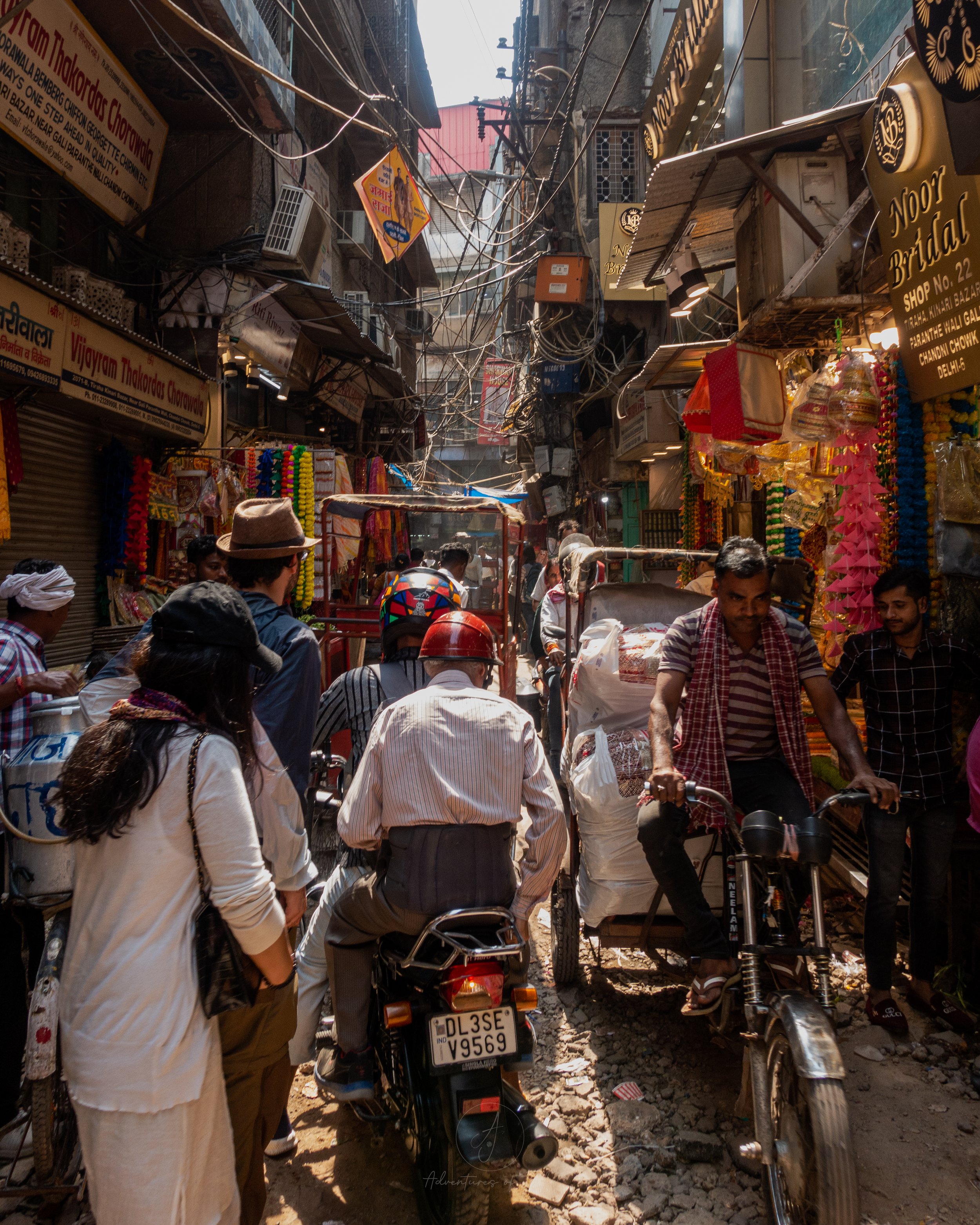
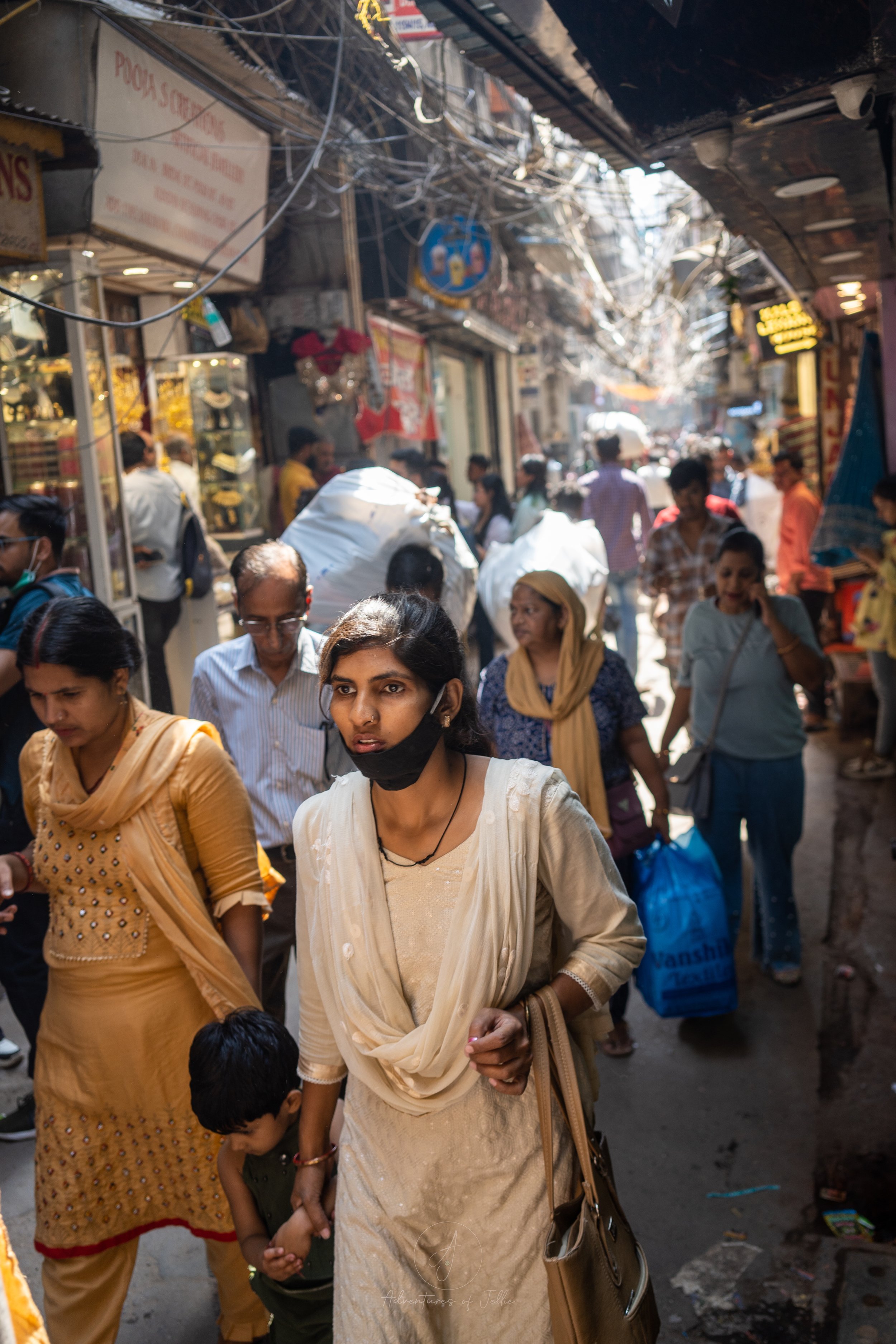
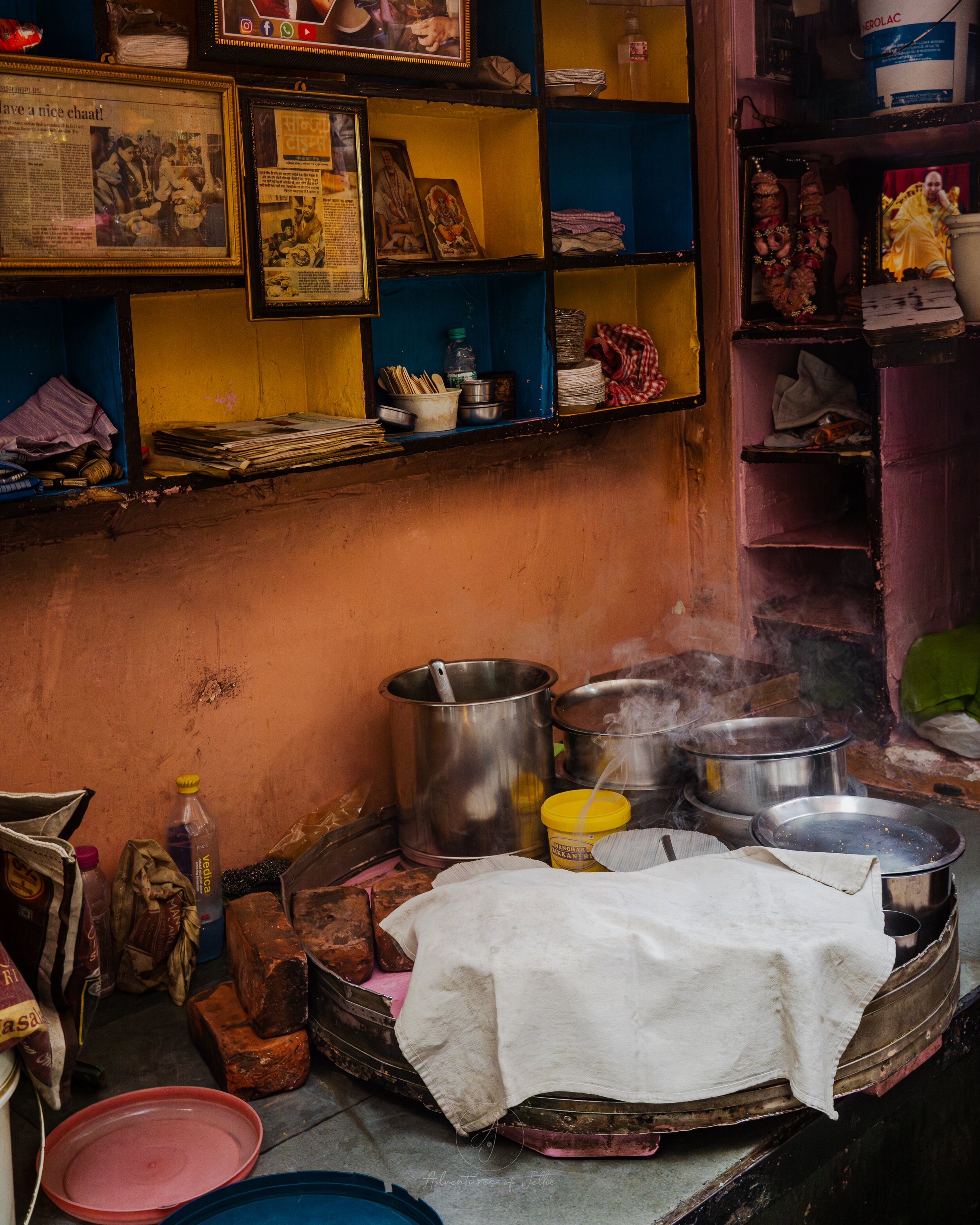
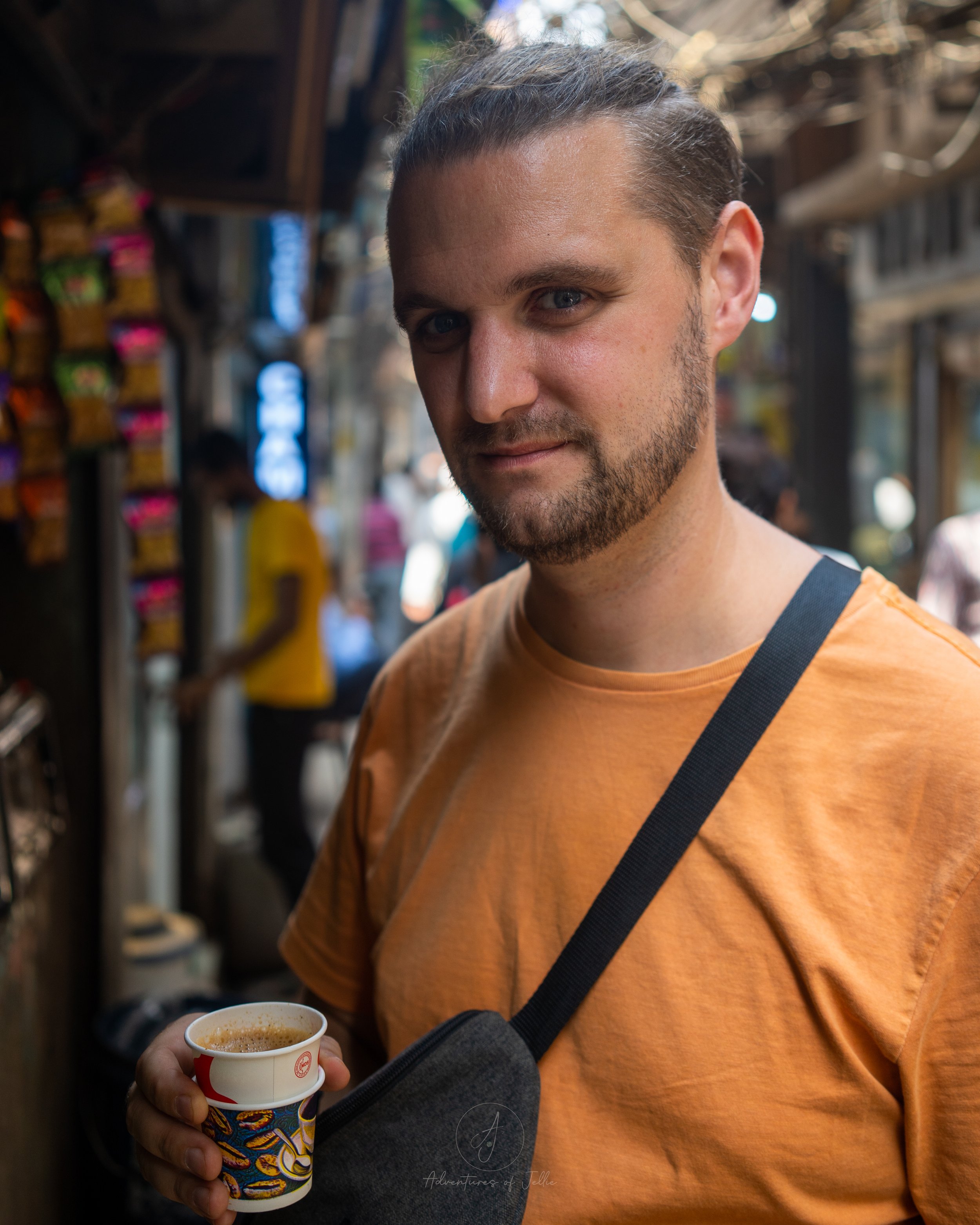
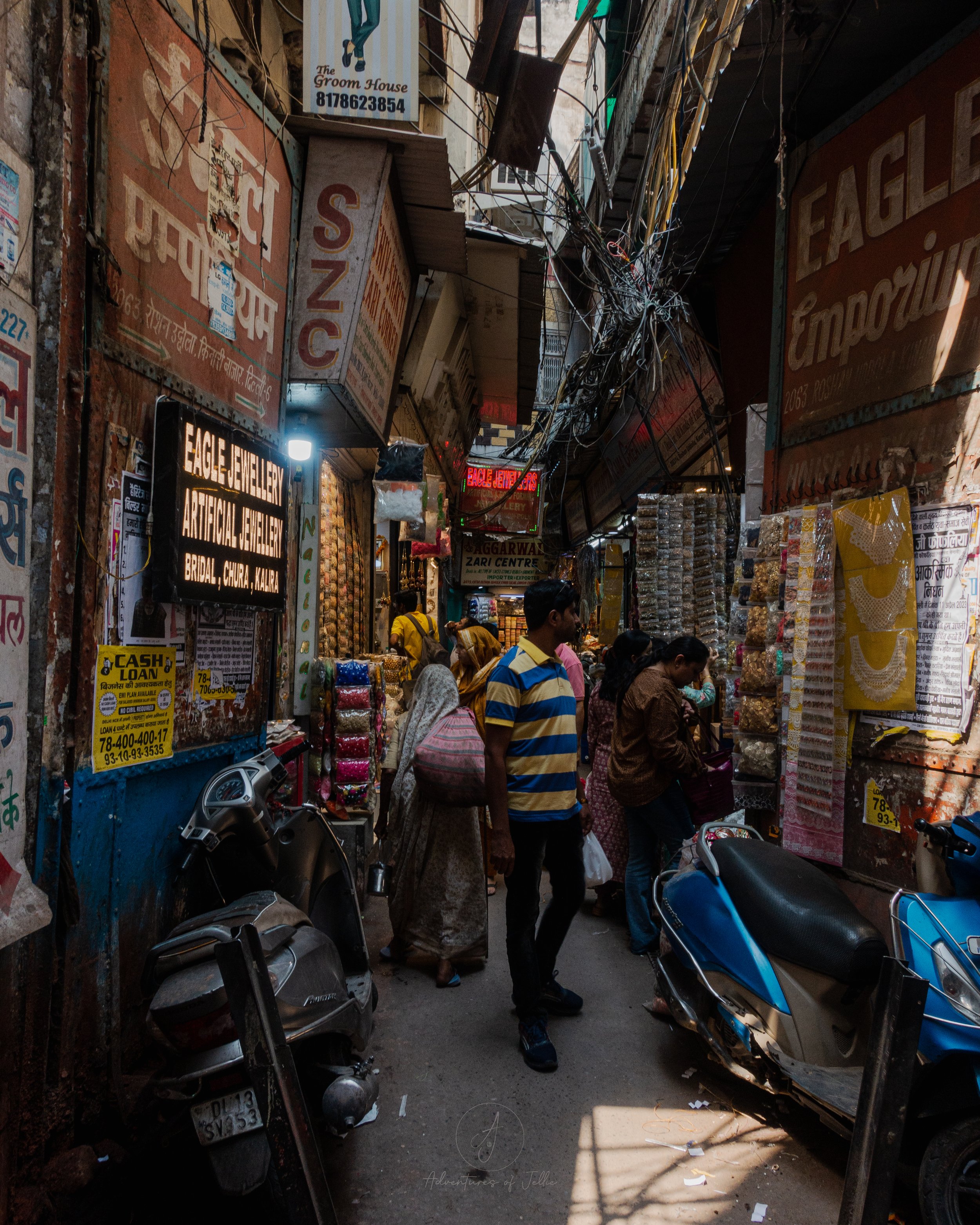
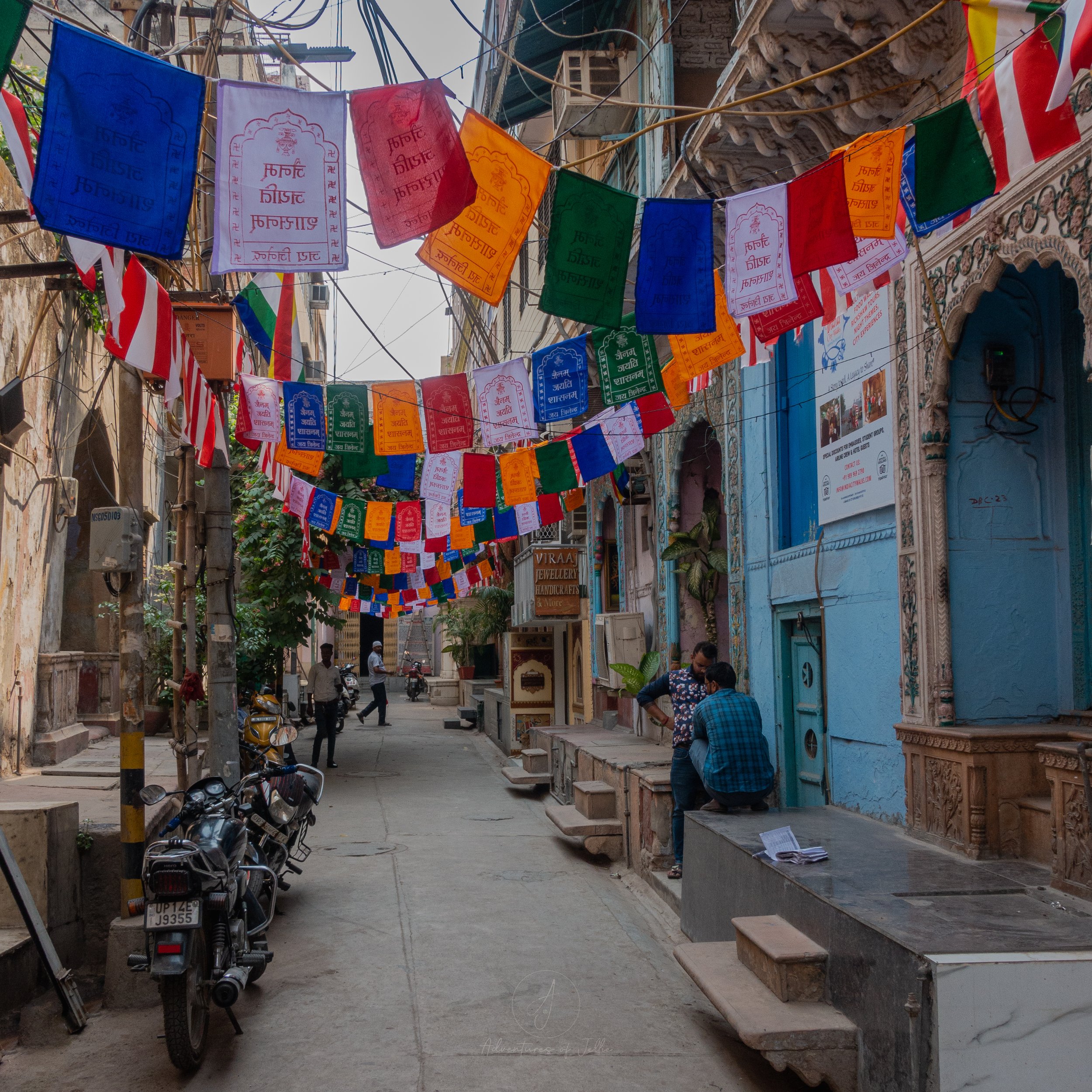
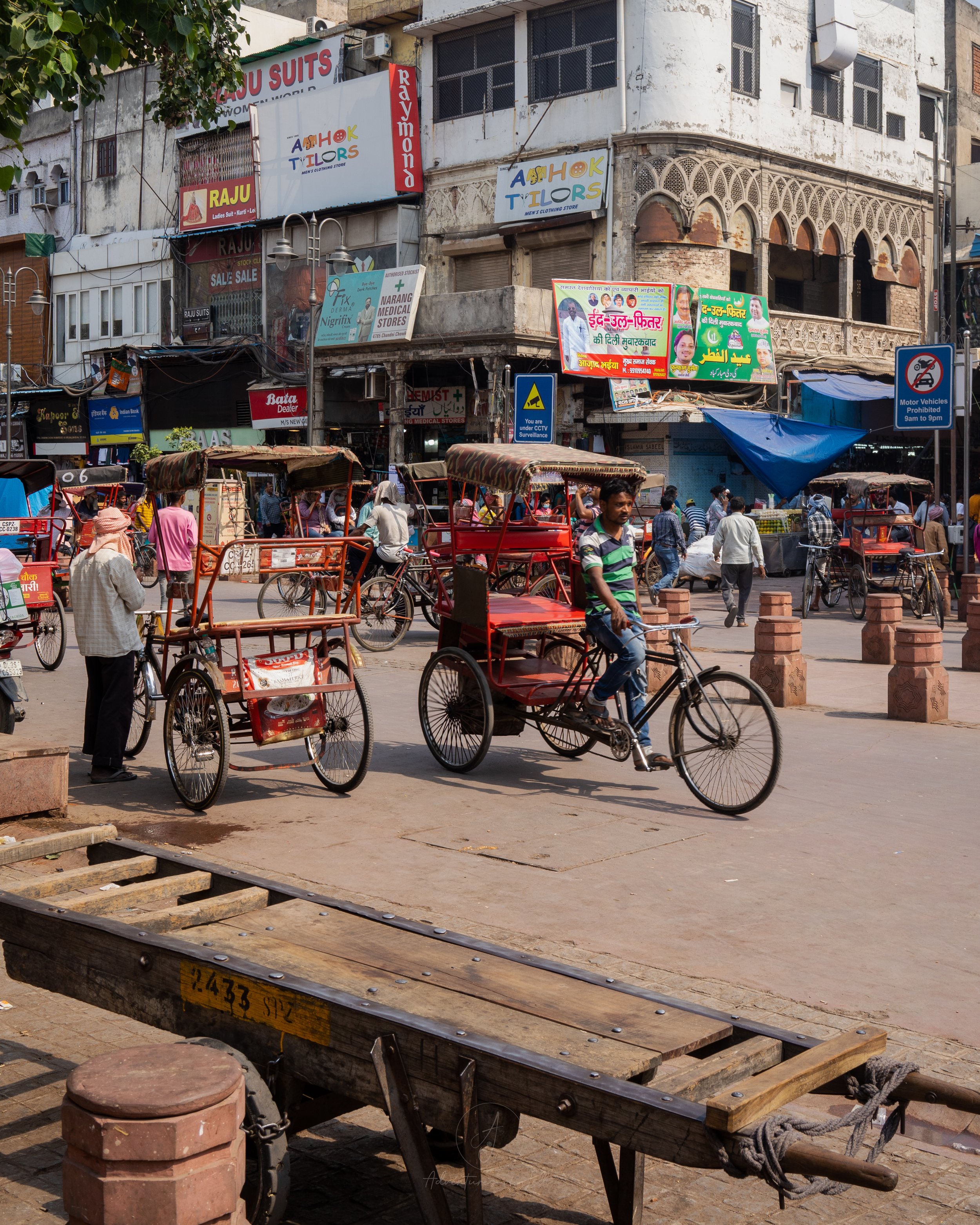
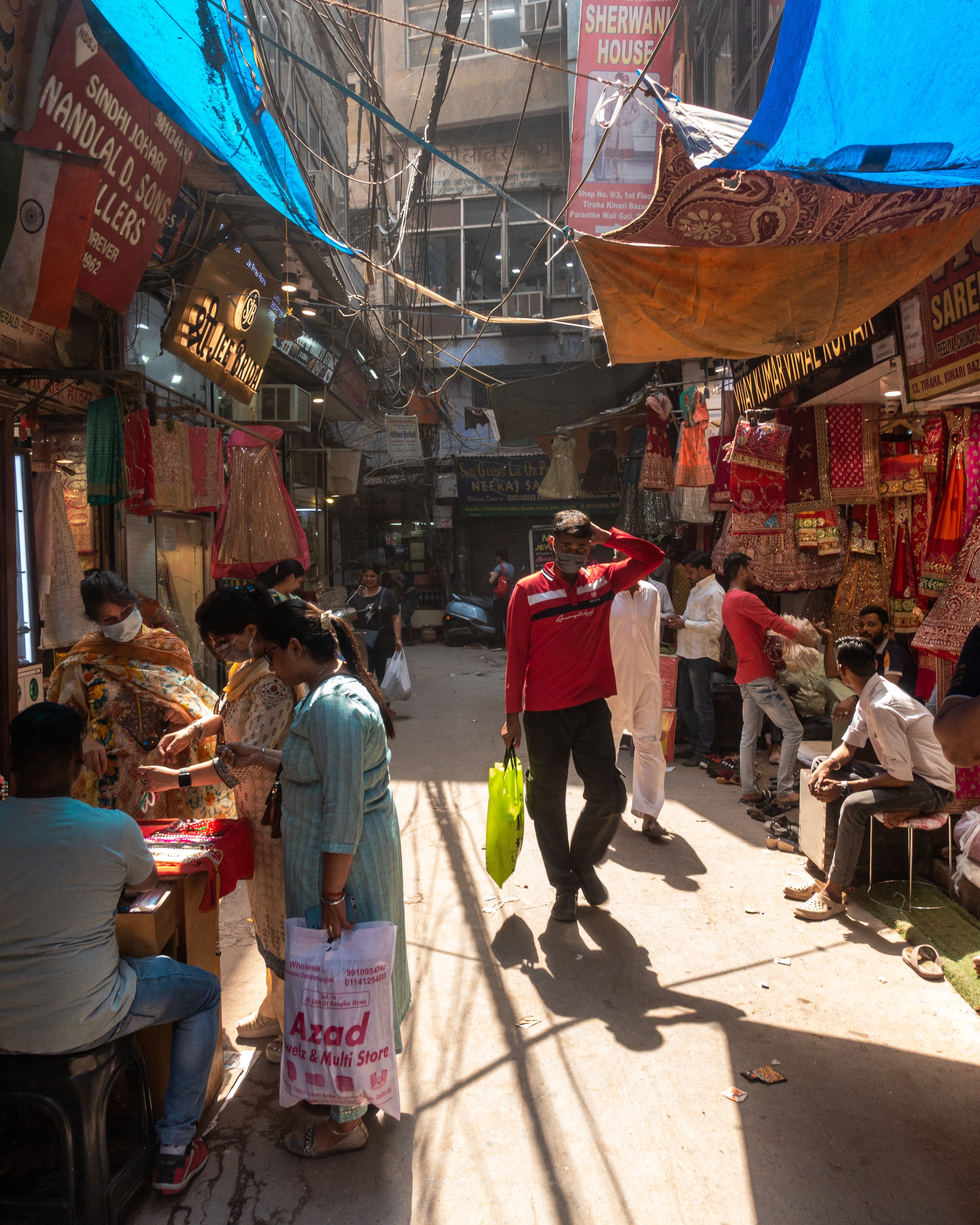
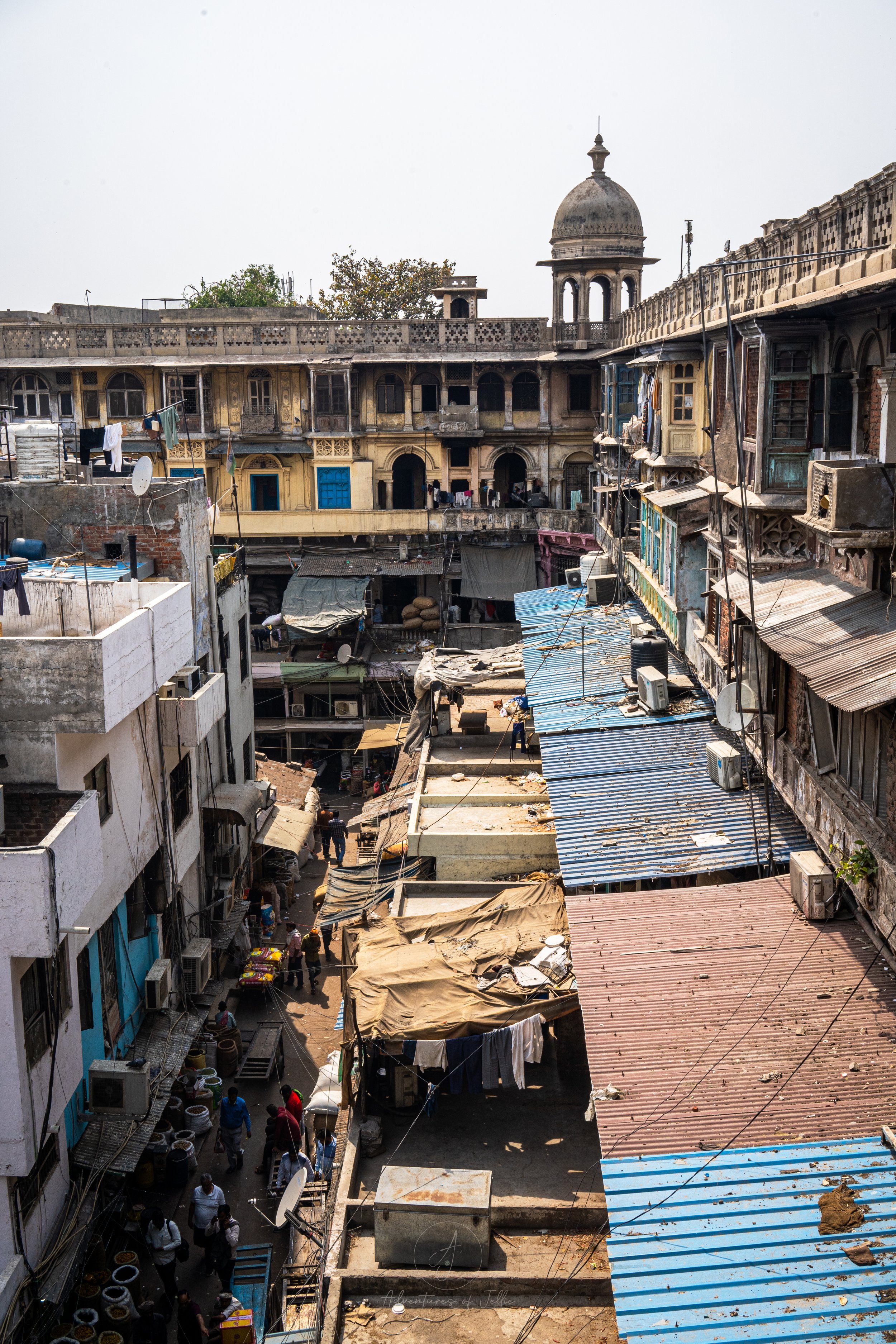


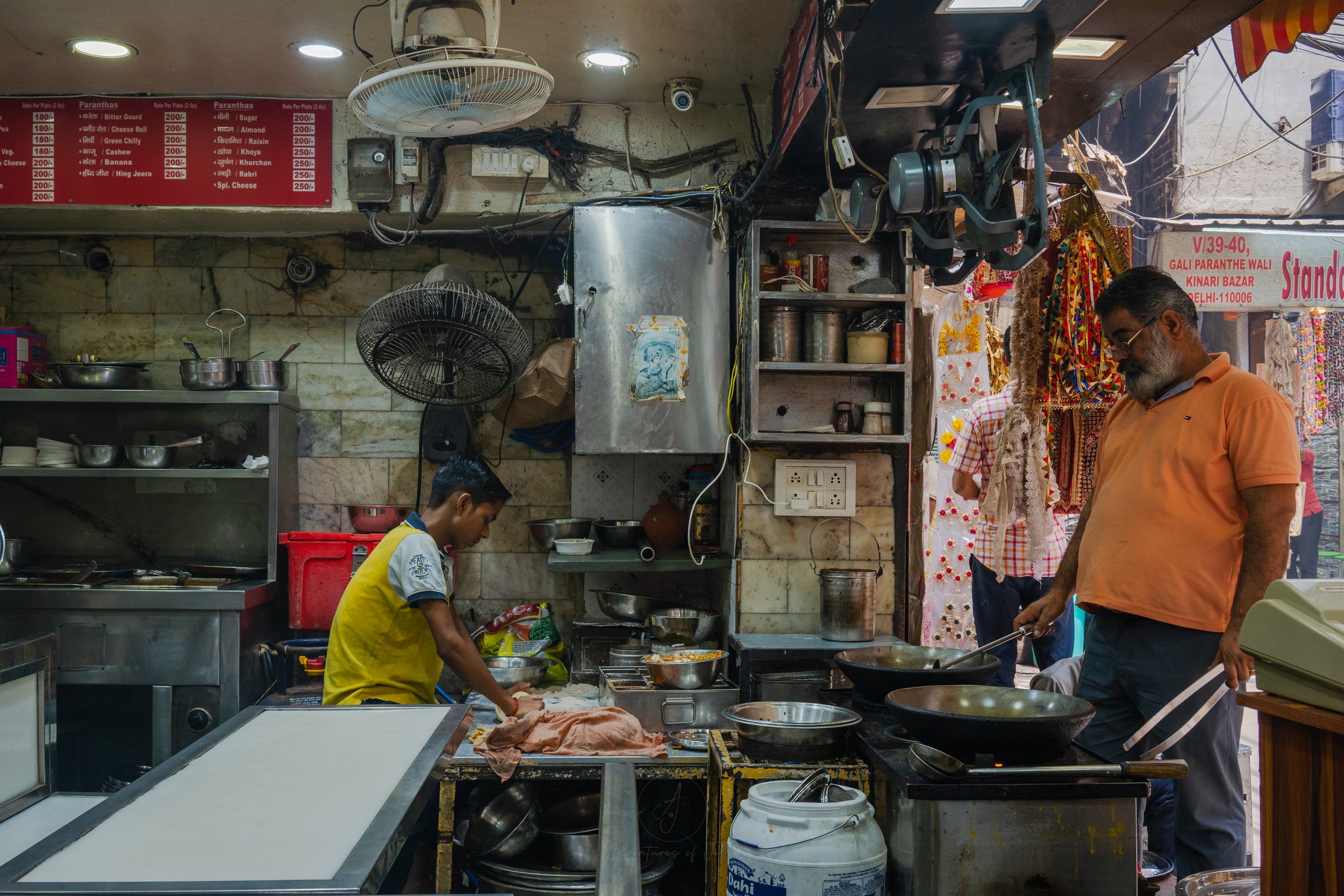

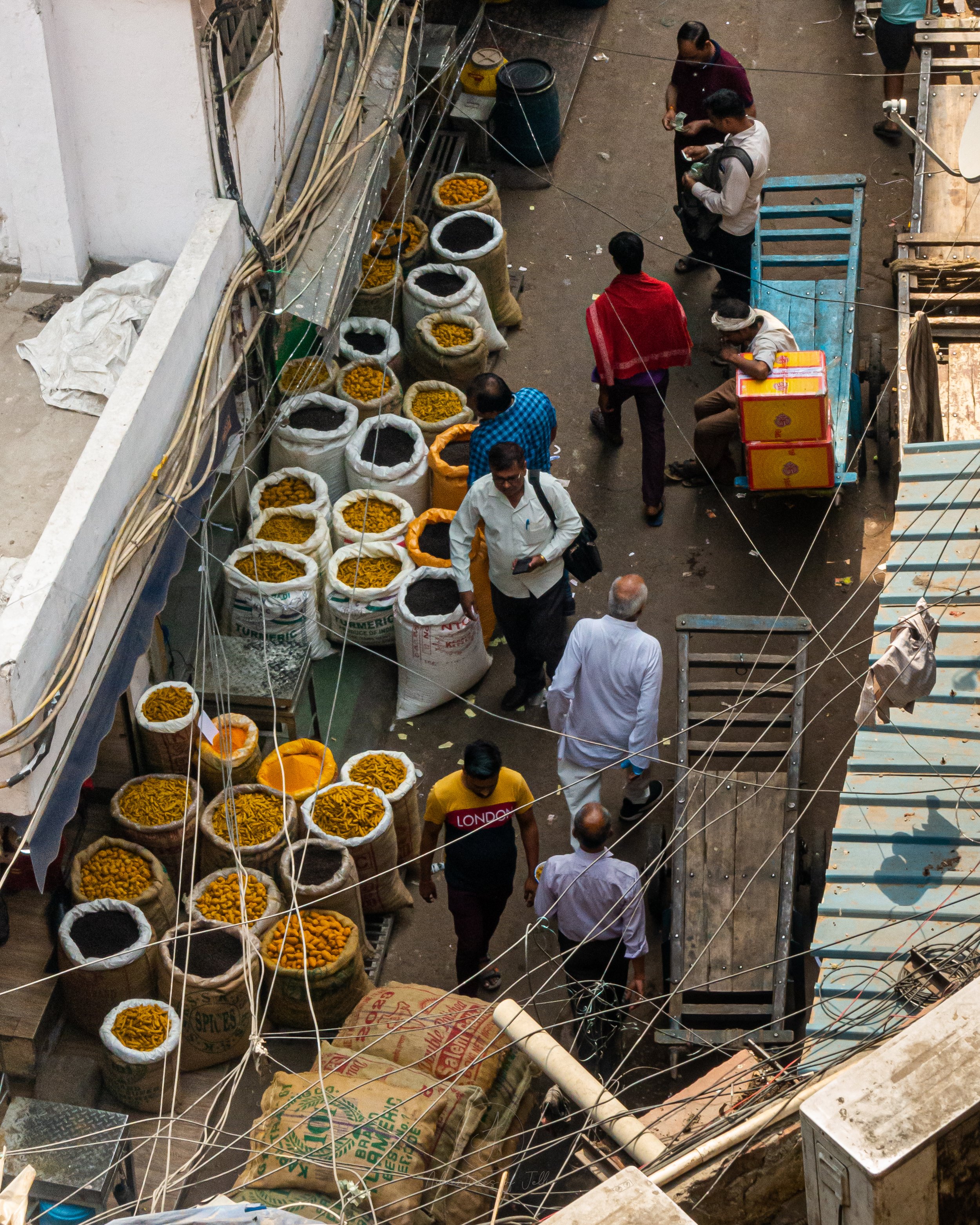
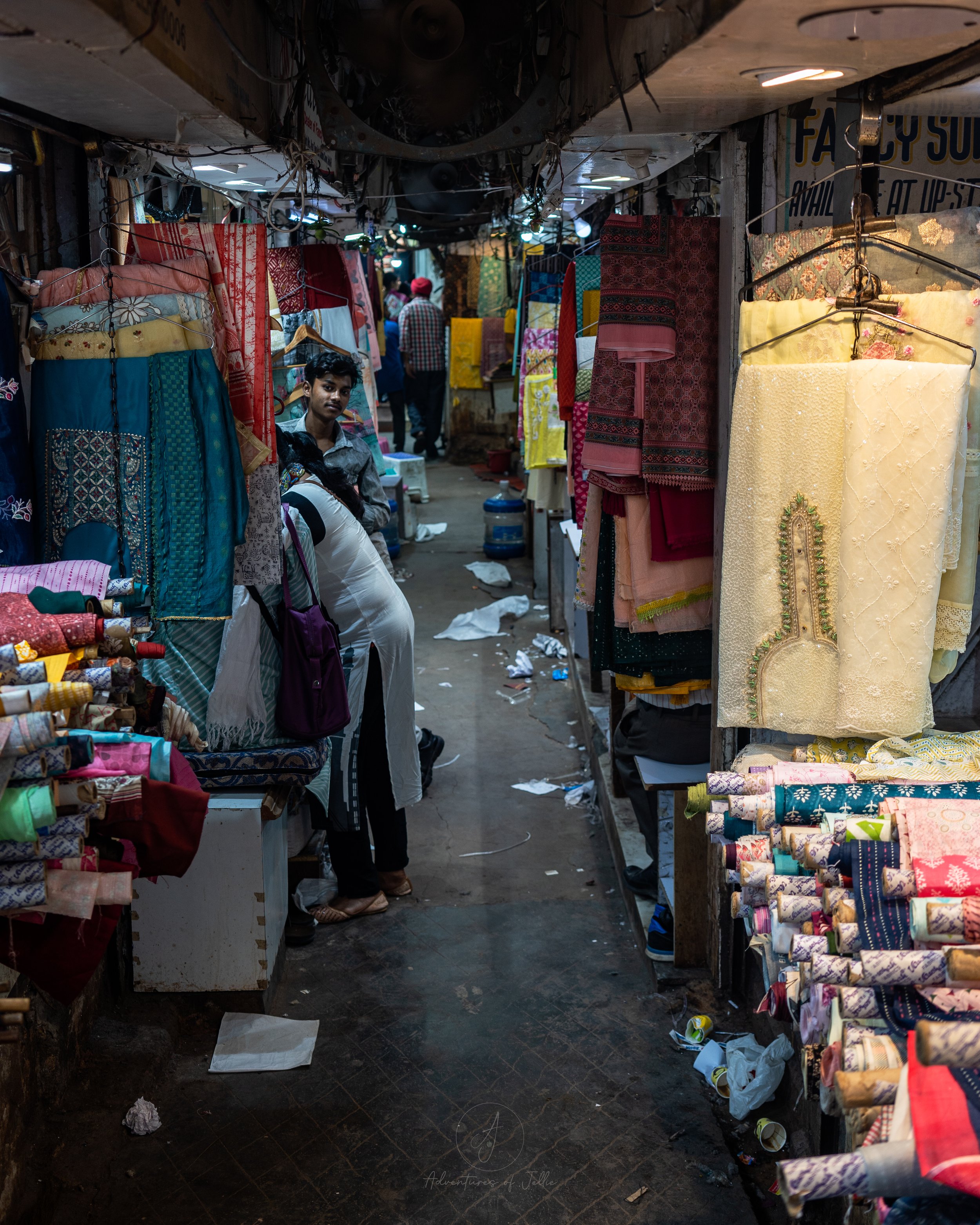
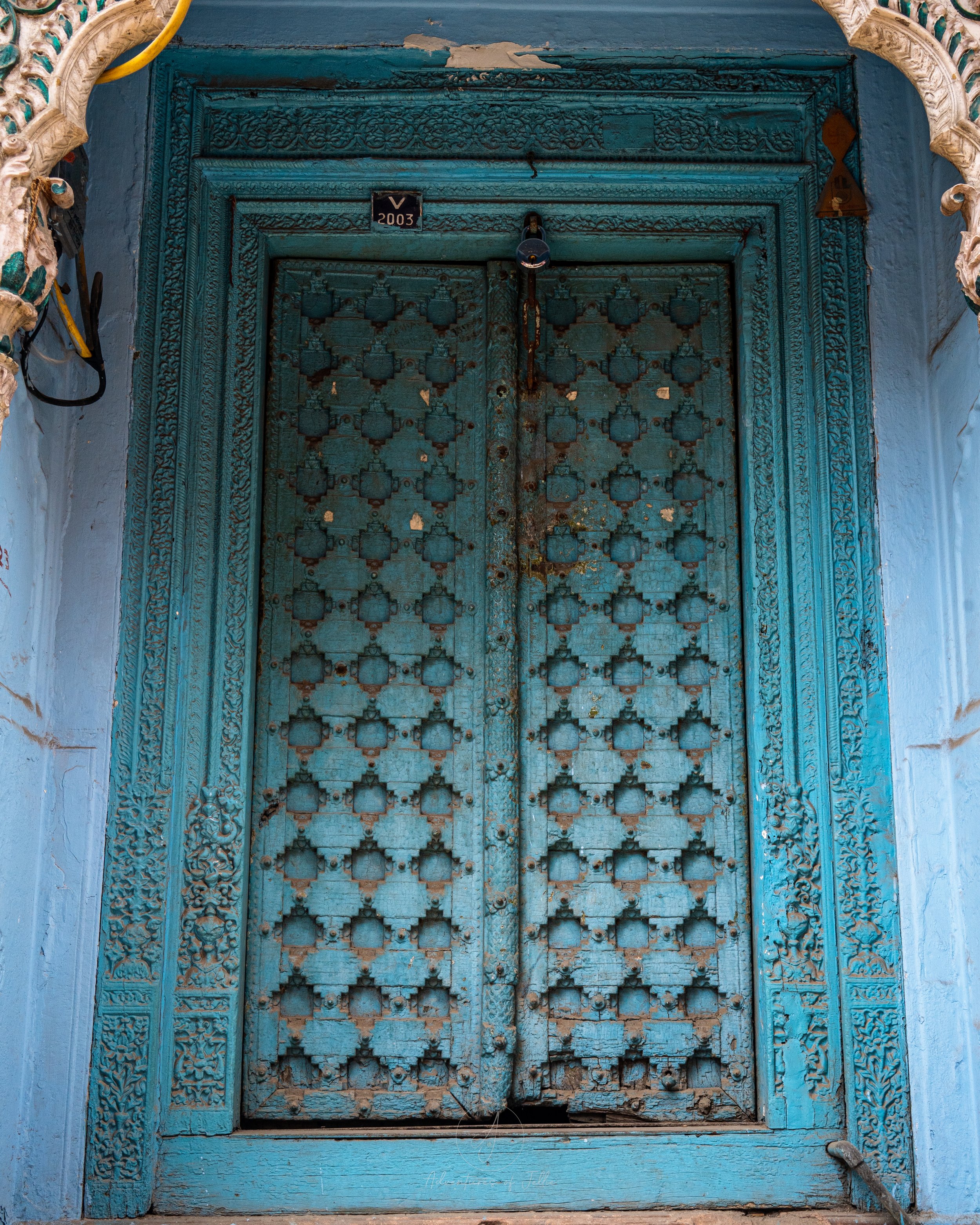
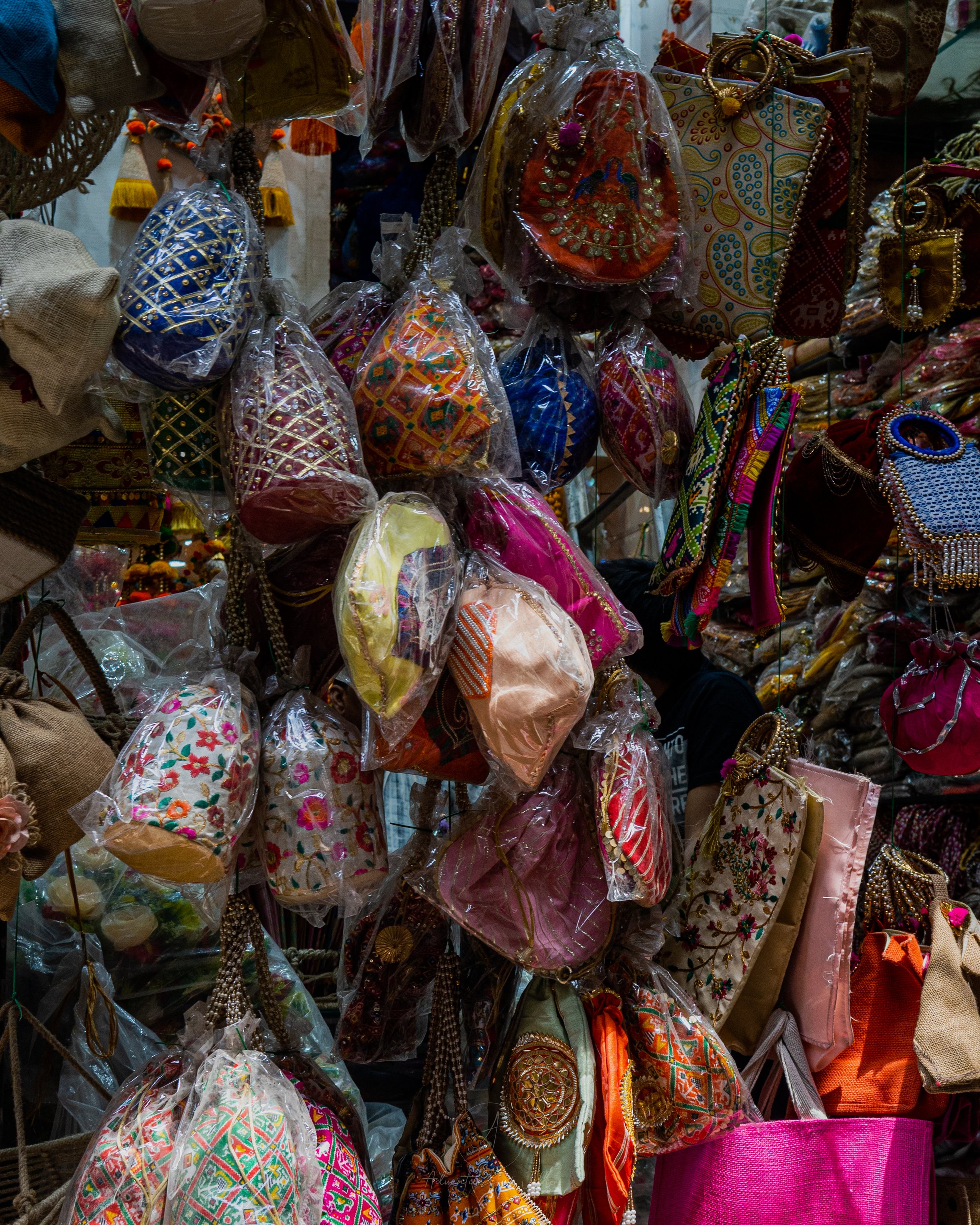
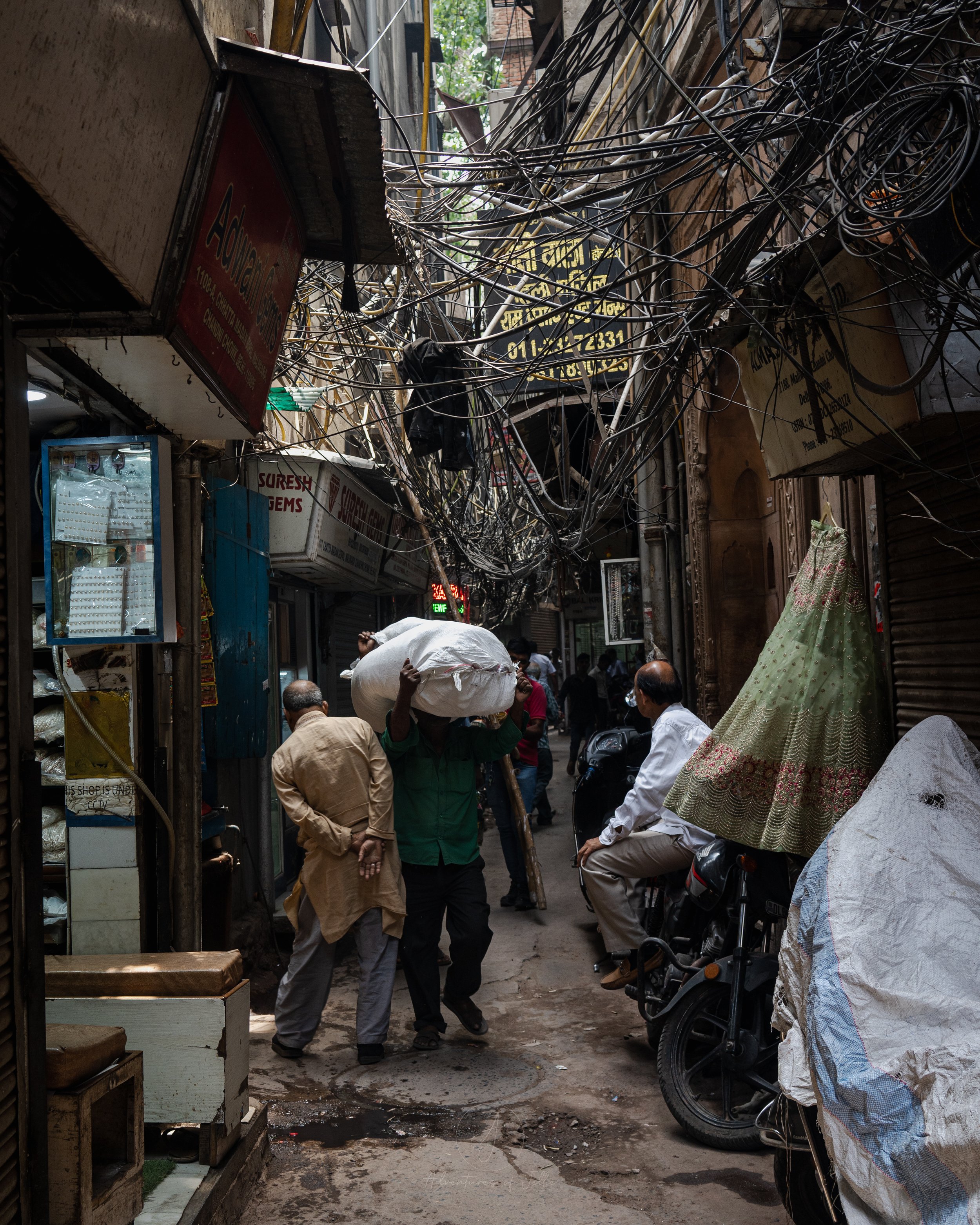
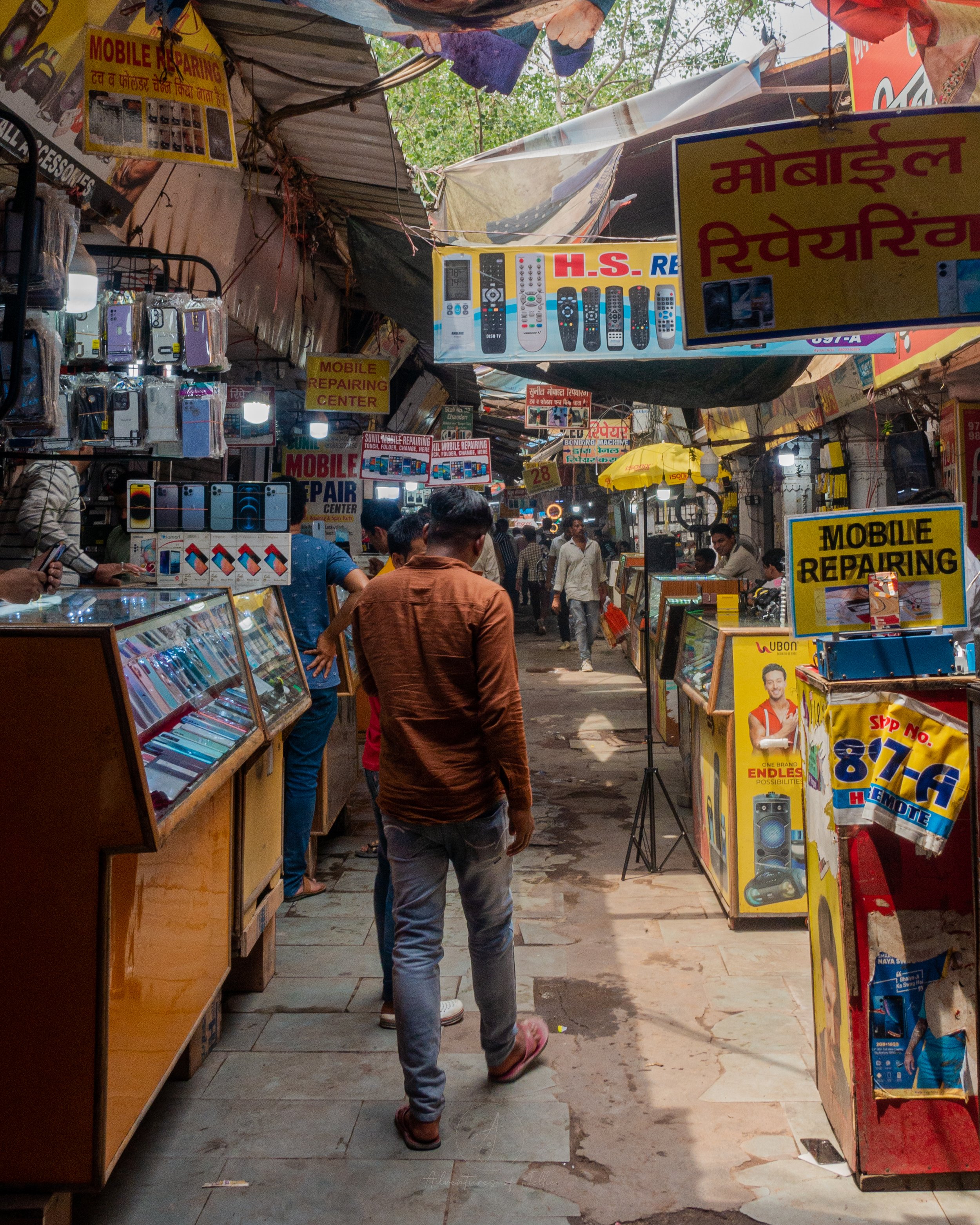

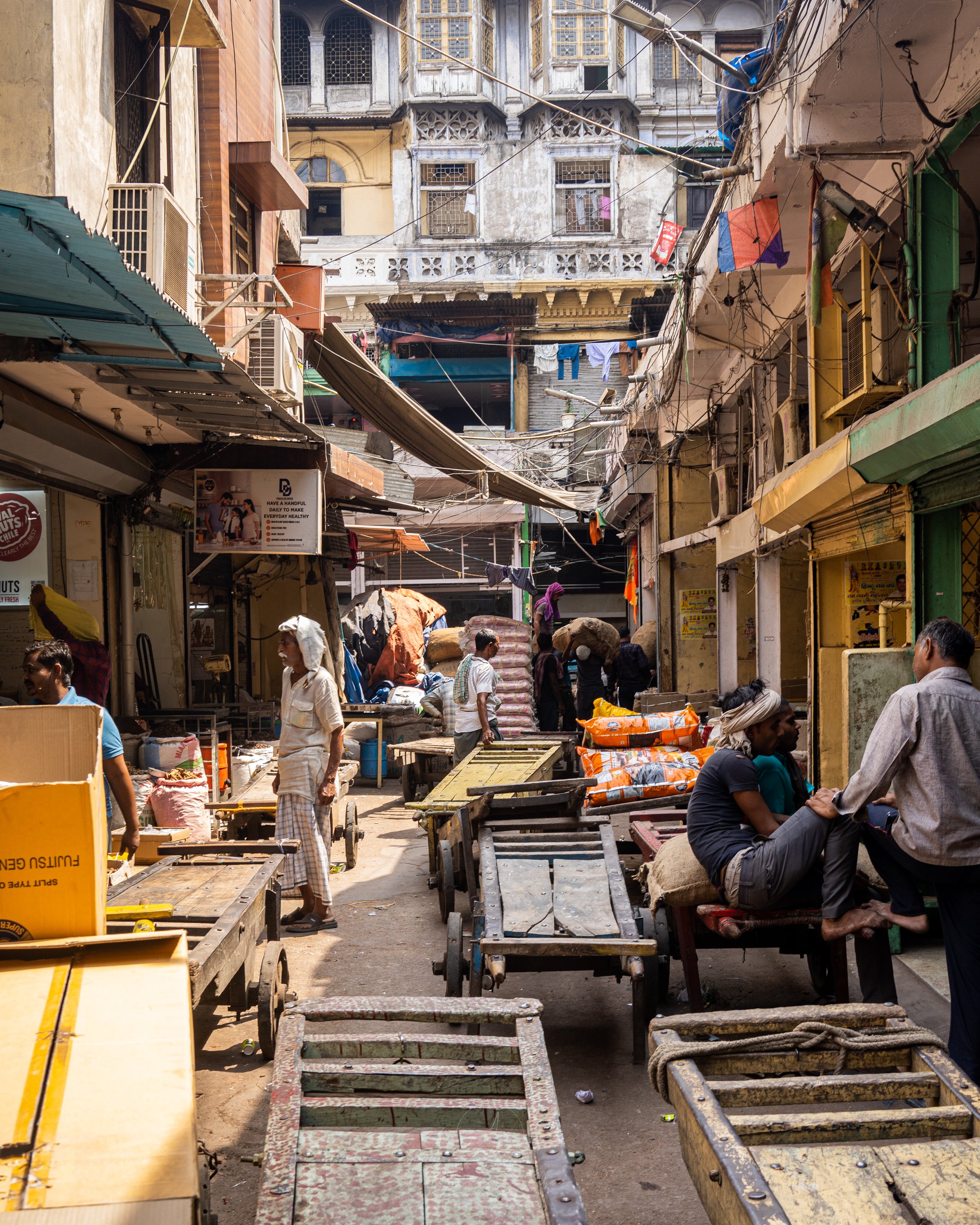
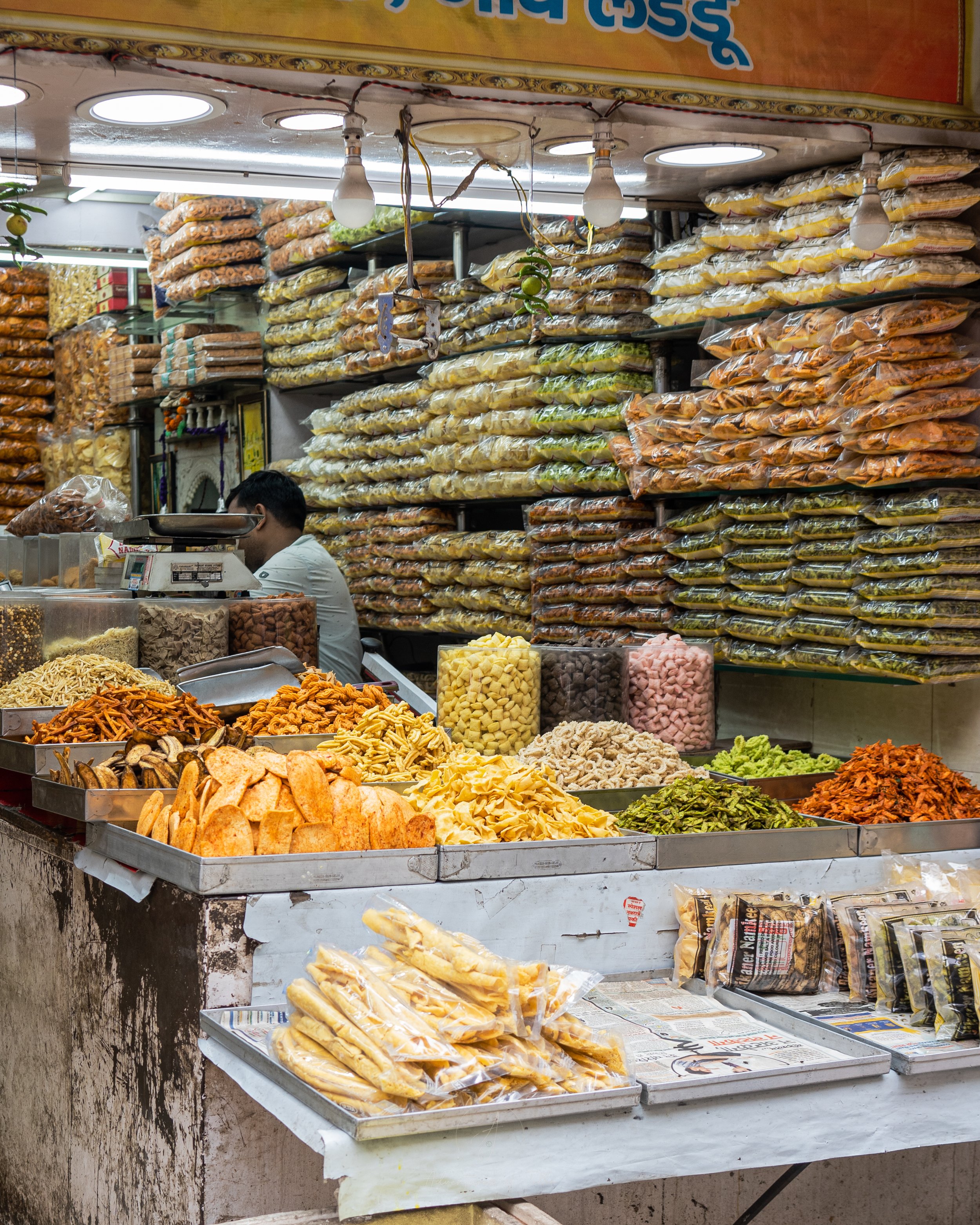

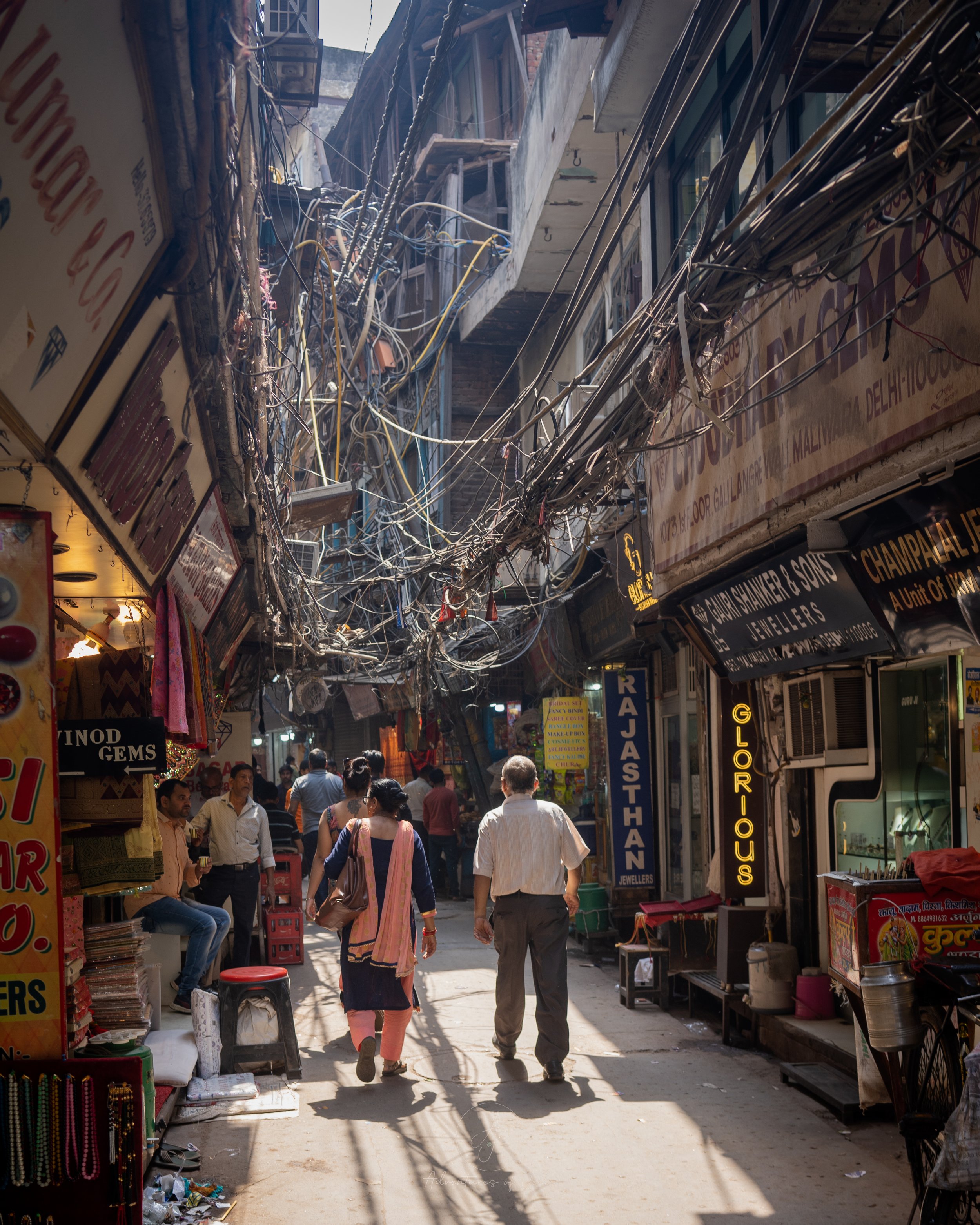
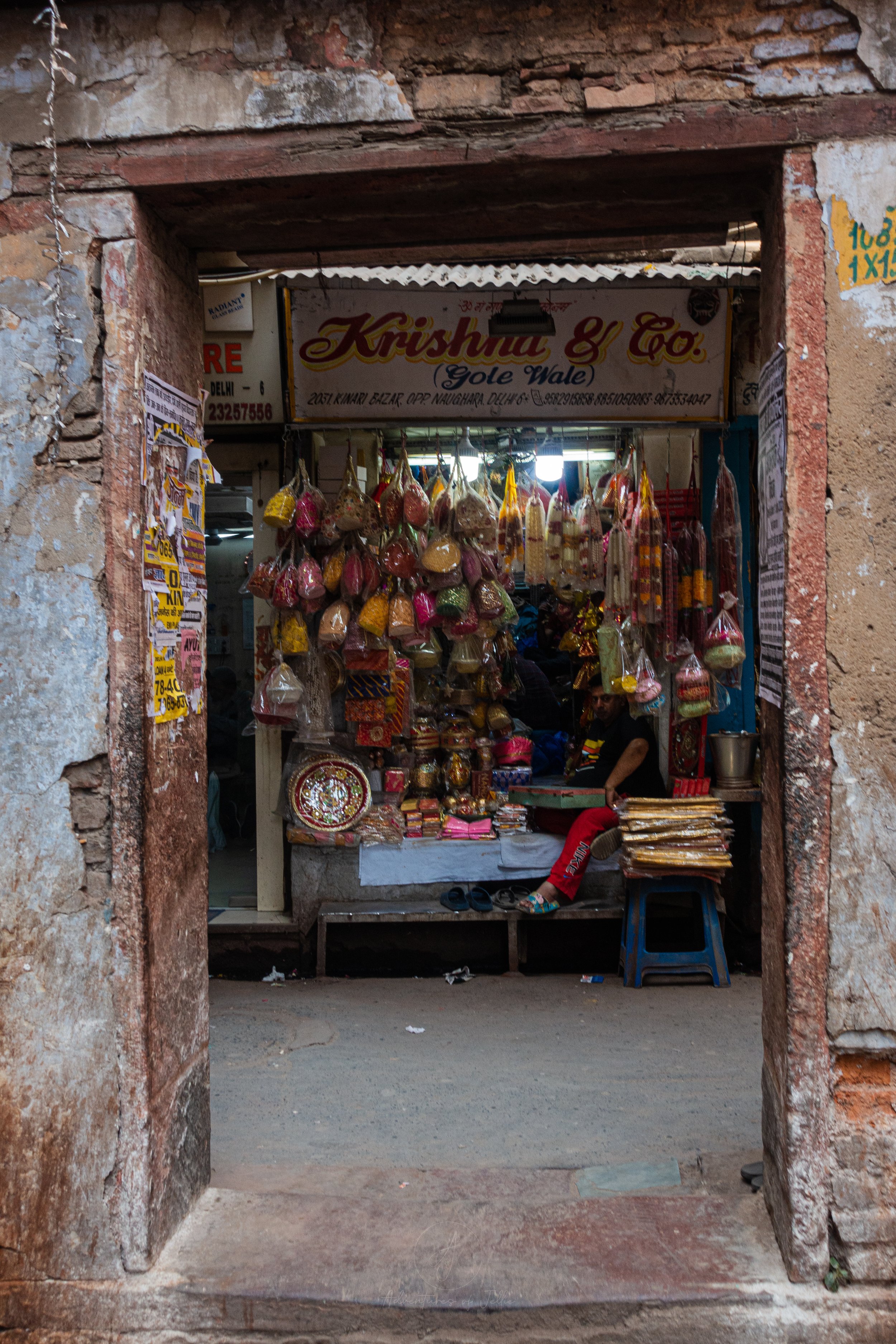
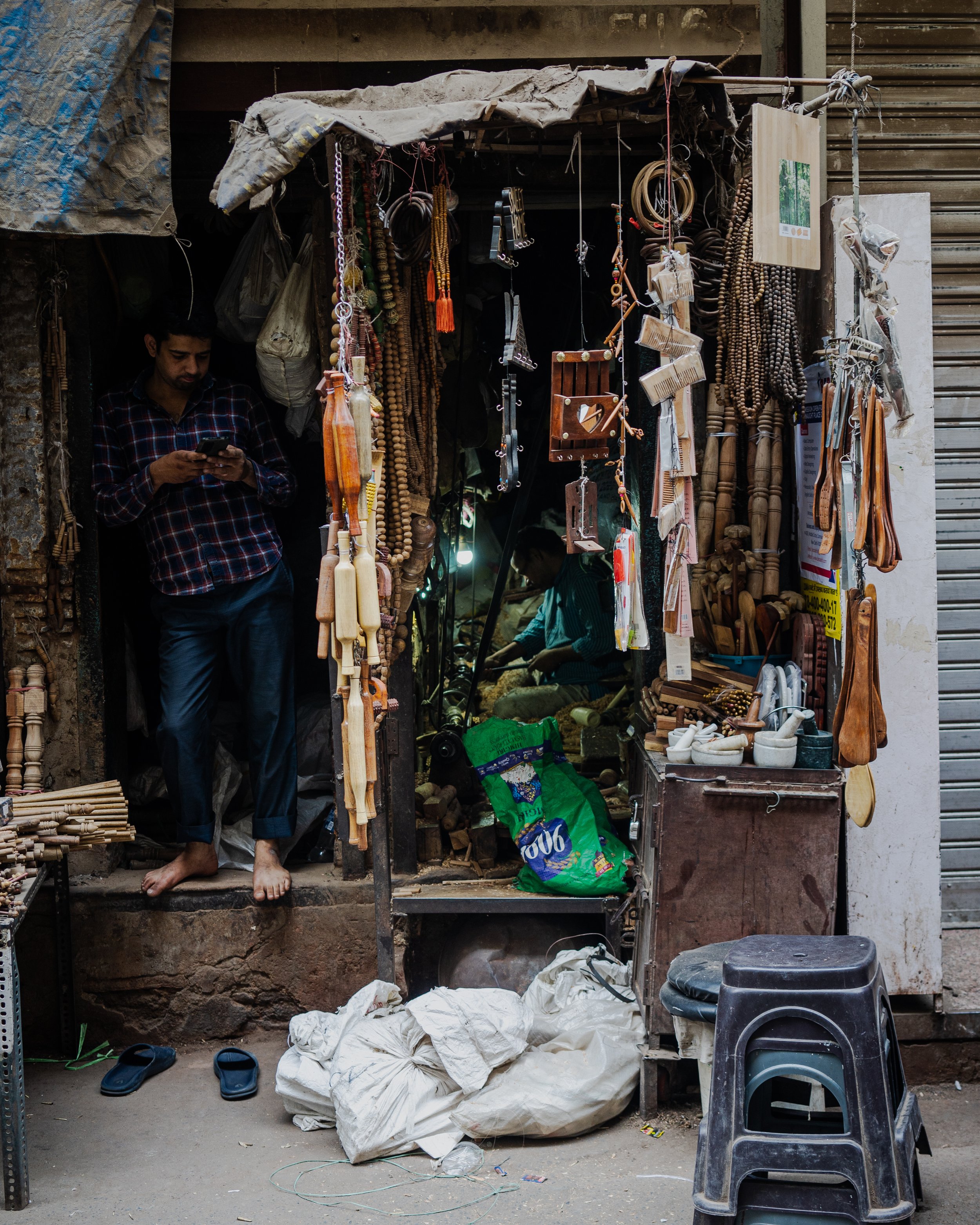
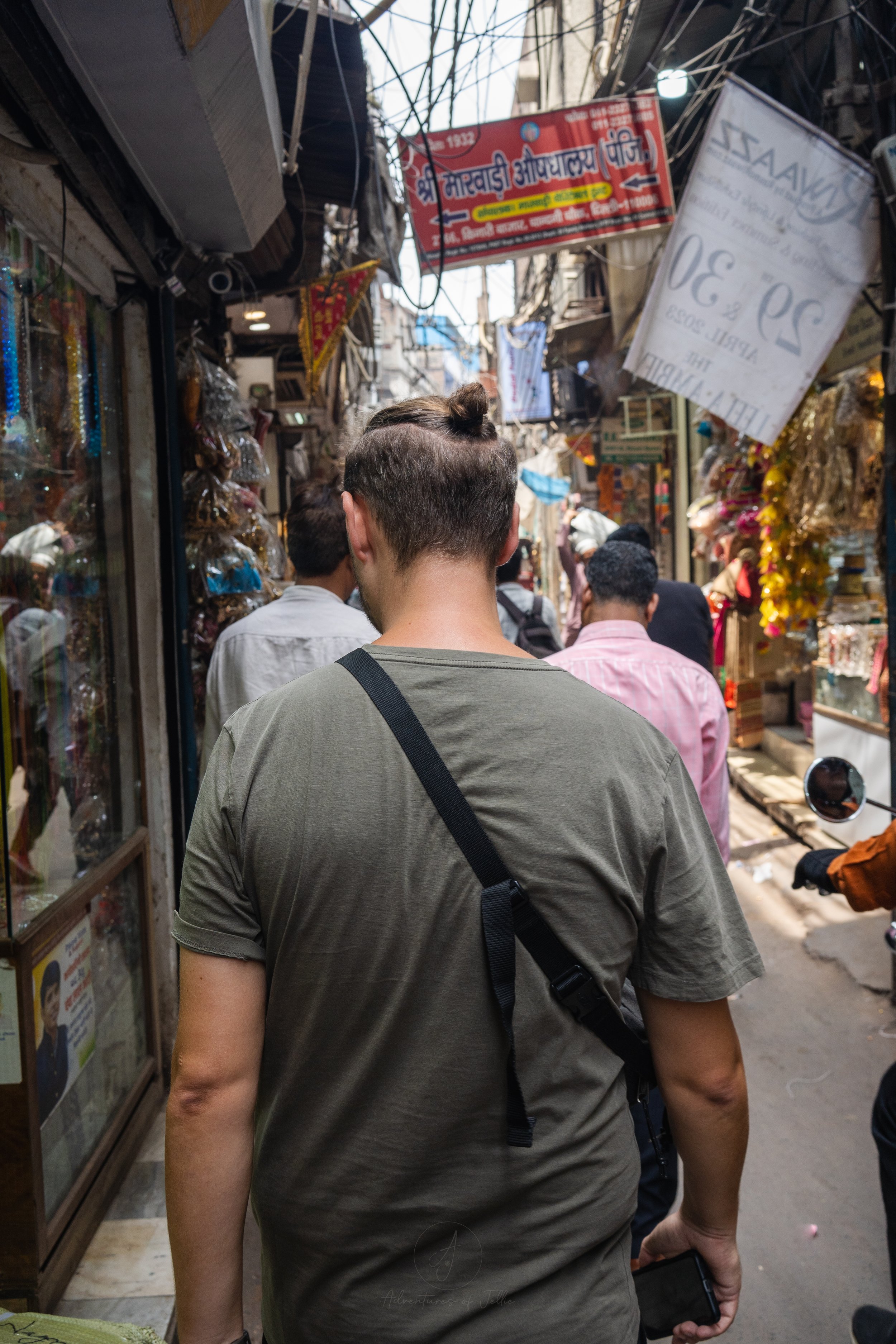
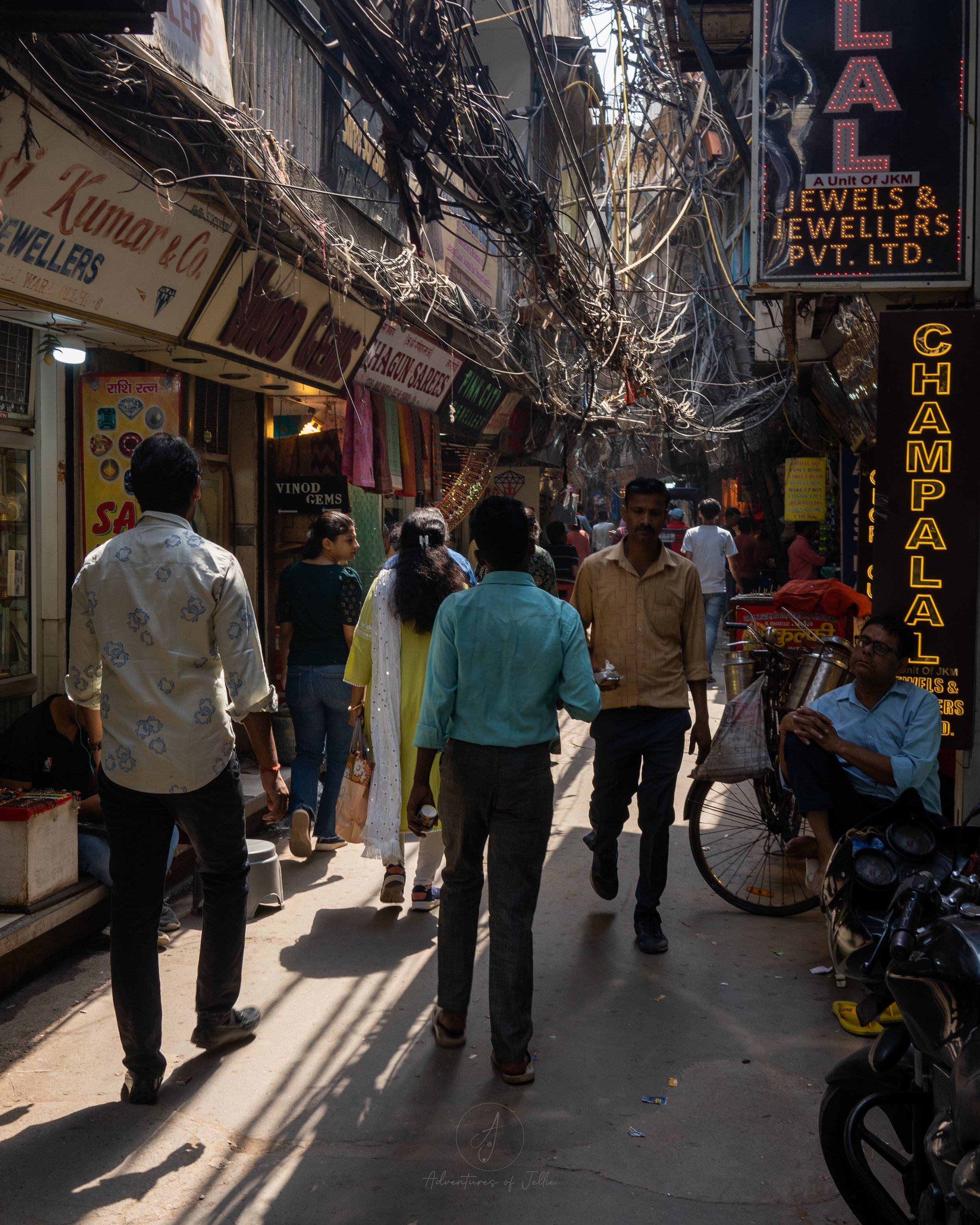

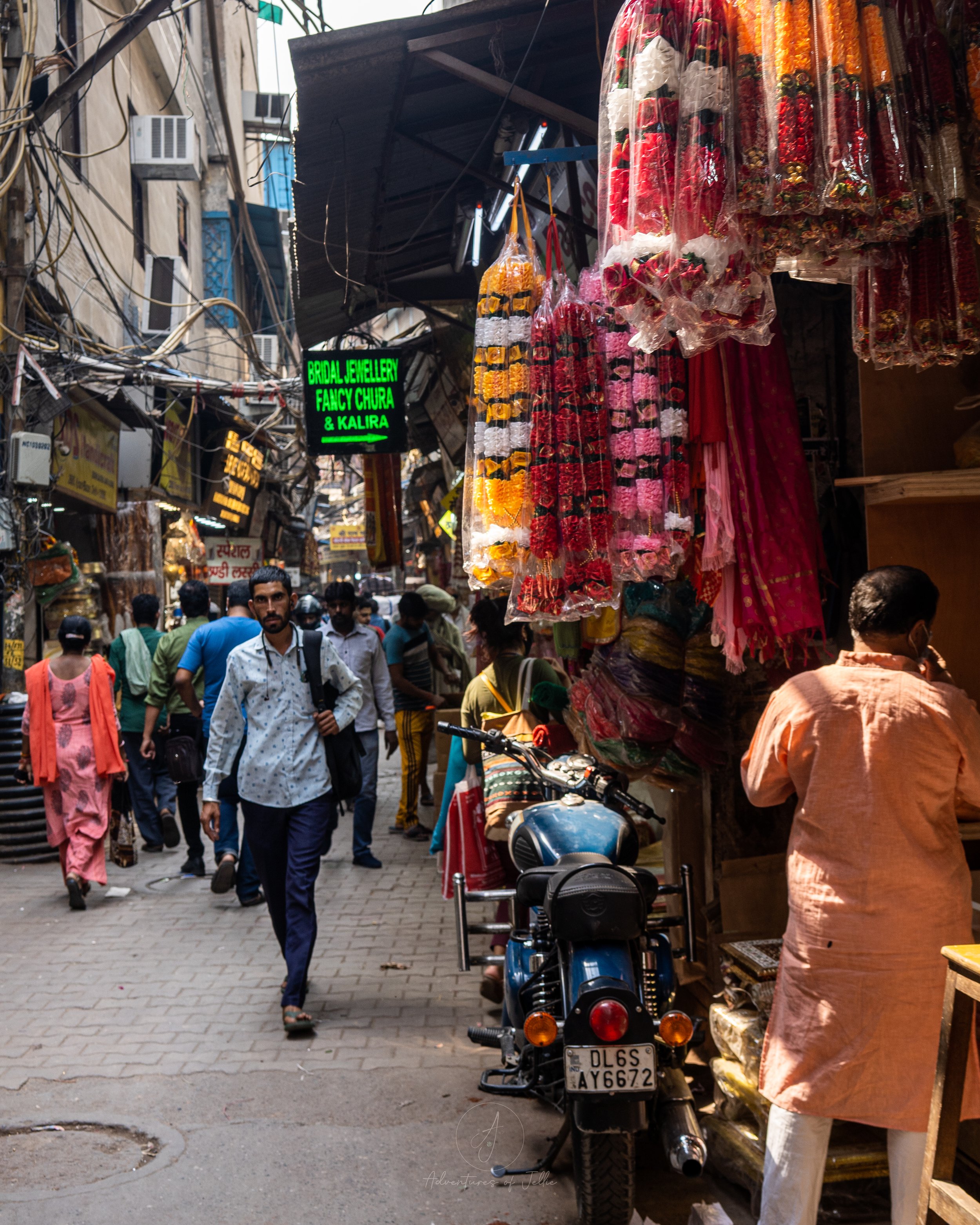
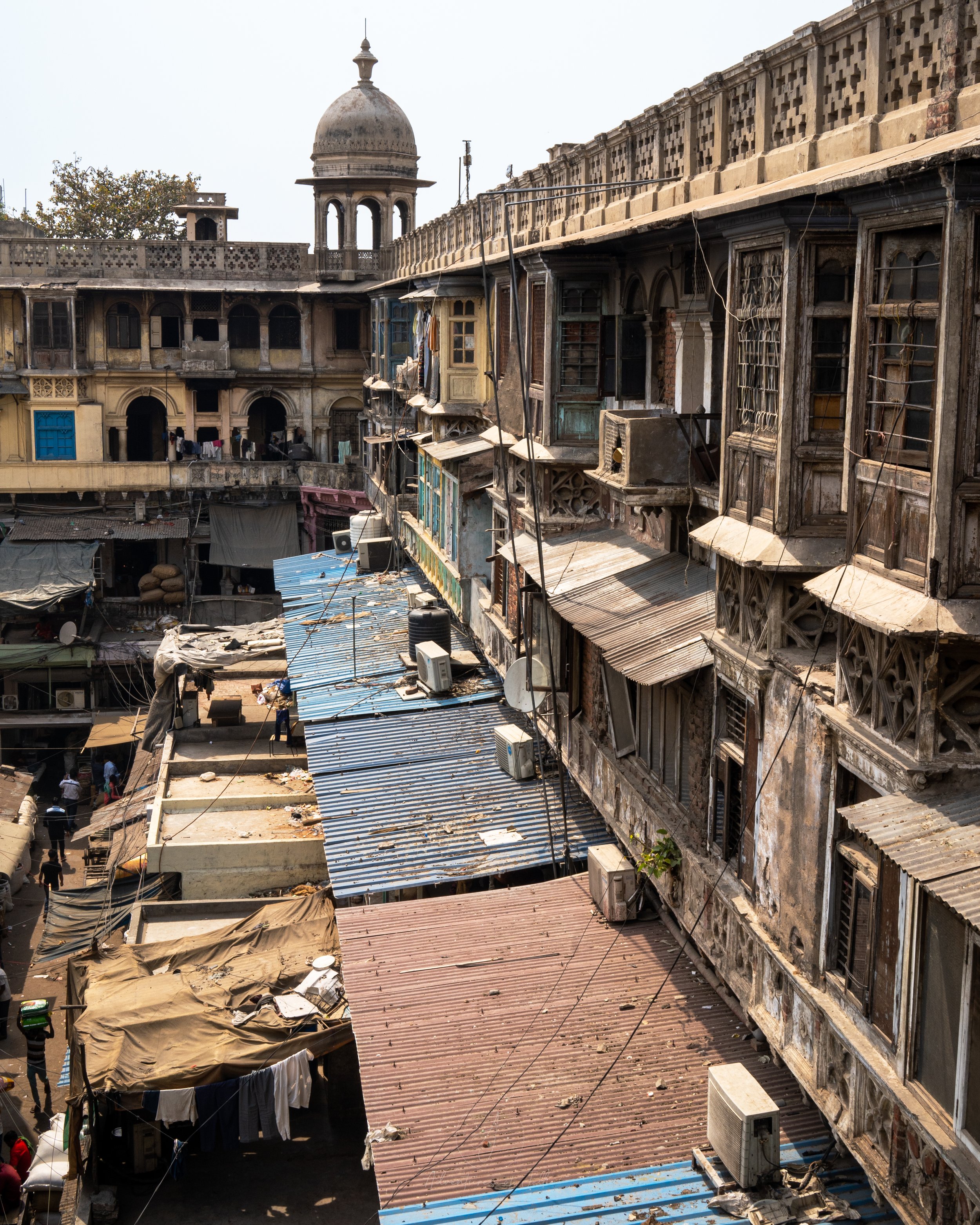
If you’ve found this blog helpful, entertaining or you just fancy supporting us please click the button below!
If you’ve enjoyed reading this article, why not save the pin below?
Arriving in India - The Chaos and the Calm
Our arrival to India’s capital of Delhi was not a smooth one! Read about our adventures landing in this massive, chaotic and beautiful city including our favourite district to stay in as well as an amazing hostel!
Arriving in India for the first time is always going to be daunting to any traveller. The sheer scale and variety India is overwhelming. Add into that the chaos of the capital, the confusion of the bureaucracy and the raw visceral newness of the Indian experience and you can see why India can be an intimidating backpacking destination. This is our account of the first time we touched down in India, it was anything buy a smooth ride!
Disclosure: This article may contain affiliate links. We will earn a small commission from any purchases made through these links.
Landing in Delhi for the first time
We had just spent a brilliant week living it up in a high rise apartment in the Malaysian capital of Kuala Lumpur. Our next destination was lined up, the flights were booked, but we were far from ready! According to various sources on the internet, we were about to “graduate” in backpacking terms. We were off to India!
India was always on the travel bucket list. The vast, continent sized country with billions of people, a bewildering array of cuisines, languages, landscapes and cultures had caught our imagination. We had always been desperate to go.
Our time during the lockdown in London had confirmed what we already knew, we had to go to India! We repeatedly watched The Budgeteers, Karl Watson and the brilliant Kingin-It - all of their Indian adventures spurred us on and gave us inspiration.
Our arrival in India was far less smooth than anticipated. We flew with AirAsia from Kuala Lumpur. After a hiccup with baggage labels (we were absolutely convinced our bags would not arrive with us!), we settled in for our five and half hour flight. The flight was fine and the bags did arrive, but John was immediately pulled aside at Delhi for random infection testing when we landed. Luckily the tests only took ten minutes and John was quickly released from the nose poking zone. Not the end of the world but not what you want in the middle of the night after a flight!
Delhi Hotel number one - Mistakes were made…
We thought we had been sensible. We had a lovely and quite luxurious hostel lined up in south Delhi but, as we were arriving closer to midnight, we decided to book one nights accommodation close to the airport. We found a super cheap room which, according to booking.com, was right next to the airport. Very cheap….almost too cheap…
We bought our sim cards, booted up Google Maps and promptly got very confused as to why our hotel had moved to be nearly 4 km away! The booking.com address, it seems, was incorrect. This was our first sign things may not be as they were advertised. Never mind we thought, let's get on with it and get a Uber.
We got into our taxi well after midnight and were immediately thrown into the melee of Delhi’s roads. What we thought was a dual carriageway appeared to be a six lane free for all. Throw in some cows, stray dogs and a man wheeling his chai stand across a flyover and you get the picture. This was very overwhelming compared to the comparatively sedate, well mannered traffic of Kuala Lumpur, but this was all part of the vibrancy, excitement and adventure we had hoped to find in India!
Turning off the motorway, the tarmac disappeared and we found ourselves in a warren of alleyways. Fluorescent lit streets that, despite the late hour, were absolutely buzzing with life. This was well past midnight, in London the streets would have been dead. In Delhi there were young children buying ice-creams and food vendors still doing a roaring trade.
We had been speaking to our hotel online, but they had gone radio silent after we had declined their offer of a taxi (the offer was 4x the price we paid on Uber). So when we pulled up to the darkened entrance we shouldn’t have been surprised by the frosty reception and the sudden revelation that the hotel apparently didn’t have any rooms for us. The unsmiling man at reception said he would organise a room nearby in his “sister hotel” for the same price. Just wanting to sleep, we shrugged and followed him further into the maze of alleyways.
We arrived at the “sister hotel” and began the laborious task of checking into a Indian hotel. Every hotel, hostel, guesthouse etc is required to make you fill out an enormous tome, detailing all your personal information; where you’ve been, where you’re going, how old you are, how long you have been in India and what you had for breakfast (maybe we made that last one up). After filling in this tome we were escorted up many flights of stairs to our new room.
We’ve been lucky on our travels so far, finding great deals and ridiculously cheap accommodation everywhere we went. However, on this day, we found that paying for a cheap room in Delhi really did get you what you paid for…
This is predominantly a positive blog so we don’t usually moan about mishaps and now that this is over, it is all part of the memory of adventure! Whilst it was happening however, and we were lying fully clothed in a very unwashed bed whilst two angry men outside our door had a full on shouting match, it was less than fun.
When the morning finally broke, we made our way downstairs, checked out and ordered an Uber to take us to our fancy hostel. As is often the case, everything looked better in the morning light. We had had a rubbish night sleep in a hotel we hadn’t booked but, as soon as we walked outside, we knew that we were exactly where we wanted to be. The relatively quiet street we had walked down the previous night was now a throng of activity. Sari clad women ushered their children to school, whilst vendors of every variety had opened shop or were pushing their carts up and down the street. Unbelievably delicious smells filled the air, wafting out of a multitude of nearby eateries!
We knew we had arrived in India.
Accommodation in South Delhi - JHouse Hostel and Mohammadpur Village
It appeared, from what other backpackers have reported, that Delhi is a very “marmite” city. Some love Delhi with its vibrancy, chaos and colour, whilst some hate it due to scams, perceived unfriendliness and the unrelenting pace of life. We decided not to stay in the traditional backpacker district of Paharganj. Paharganj seemed to be where other backpackers tended to get overwhelmed, scammed or both. Instead we chose to stay in the south of the city in the neighbourhood of Mohammadpur.
On our next trip to India we did actually stay in Paharganj. make sure you read our guide to the district and Old Delhi here. It is well worth a stay and undeserving of its negative reputation, but it is very different from the relaxed streets of Mohammadpur!
Our hostel, JHouse, was in a quiet neighborhood, at least by Delhi standards anyway! Mohammadpur is a small district full of little shops and winding alleyways. Close to the upmarket Hauz Khas district and its beautiful deer park (read all about them here), as well as being within walking distance of a couple of metro stations Mohammadpur was well connected to the rest of Delhi. You can find Mohammadpur on a map here. Staying down in south Delhi turned out to be a brilliant decision and we are sure it was largely responsible for our smooth introduction and brilliant time in India’s busy capital.
Our Uber pulled through a colourful fruit and vegetable market and deposited us outside what looked like an apartment building. Following the signs we came up to the third floor and pressed the buzzer that let us into our hostel. What a difference to the previous night! Our large private room at JHouse Hostel was the perfect sanctuary from the frenetic pace of the city outside. A roof garden looked over the streets of Mohammadpur, its patio surrounded by potted plants with swings, comfy chairs and tables.
JHouse hostel was comfortable, stylishly decorated and clean. With lovely hot showers, fantastic staff and relaxing common areas both indoors and outside on the roof. There are dorm rooms and private rooms available. Our private room was massive, with lots of cupboards, luggage space and a good size bathroom.
JHouse was a brilliant base for exploring Delhi. Within twenty minutes you could walk to the Hauz Khas district with its independent shops, high-end cafes and bars. The walk to Hauz Khas would take you through the green space and ruins of Hauz Khas Park (also known as Deer Park). This green park with its chilled out lake became one of our favourite spots to relax and walk through in the early evenings. For more information on Hauz Khas and Deer Park make sure you read our article here.
JHouse is located in the centre of the Mohammadpur district.
In Delhi areas are often referred to as villages, and in Mohammadpur you could totally see why. Most of the winding alleyways and little streets were only accessible by foot, scooter or by bicycle. Cars could get a little way in, but to get any deeper into the village, you would need to be on two legs or two wheels. Mohammadpur was full of small shops selling everything you could need from pharmacies and mini markets, to leather goods and party supplies.
There is also food everywhere! From the ever present evening market, that would spring to life each day in the late afternoon, to chai sellers, samosa stands, fresh fruit stalls and sit down restaurants.
The food we ate was an amazing introduction to India. Unbelievably cheap, rich and flavourful thalis, toasty paratha and delicious dosa were all eagerly consumed by us in our first few days.
Our dinners frequently cost us 220 rupee (£2.15 or $2.68) for the two of us!
Not a bad spread for £1.10 each!
JHouse was also within walking distance of Bhikaji Cama Place metro station (pink line), Green Park metro station (yellow line) and R.K Puram metro station (magenta line) which will connect you to the whole city. We found the Delhi Metro to be one of the best and easiest to use mass transit systems we have encountered so far. Tickets are brought from the machines or at a ticket booth. The ticket will come in the form of a plastic token which you can tap into to get into the platforms and inserted into a slot to leave. For longer term travellers in Delhi you can set up travel cards etc.
For those places where the metro was inconvenient, Uber rickshaws or taxis were very affordable and reliable.
We cannot recommend JHouse and Mohammadpur enough. All the negative stories of Delhi simply didn’t apply. Friendly locals and fantastic cheap clean food, all the while being connected to anywhere we wanted to go. Delhi is very full on as a city so it was great having a luxury little bolt hole to retreat to at the end of the day. JHouse also faced the sunset so, as an added bonus, our rooftop garden was a great place to watch the sun sink over the incredible city.
To book your stay at JHouse, or check the nearby options have a look at the map below:
Thanks for reading,
John & Ellie x
#adventuresofjellie
More Delhi Guides and Inspiration:
If you’ve enjoyed reading this article, why not save the pin below?
If you’re found this blog helpful, entertaining or you just fancy supporting us, please click the button below!
















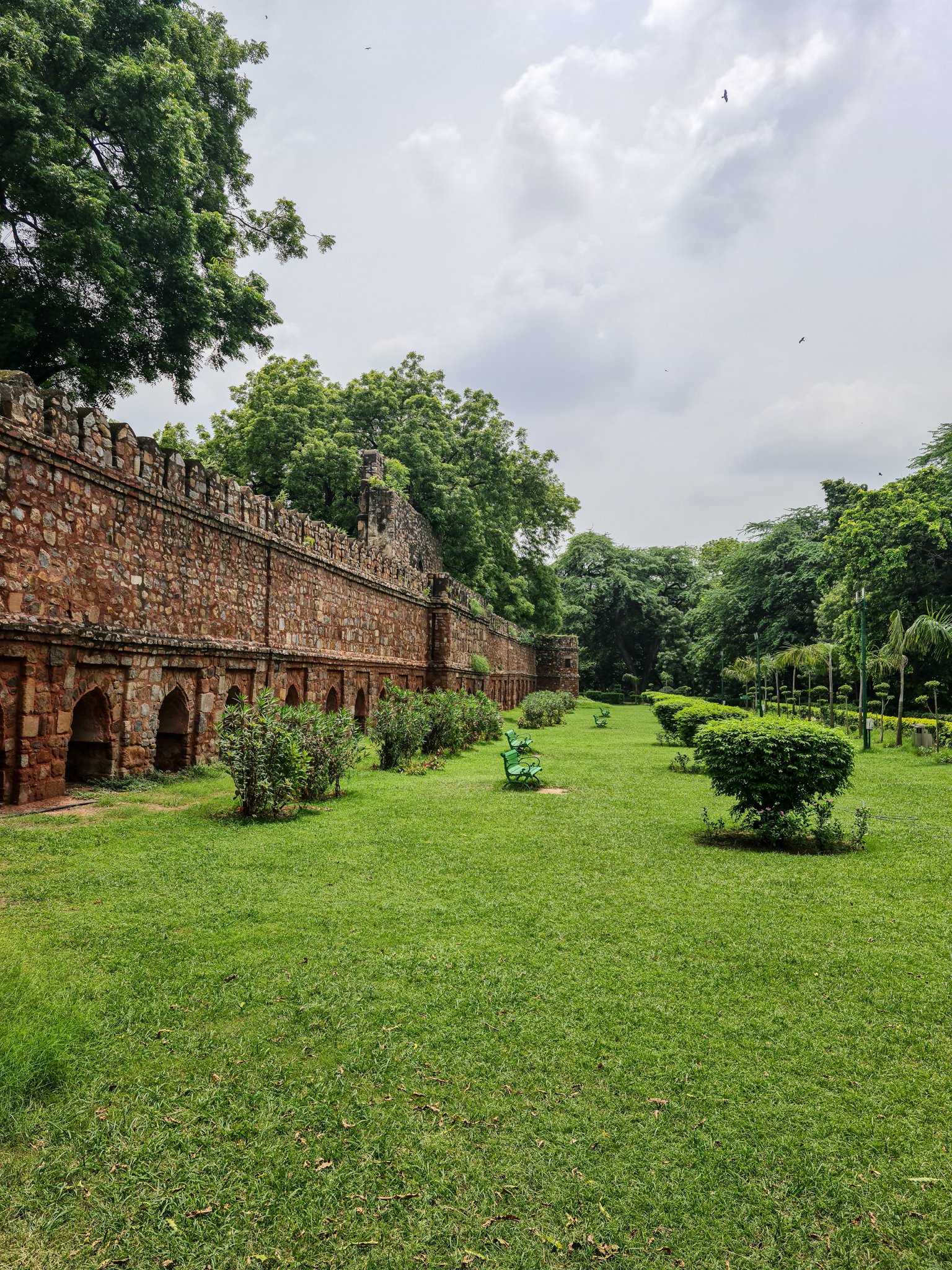



















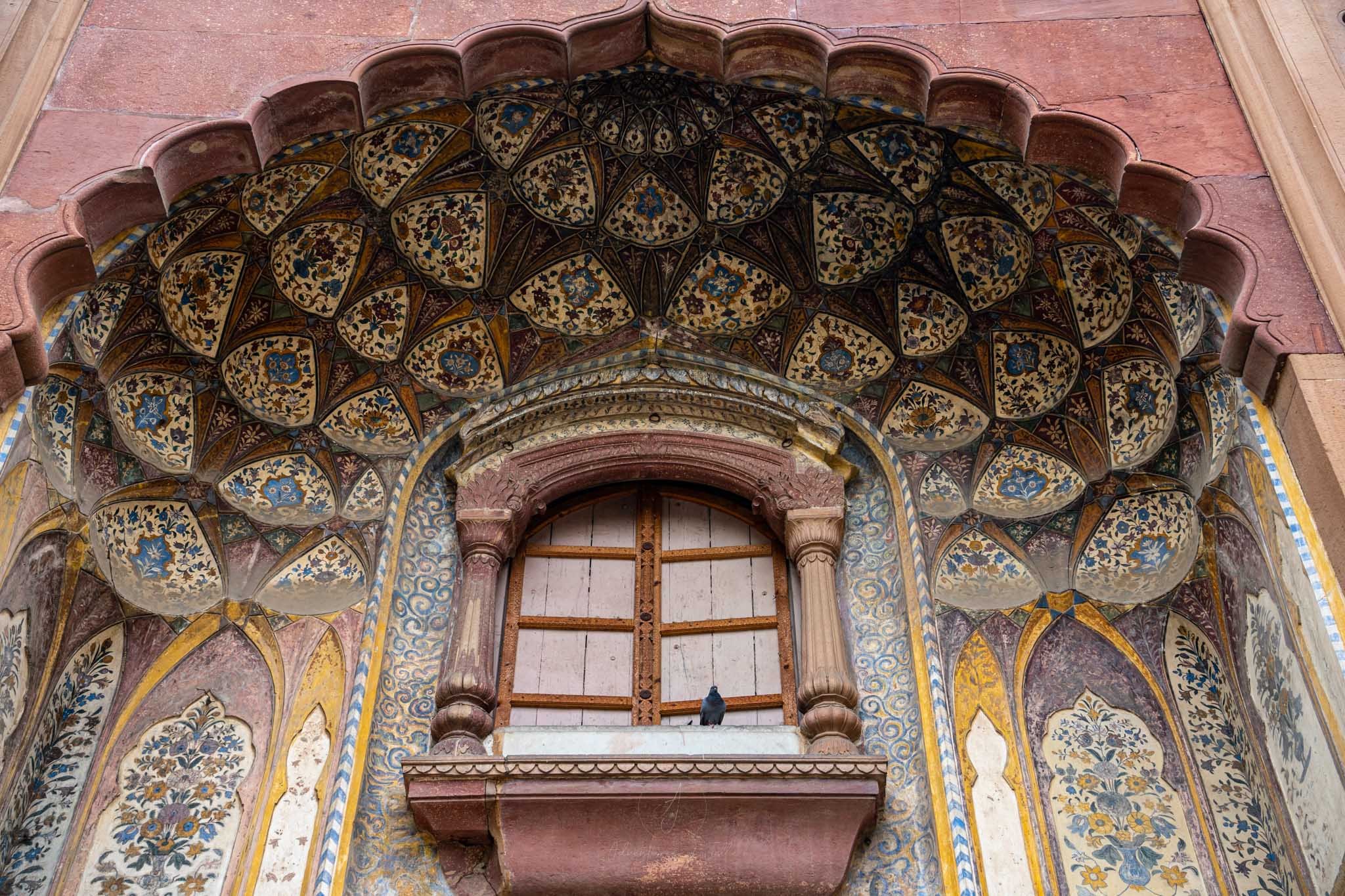























































































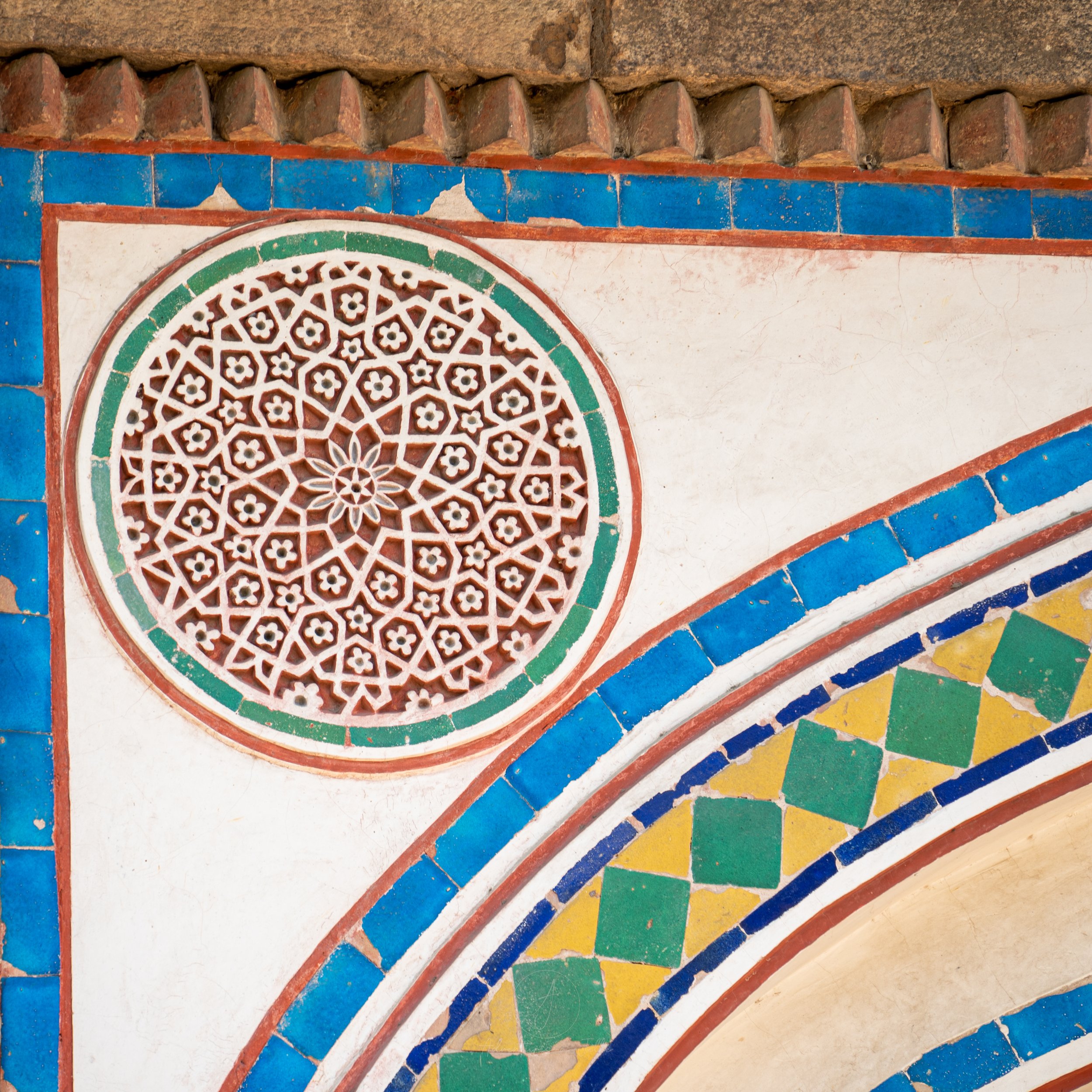

















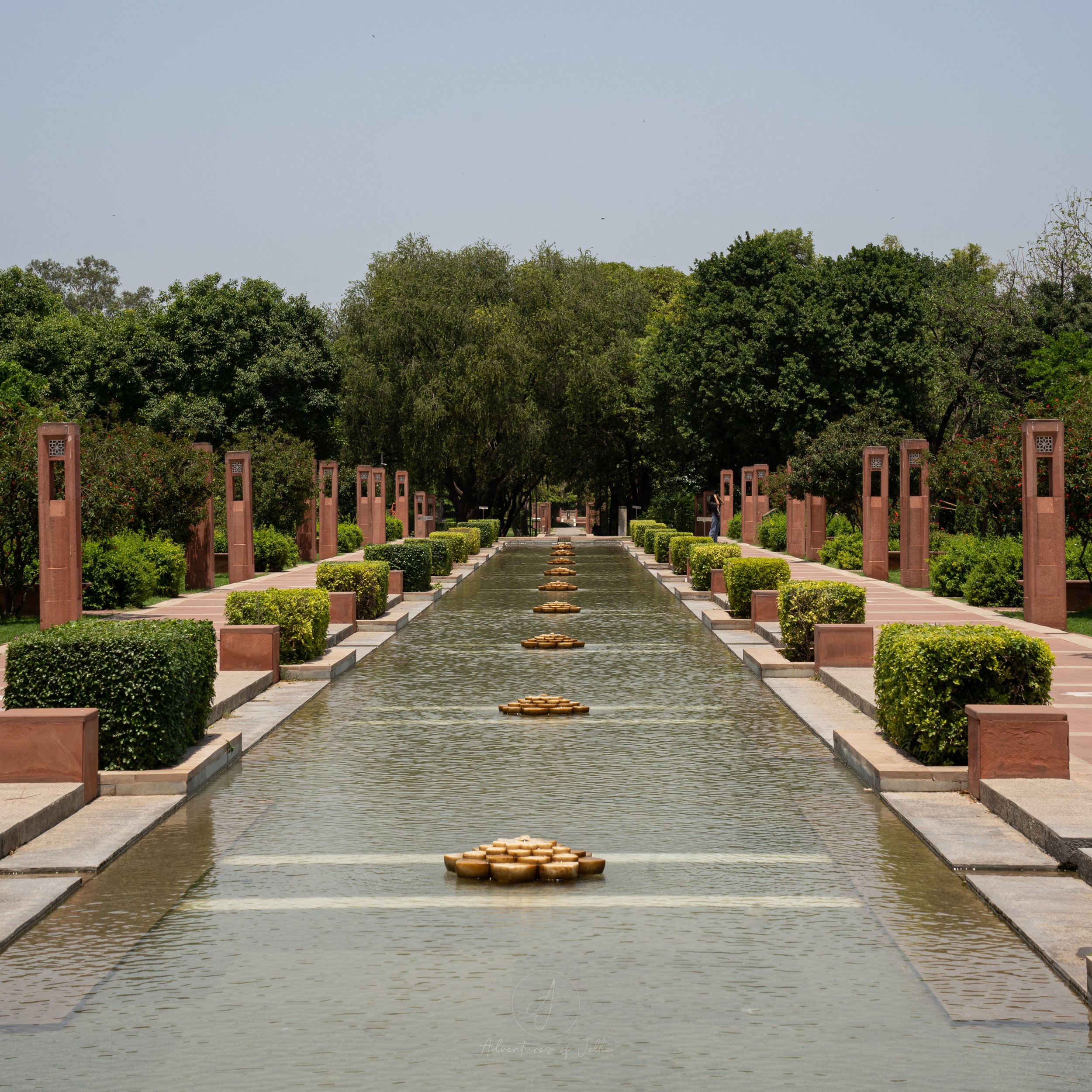
























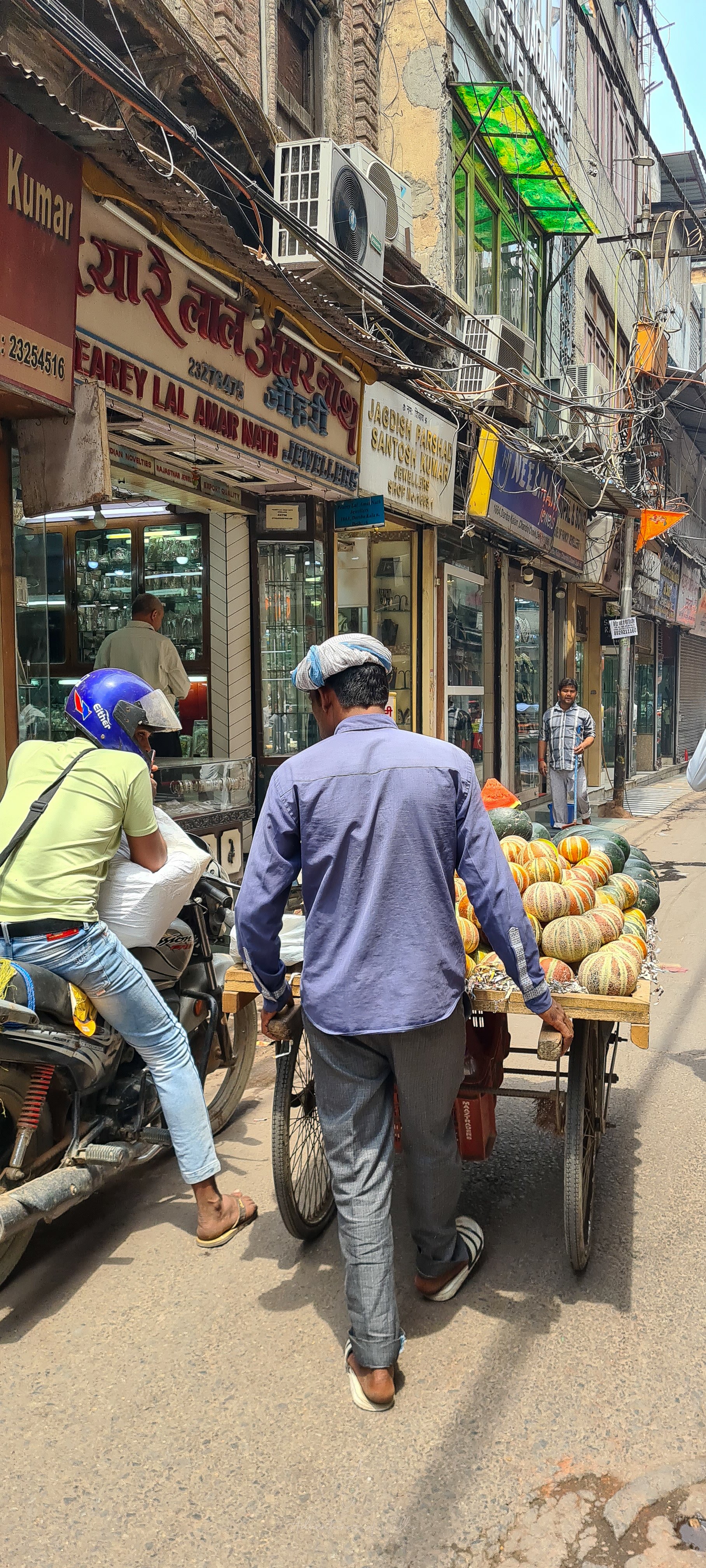
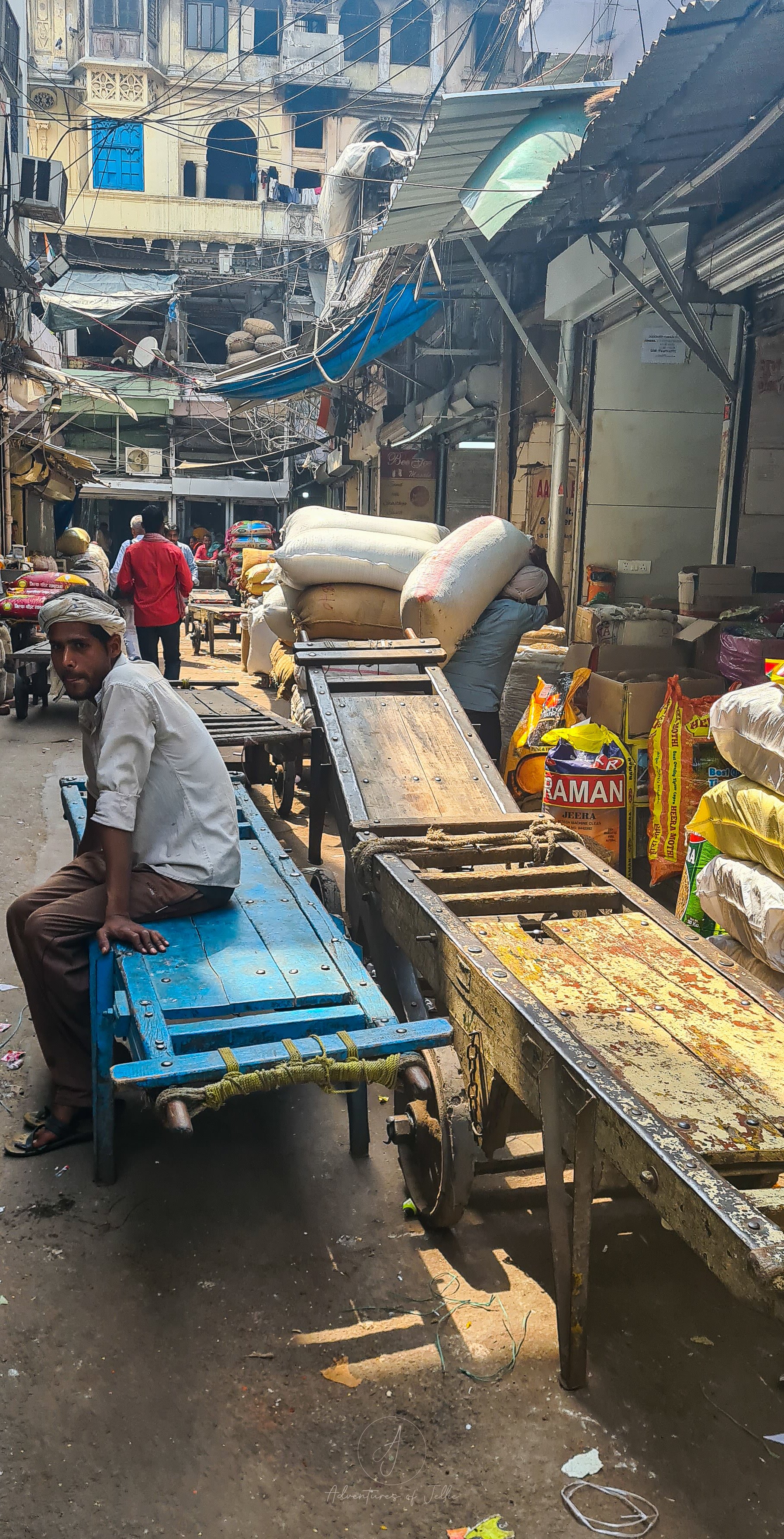








Join us as we walk from the backpacker haven of Ella through lush jungle and green tea fields towards the railway engineering marvel of the Demodara Loop. The Demodara Loop sees a railway line spiral up towards the station, climbing a elevation too steep for regular tracks. Read on for a cheap, interesting day out from Ella, complete with the best spot to selfie snap Sri Lanka’s famous Nine Arch Bridge!